
Preliminary W77E58
8 BIT MICROCONTROLLER
Publication Release Date: March 1999
- 1 -
Revision A1
Table of Contents--
GENERAL DESCRIPTION ..............................................................................................................................2
FEATURES......................................................................................................................................................2
PIN CONFIGURATION ....................................................................................................................................3
PIN DESCRIPTION..........................................................................................................................................4
BLOCK DIAGRAM ...........................................................................................................................................6
FUNCTIONAL DESCRIPTION ........................................................................................................................7
MEMORY ORGANIZATION.............................................................................................................................8
INSTRUCTION ...........................................................................................................................................29
INSTRUCTION TIMING .............................................................................................................................37
POWER MANAGEMENT ..........................................................................................................................46
RESET CONDITIONS................................................................................................................................48
RESET STATE...........................................................................................................................................49
PROGRAMMABLE TIMERS/COUNTERS ....................................................................................................53
TIMED ACCESS PROTECTION ...................................................................................................................70
ON-CHIP MTP ROM CHARACTERISTICS...................................................................................................71
SECURITY BITS ............................................................................................................................................74
ABSOLUTE MAXIMUM RATINGS ................................................................................................................75
DC ELECTRICAL CHARACTERISTICS ......................................................................................................76
AC ELECTRICAL CHARACTERISTICS........................................................................................................77
TYPICAL APPLICATION CIRCUITS .............................................................................................................82
Expanded External Program Memory and Crystal......................................................................................82
Expanded External Data Memory and Oscillator ........................................................................................83
PACKAGE DIMENSIONS..............................................................................................................................83
40-pin DIP...................................................................................................................................................83
44-pin PLCC ...............................................................................................................................................84
44-pin QFP .................................................................................................................................................84

Preliminary W77E58
- 2 -
GENERAL DESCRIPTION
The W77E58 is a fast 8051 compatible microcontroller with a redesigned processor core without
wasted clock and memory cycles. As a result, it executes every 8051 instruction faster than the
original 8051 for the same crystal speed. Typically, the instruction executing time of W77E58 is 1.5 to
3 times faster then that of traditional 8051, depending on the type of instruction. In general, the
overall performance is about 2.5 times better than the original for the same crystal speed. Giving the
same throughput with lower clock speed, power consumption has been improved. Consequently, the
W77E58 is a fully static CMOS design; it can also be operated at a lower crystal clock. The W77E58
contains 32 KB flash Multiple-Time Programmable(MTP) ROM, and provides operating voltage from
4.5V to 5.5V. All W77E58 types also support on-chip 1 KB SRAM without external memory
component and glue logic, saving more I/O pins for users
'
application usage if they use on-chip
SRAM instead of external SRAM.
FEATURES
�
8-bit CMOS microcontroller
�
High speed architecture of 4 clocks/machine cycle runs up to 40 MHz
�
Pin compatible with standard 80C52
�
Instruction-set compatible with MCS-51
�
Four 8-bit I/O Ports
�
One extra 4-bit I/O port and Wait State control signal (available on 44-pin PLCC/QFP package)
�
Three 16-bit Timers
�
12 interrupt sources with two levels of priority
�
On-chip oscillator and clock circuitry
�
Two enhanced full duplex serial ports
�
32 KB flash Multiple-Time Programmable(MTP) ROM
�
256 bytes scratch-pad RAM
�
1 KB on-chip SRAM for MOVX instruction
�
Programmable Watchdog Timer
�
Dual 16-bit Data Pointers
�
Software programmable access cycle to external RAM/peripherals
�
Packages:
-
DIP 40: W77E58-25/40
-
PLCC 44: W77E58P-25/40
-
QFP 44: W77E58F-25/40
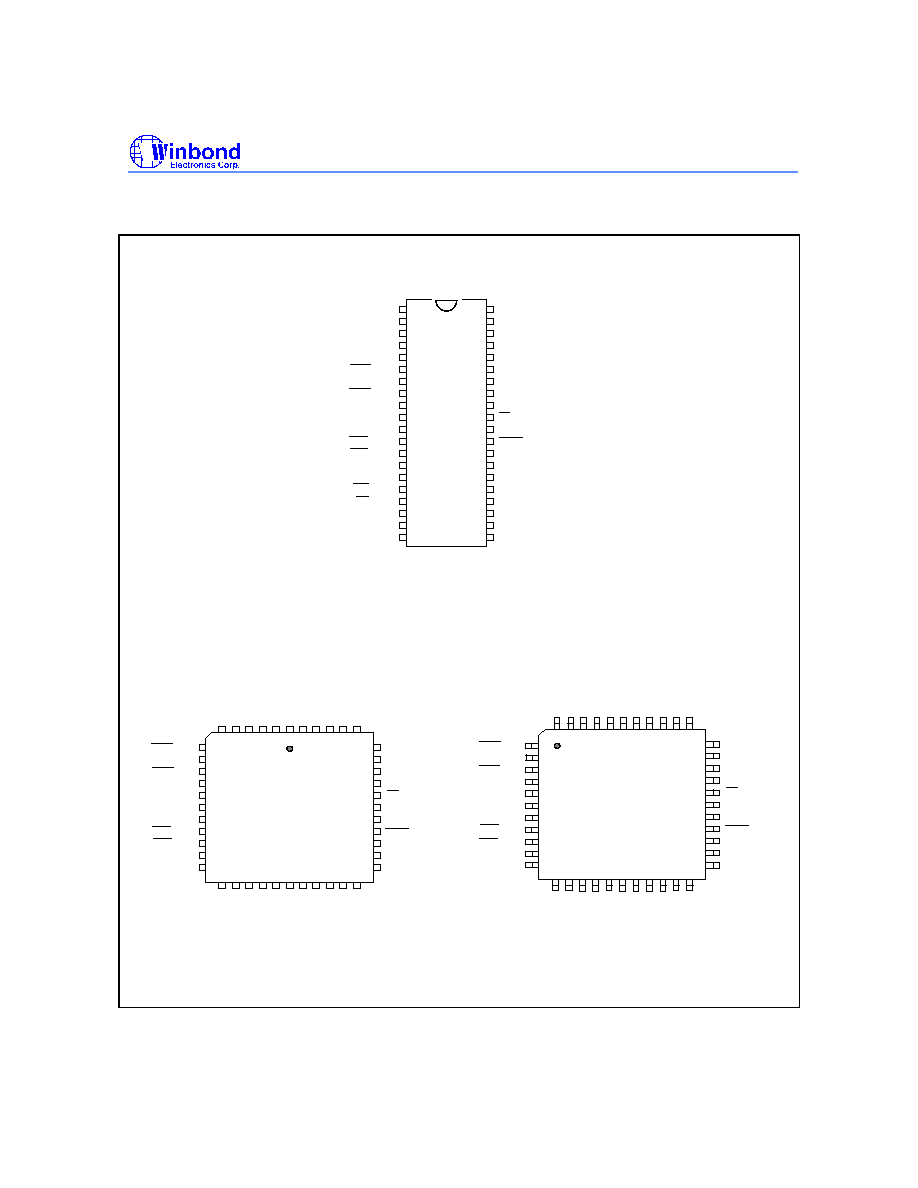
Preliminary W77E58
Publication Release Date: March 1999
- 3 -
Revision A1
PIN CONFIGURATION
VDD
1
2
3
4
5
6
7
8
9
10
11
12
13
14
15
16
17
18
19
20
39
40
34
35
36
37
38
30
31
32
33
26
27
28
29
21
22
23
24
25
P0.0, AD0
P0.1, AD1
P0.2, AD2
P0.3, AD3
P0.4, AD4
P0.5, AD5
P0.6, AD6
P0.7, AD7
EA
ALE
PSEN
P2.5, A13
P2.6, A14
P2.7, A15
P2.0, A8
P2.1, A9
P2.2, A10
P2.3, A11
P2.4, A12
T2, P1.0
40-Pin DIP (W77E58)
RXD1, P1.2
TXD1, P1.3
INT2, P1.4
INT3, P1.5
INT4, P1.6
RXD, P3.0
TXD, P3.1
INT5, P1.7
RST
INT0, P3.2
INT1, P3.3
T0, P3.4
T1, P3.5
WR, P3.6
RD, P3.7
XTAL1
XTAL2
VSS
T2EX, P1.1
44-Pin PLCC (W77E58P)
44-Pin QFP (W77E58F)
34
40 39 38 37 36 35
44 43 42 41
33
32
31
30
29
28
27
26
25
24
23
P0.4, AD4
P0.5, AD5
P0.6, AD6
P0.7, AD7
EA
P4.1
ALE
PSEN
P2.7, A15
P2.6, A14
P2.5, A13
22
21
20
19
18
17
16
15
14
13
12
11
4
3
2
1
8
7
6
5
10
9
INT3, P1.5
INT4, P1.6
INT5, P1.7
RST
RXD, P3.0
P4.3
TXD, P3.1
INT0, P3.2
INT1, P3.3
T0, P3.4
T1, P3.5
X
T
A
L
1
V
S
S
P
2
.
4
,
A
1
2
P
2
.
3
,
A
1
1
P
2
.
2
,
A
1
0
P
2
.
1
,
A
9
P
2
.
0
,
A
8
X
T
A
L
2
P
3
.
7
,
/
R
D
P
3
.
6
,
/
W
R
40
2
1 44 43 42 41
6
5
4
3
39
38
37
36
35
34
33
32
31
30
29
P0.4, AD4
P0.5, AD5
P0.6, AD6
P0.7, AD7
EA
P4.1
ALE
PSEN
P2.7, A15
P2.6, A14
P2.5, A13
28
27
26
25
24
23
22
21
20
19
18
17
10
9
8
7
14
13
12
11
16
15
INT3, P1.5
INT4, P1.6
INT5, P1.7
RST
RXD, P3.0
P4.3
TXD, P3.1
INT0, P3.2
INT1, P3.3
T0, P3.4
T1, P3.5
X
T
A
L
1
V
S
S
P
2
.
4
,
A
1
2
P
2
.
3
,
A
1
1
P
2
.
2
,
A
1
0
P
2
.
1
,
A
9
P
2
.
0
,
A
8
X
T
A
L
2
P
3
.
7
,
/
R
D
P
3
.
6
,
/
W
R
A
D
3
,
P
0
.
3
T
2
,
P
1
.
0
P
1
.
2
V
D
D
A
D
2
,
P
0
.
2
A
D
1
,
P
0
.
1
A
D
0
,
P
0
.
0
T
2
E
X
,
P
1
.
1
P
1
.
3
P
1
.
4
,
X
D
1
R
,
X
D
1
T
A
D
3
,
P
0
.
3
T
2
,
P
1
.
0
P
1
.
2
V
D
D
A
D
2
,
P
0
.
2
A
D
1
,
P
0
.
1
A
D
0
,
P
0
.
0
T
2
E
X
,
P
1
.
1
P
1
.
3
P
1
.
4
,
,
X
X
D
D
1
1
R
T
,
N
T
2
I
,
N
T
2
I
P
4
.
2
P
4
.
2
P
4
.
0
,
/
W
A
I
T
P
4
.
0
,
/
W
A
I
T

Preliminary W77E58
- 4 -
PIN DESCRIPTION
SYMBOL
TYPE
DESCRIPTIONS
EA
I
EXTERNAL ACCESS ENABLE: This pin forces the processor to execute out of
external ROM. It should be kept high to access internal ROM. The ROM
address and data will not be present on the bus if
EA
pin is high and the
program counter is within 32 KB area. Otherwise they will be present on the
bus.
PSEN
O
PROGRAM STORE ENABLE: PSEN enables the external ROM data onto the
Port 0 address/data bus during fetch and MOVC operations. When internal
ROM access is performed, no PSEN strobe signal outputs from this pin.
ALE
O
ADDRESS LATCH ENABLE: ALE is used to enable the address latch that
separates the address from the data on Port 0.
RST
I
RESET: A high on this pin for two machine cycles while the oscillator is running
resets the device.
XTAL1
I
CRYSTAL1: This is the crystal oscillator input. This pin may be driven by an
external clock.
XTAL2
O
CRYSTAL2: This is the crystal oscillator output. It is the inversion of XTAL1.
V
SS
I
GROUND: Ground potential
V
DD
I
POWER SUPPLY: Supply voltage for operation.
P0.0
-
P0.7
I/O
PORT 0: Port 0 is an open-drain bi-directional I/O port. This port also provides
a multiplexed low order address/data bus during accesses to external memory.
P1.0
-
P1.7
I/O
PORT 1: Port 1 is a bi-directional I/O port with internal pull-ups. The bits have
alternate functions which are described below:
T2(P1.0): Timer/Counter 2 external count input
T2EX(P1.1): Timer/Counter 2 Reload/Capture/Direction control
RXD1(P1.2): Serial port 2 RXD
TXD1(P1.3): Serial port 2 TXD
INT2(P1.4): External Interrupt 2
INT3 (P1.5): External Interrupt 3
INT4(P1.6): External Interrupt 4
INT5 (P1.7): External Interrupt 5
P2.0
-
P2.7
I/O
PORT 2: Port 2 is a bi-directional I/O port with internal pull-ups. This port also
provides the upper address bits for accesses to external memory.

Preliminary W77E58
Publication Release Date: March 1999
- 5 -
Revision A1
Pin Description, continued
SYMBOL
TYPE
DESCRIPTIONS
P3.0
-
P3.7
I/O
PORT 3: Port 3 is a bi-directional I/O port with internal pull-ups. All bits have
alternate functions, which are described below:
RXD(P3.0) : Serial Port 0 input
TXD(P3.1) : Serial Port 0 output
INT0 (P3.2) : External Interrupt 0
INT1
(P3.3) : External Interrupt 1
T0(P3.4) : Timer 0 External Input
T1(P3.5) : Timer 1 External Input
WR
(P3.6) : External Data Memory Write Strobe
RD
(P3.7) : External Data Memory Read Strobe
P4.0
-
P4.3
I/O
PORT 4: Port 4 is a 4-bit bi-directional I/O port. The P4.0 also provides the
alternate function
WAIT
which is the wait state control signal.
* Note: TYPE I: input, O: output, I/O: bi-directional.
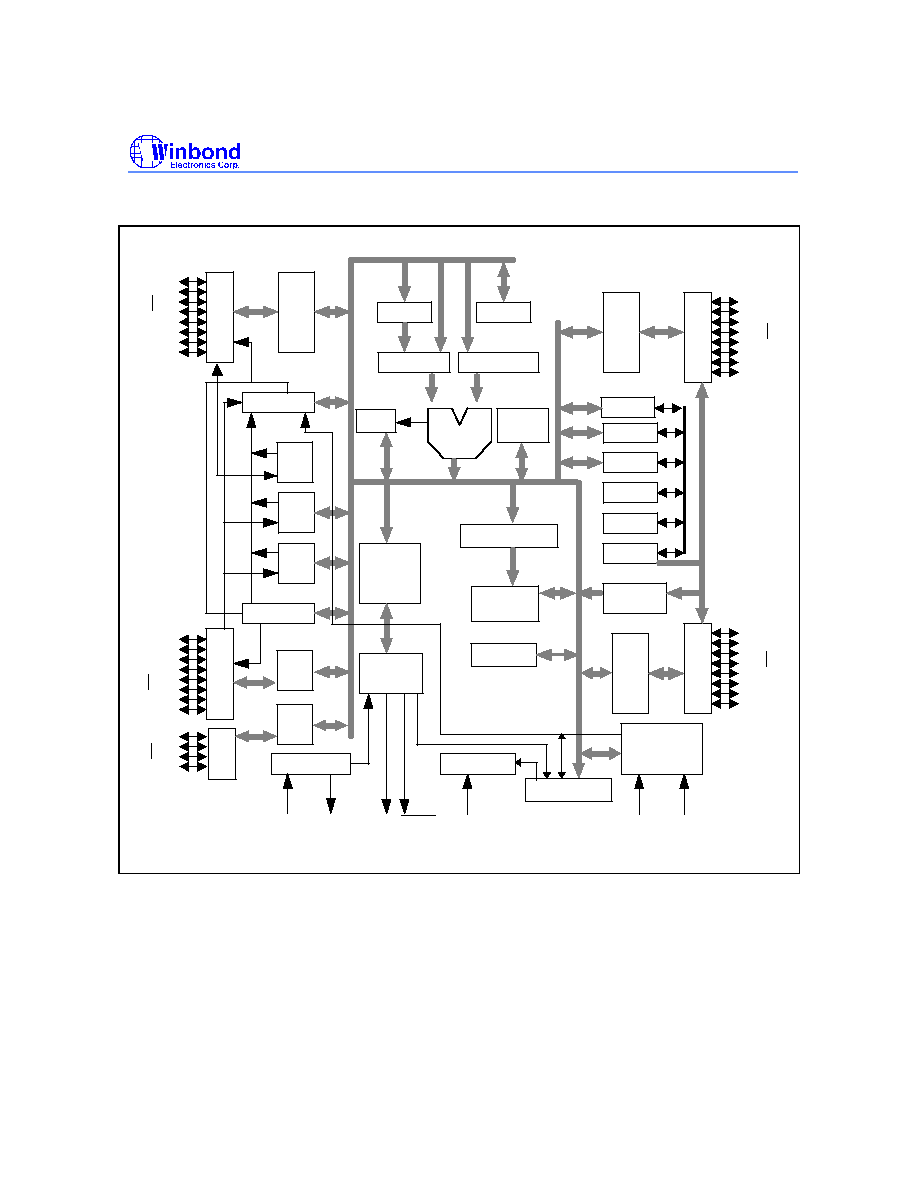
Preliminary W77E58
- 6 -
BLOCK DIAGRAM
Address
Bus
P3.0
P3.7
P1.0
P1.7
ALU
Port 0
Latch
Port 1
Latch
Timer
1
Timer
0
Port
0
Port
1
2 UARTs
XTAL1
PSEN
ALE
GND
V
CC
RST
XTAL2
Oscillator
Interrupt
PSW
Instruction
Decoder
&
Sequencer
Reset Block
Bus & lock
Controller
32KB ROM
SFR RAM Address
Power control
&
Power monitor
256 bytes
RAM & SFR
Stack
Pointer
B
Addr. Reg.
Incrementor
PC
Temp Reg.
DPTR 1
T2 Register
T1 Register
ACC
Port 3
Latch
Port
3
P0.0
P0.7
Port 2
Latch
Port
2
P2.0
P2.7
Timer
2
1KB SRAM
DPTR
Watchdog Timer
Port 4
Latch
Port
4
P4.0
P4.3

Preliminary W77E58
Publication Release Date: March 1999
- 7 -
Revision A1
FUNCTIONAL DESCRIPTION
The W77E58 is 8052 pin compatible and instruction set compatible. It includes the resources of the
standard 8052 such as four 8-bit I/O Ports, three 16-bit timer/counters, full duplex serial port and
interrupt sources.
The W77E58 features a faster running and better performance 8-bit CPU with a redesigned core
processor without wasted clock and memory cycles. it improves the performance not just by running
at high frequency but also by reducing the machine cycle duration from the standard 8052 period of
twelve clocks to four clock cycles for the majority of instructions. This improves performance by an
average of 1.5 to 3 times. The W77E58 also provides dual Data Pointers (DPTRs) to speed up block
data memory transfers. It can also adjust the duration of the MOVX instruction (access to off-chip
data memory) between two machine cycles and nine machine cycles. This flexibility allows the
W77E58 to work efficiently with both fast and slow RAMs and peripheral devices. In addition, the
W77E58 contains on-chip 1KB MOVX SRAM, the address of which is between 0000H and 03FFH. It
only can be accessed by MOVX instruction; this on-chip SRAM is optional under software control.
The W77E58 is an 8052 compatible device that gives the user the features of the original 8052
device, but with improved speed and power consumption characteristics. It has the same instruction
set as the 8051 family, with one addition: DEC DPTR (op-code A5H, the DPTR is decreased by 1).
While the original 8051 family was designed to operate at 12 clock periods per machine cycle, the
W77E58 operates at a much reduced clock rate of only 4 clock periods per machine cycle. This
naturally speeds up the execution of instructions. Consequently, the W77E58 can run at a higher
speed as compared to the original 8052, even if the same crystal is used. Since the W77E58 is a fully
static CMOS design, it can also be operated at a lower crystal clock, giving the same throughput in
terms of instruction execution, yet reducing the power consumption.
The 4 clocks per machine cycle feature in the W77E58 is responsible for a three-fold increase in
execution speed. The W77E58 has all the standard features of the 8052, and has a few extra
peripherals and features as well.
I/O Ports:
The W77E58 has four 8-bit ports and one extra 4-bit port. Port 0 can be used as an Address/Data bus
when external program is running or external memory/device is accessed by MOVC or MOVX
instruction. In these cases, it has strong pull-ups and pull-downs, and does not need any external pull-
ups. Otherwise it can be used as a general I/O port with open-drain circuit. Port 2 is used chiefly as
the upper 8-bits of the Address bus when port 0 is used as an address/data bus. It also has strong
pull-ups and pull-downs when it serves as an address bus. Port 1 and 3 act as I/O ports with alternate
functions. Port 4 is only available on 44-pin PLCC/QFP package type. It serves as a general purpose
I/O port as Port 1 and Port 3. The P4.0 has an alternate function
WAIT
which is the wait state control
signal. When wait state control signal is enabled, P4.0 is input only.
Serial I/O:
The W77E58 has two enhanced serial ports that are functionally similar to the serial port of the
original 8052 family. However the serial ports on the W77E58 can operate in different modes in order
to obtain timing similarity as well. Note that the serial port 0 can use Timer 1 or 2 as baud rate
generator, but the serial port 1 can only use Timer 1 as baud rate generator. The serial ports
have the enhanced features of Automatic Address recognition and Frame Error detection.

Preliminary W77E58
- 8 -
Timers:
The W77E58 has three 16-bit timers that are functionally similar to the timers of the 8052 family.
When used as timers, they can be set to run at either 4 clocks or 12 clocks per count, thus providing
the user with the option of operating in a mode that emulates the timing of the original 8052. The
W77E58 has an additional feature, the watchdog timer. This timer is used as a System Monitor or as
a very long time period timer.
Interrupts:
The Interrupt structure in the W77E58 is slightly different from that of the standard 8052. Due to the
presence of additional features and peripherals, the number of interrupt sources and vectors has been
increased. The W77E58 provides 12 interrupt resources with two priority level, including six external
interrupt sources, timer interrupts, serial I/O interrupts.
Data Pointers:
The original 8052 had only one 16-bit Data Pointer (DPL, DPH). In the W77E58, there is an additional
16-bit Data Pointer (DPL1, DPH1). This new Data Pointer uses two SFR locations which were unused
in the original 8052. In addition there is an added instruction, DEC DPTR (op-code A5H), which helps
in improving programming flexibility for the user.
Power Management:
Like the standard 80C52, the W77E58 also has IDLE and POWER DOWN modes of operation. The
W77E58 provides a new Economy mode which allow user to switch the internal clock rate divided by
either 4, 64 or 1024. In the IDLE mode, the clock to the CPU core is stopped while the timers, serial
ports and interrupts clock continue to operate. In the POWER DOWN mode, all the clock are stopped
and the chip operation is completely stopped. This is the lowest power consumption state.
On-chip Data SRAM:
The W77E58 has 1K Bytes of data space SRAM which is read/write accessible and is memory
mapped. This on-chip MOVX SRAM is reached by the MOVX instruction. It is not used for executable
program memory. There is no conflict or overlap among the 256 bytes Scratchpad RAM and the 1K
Bytes MOVX SRAM as they use different addressing modes and separate instructions. The on-chip
MOVX SRAM is enabled by setting the DME0 bit in the PMR register. After a reset, the DME0 bit is
cleared such that the on-chip MOVX SRAM is disabled, and all data memory spaces 0000H
-
FFFFH
access to the external memory.
MEMORY ORGANIZATION
The W77E58 separates the memory into two separate sections, the Program Memory and the Data
Memory. The Program Memory is used to store the instruction op-codes, while the Data Memory is
used to store data or for memory mapped devices.
Program Memory:
The Program Memory on the W77E58 can be up to 64 Kbytes long. There is also on-chip ROM which
can be used similarly to that of the 8052, except that the ROM size is 32 Kbytes. All instructions are
fetched for execution from this memory area. The MOVC instruction can also access this memory
region. Exceeding the maximum address of on-chip ROM will access the external memory.
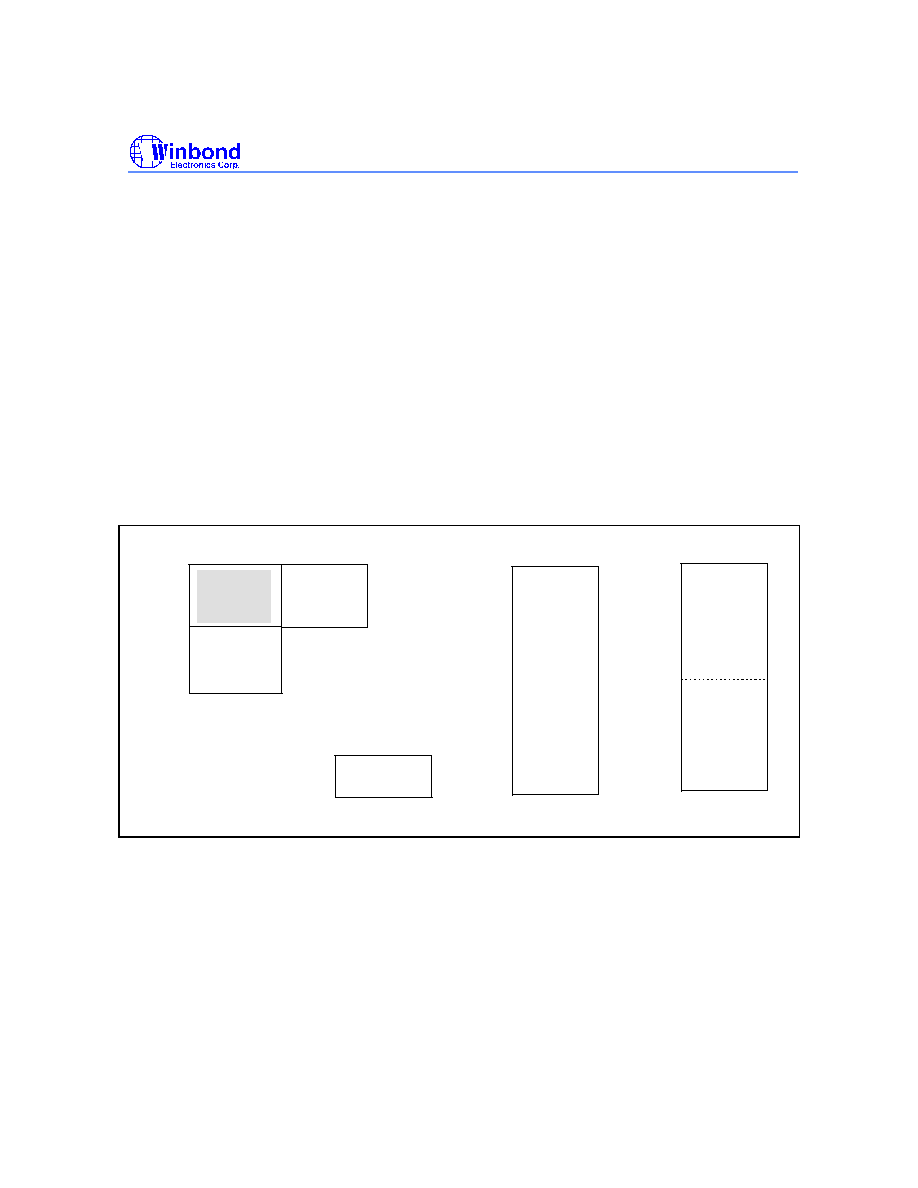
Preliminary W77E58
Publication Release Date: March 1999
- 9 -
Revision A1
Data Memory:
The W77E58 can access up to 64Kbytes of external Data Memory. This memory region is accessed
by the MOVX instructions. Unlike the 8051 derivatives, the W77E58 contains on-chip 1K bytes MOVX
SRAM of Data Memory, which can only be accessed by MOVX instructions. These 1K bytes of SRAM
are between address 0000H and 03FFH. Access to the on-chip MOVX SRAM is optional under
software control. When enabled by software, any MOVX instruction that uses this area will go to the
on-chip RAM. MOVX addresses greater than 03FFH automatically go to external memory through
Port 0 and 2. When disabled, the 1KB memory area is transparent to the system memory map. Any
MOVX directed to the space between 0000H and FFFFH goes to the expanded bus on Port 0 and 2.
This is the default condition. In addition, the W77E58 has the standard 256 bytes of on-chip
Scratchpad RAM. This can be accessed either by direct addressing or by indirect addressing. There
are also some Special Function Registers (SFRs), which can only be accessed by direct addressing.
Since the Scratchpad RAM is only 256 bytes, it can be used only when data contents are small. In the
event that larger data contents are present, two selections can be used. One is on-chip MOVX SRAM
, the other is the external Data Memory. The on-chip MOVX SRAM can only be accessed by a MOVX
instruction, the same as that for external Data Memory. However, the on-chip RAM has the fastest
access times.
0000h
FFFFh
80h
7Fh
00h
64 K
Bytes
External
Data
Memory
Indirect
Addressing
RAM
Direct &
Indirect
Addressing
RAM
SFRs
Direct
Addressing
FFh
FFFFh
0000h
External
Program
Memory
7FFFh
32K Bytes
On-chip
Program
Memory
1K Bytes
On-chip SRAM
0000h
03FFh
Figure 1. Memory Map
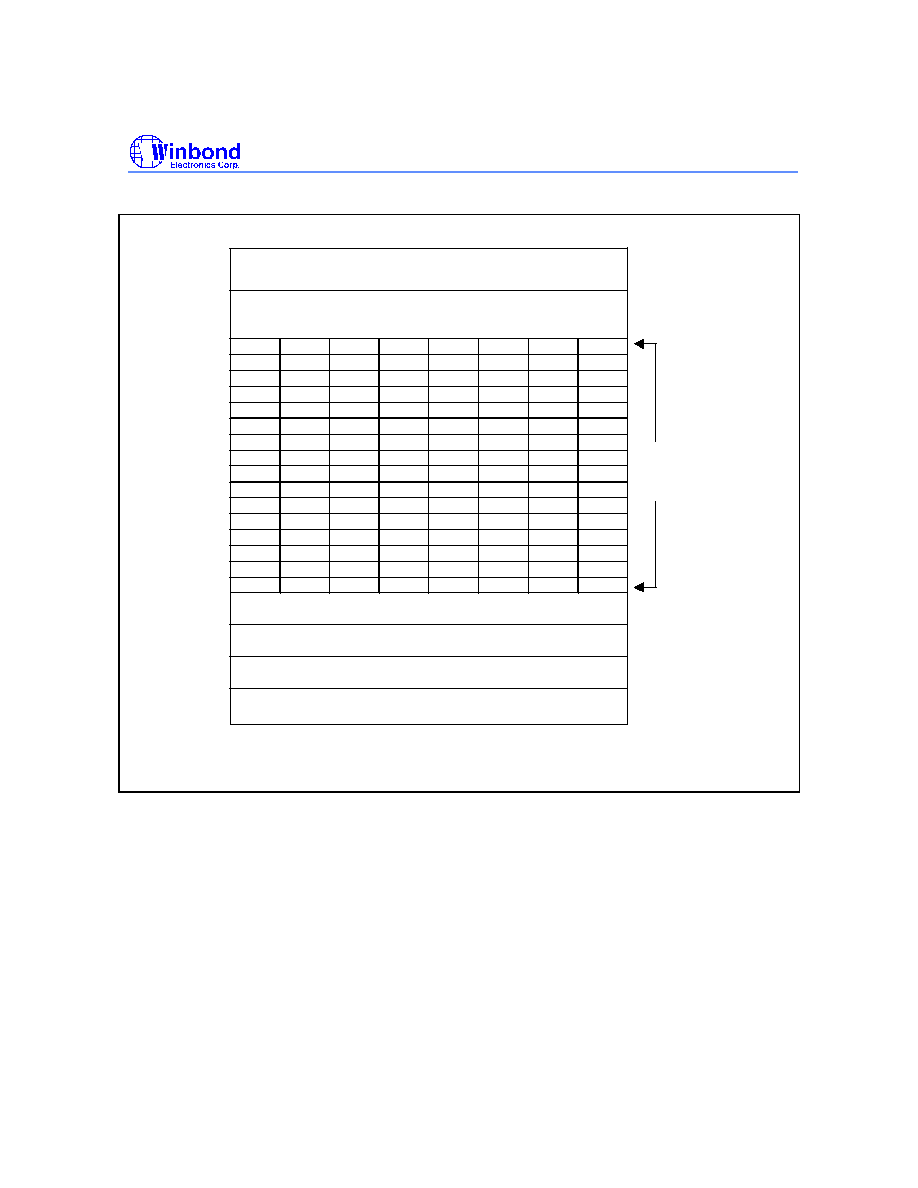
Preliminary W77E58
- 10 -
FFh
80h
7Fh
30h
2Fh
2Eh
2Dh
2Ch
2Bh
2Ah
29h
28h
27h
26h
25h
24h
23h
22h
21h
20h
1Fh
18h
17h
10h
0Fh
08h
07h
00h
78
79
7A
7B
7C
7D
7E
7F
70
71
72
73
74
75
76
77
68
69
6A
6B
6C
6D
6E
6F
60
61
62
63
64
65
66
67
58
59
5A
5B
5C
50
51
52
53
54
5D
5E
5F
55
56
57
48
49
4A
4B
4C
4D
4E
4F
40
41
42
43
44
45
46
47
38
39
3A
3B
3C
3D
3E
3F
30
31
32
33
34
35
36
37
28
29
2A
2B
2C
2D
2E
2F
20
21
22
23
24
25
26
27
18
19
1A
1B
1C
1D
1E
1F
10
11
12
13
14
15
16
17
08
09
0A
0B
0C
0D
0E
0F
00
01
02
03
04
05
06
07
Indirect RAM
Direct RAM
Bank 3
Bank 2
Bank 1
Bank 0
Bit Addressable
20H
-
2FH
Figure 2. Scratchpad RAM/Register Addressing
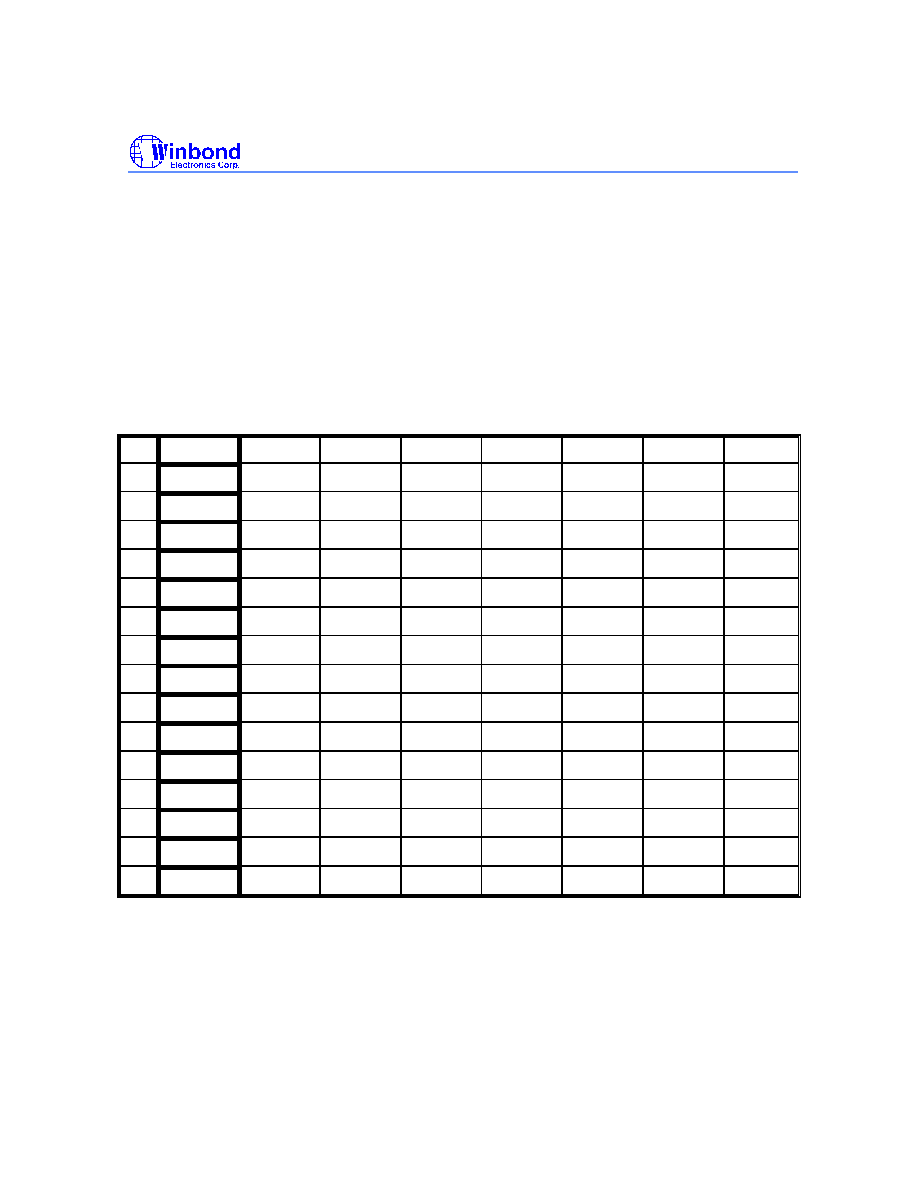
Preliminary W77E58
Publication Release Date: March 1999
- 11 - Revision A1
Special Function Registers
The W77E58 uses Special Function Registers (SFRs) to control and monitor peripherals and their
Modes.
The SFRs reside in the register locations 80-FFh and are accessed by direct addressing only. Some
of the SFRs are bit addressable. This is very useful in cases where one wishes to modify a particular
bit without changing the others. The SFRs that are bit addressable are those whose addresses end in
0 or 8. The W77E58 contains all the SFRs present in the standard 8052. However, some additional
SFRs have been added. In some cases unused bits in the original 8052 have been given new
functions. The list of SFRs is as follows. The table is condensed with eight locations per row. Empty
locations indicate that there are no registers at these addresses. When a bit or register is not
implemented, it will read high.
Table 1. Special Function Register Location Table
F8
EIP
F0
B
E8
EIE
E0
ACC
D8
WDCON
D0
PSW
C8
T2CON
T2MOD
RCAP2L
RCAP2H
TL2
TH2
C0
SCON1
SBUF1
ROMMAP
PMR
STATUS
TA
B8
IP
SADEN
SADEN1
B0
P3
A8
IE
SADDR
SADDR1
A0
P2
P4
98
SCON0
SBUF
90
P1
EXIF
88
TCON
TMOD
TL0
TL1
TH0
TH1
CKCON
80
P0
SP
DPL
DPH
DPL1
DPH1
DPS
PCON
Note: The SFRs in the column with dark borders are bit-addressable.
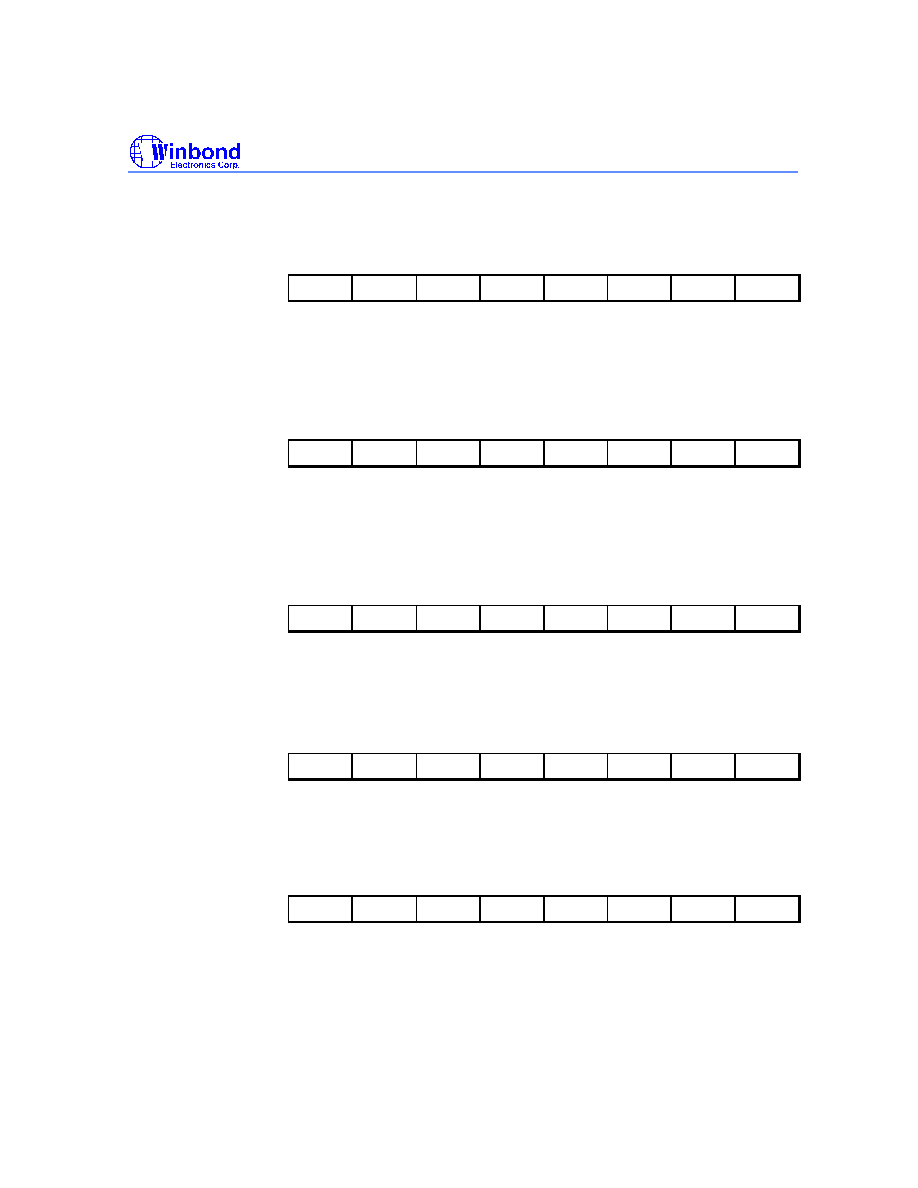
Preliminary W77E58
- 12 -
A brief description of the SFRs now follows.
PORT 0
Bit:
7
6
5
4
3
2
1
0
P0.7
P0.6
P0.5
P0.4
P0.3
P0.2
P0.1
P0.0
Mnemonic: P0
Address: 80h
Port 0 is an open-drain bi-directional I/O port. This port also provides a multiplexed low order
address/data bus during accesses to external memory.
STACK POINTER
Bit:
7
6
5
4
3
2
1
0
SP.7
SP.6
SP.5
SP.4
SP.3
SP.2
SP.1
SP.0
Mnemonic: SP
Address: 81h
The Stack Pointer stores the Scratchpad RAM address where the stack begins. In other words, it
always points to the top of the stack.
DATA POINTER LOW
Bit:
7
6
5
4
3
2
1
0
DPL.7
DPL.6
DPL.5
DPL.4
DPL.3
DPL.2
DPL.1
DPL.0
Mnemonic: DPL
Address: 82h
This is the low byte of the standard 8052 16-bit data pointer.
DATA POINTER HIGH
Bit:
7
6
5
4
3
2
1
0
DPH.7
DPH.6
DPH.5
DPH.4
DPH.3
DPH.2
DPH.1
DPH.0
Mnemonic: DPH
Address: 83h
This is the high byte of the standard 8052 16-bit data pointer.
DATA POINTER LOW1
Bit:
7
6
5
4
3
2
1
0
DPL1.7 DPL1.6 DPL1.5 DPL1.4 DPL1.3 DPL1.2 DPL1.1 DPL1.0
Mnemonic: DPL1
Address: 84h
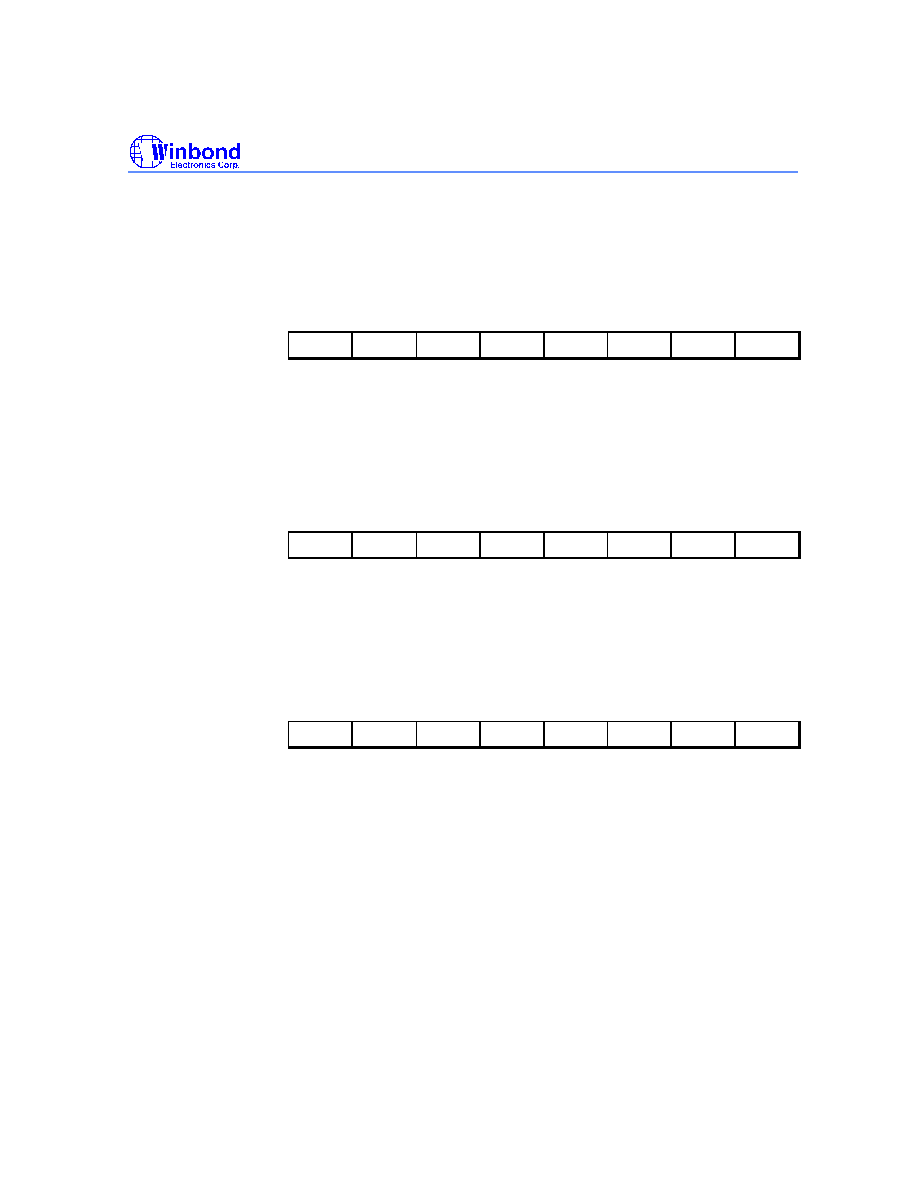
Preliminary W77E58
Publication Release Date: March 1999
- 13 - Revision A1
This is the low byte of the new additional 16-bit data pointer that has been added to the W77E58. The
user can switch between DPL, DPH and DPL1, DPH1 simply by setting register DPS = 1. The
instructions that use DPTR will now access DPL1 and DPH1 in place of DPL and DPH. If they are not
required they can be used as conventional register locations by the user.
DATA POINTER HIGH1
Bit:
7
6
5
4
3
2
1
0
DPH1.7 DPH1.6 DPH1.5 DPH1.4 DPH1.3 DPH1.2 DPH1.1 DPH1.0
Mnemonic: DPH1
Address: 85h
This is the high byte of the new additional 16-bit data pointer that has been added to the W77E58.
The user can switch between DPL, DPH and DPL1, DPH1 simply by setting register DPS = 1. The
instructions that use DPTR will now access DPL1 and DPH1 in place of DPL and DPH. If they are not
required they can be used as conventional register locations by the user.
DATA POINTER SELECT
Bit:
7
6
5
4
3
2
1
0
-
-
-
-
-
-
-
DPS.0
Mnemonic: DPS
Address: 86h
DPS.0: This bit is used to select either the DPL,DPH pair or the DPL1,DPH1 pair as the active Data
Pointer. When set to 1, DPL1, DPH1 will be selected, otherwise DPL,DPH will be selected.
DPS.1-7:These bits are reserved, but will read 0.
POWER CONTROL
Bit:
7
6
5
4
3
2
1
0
SM0D
SMOD0
-
-
GF1
GF0
PD
IDL
Mnemonic: PCON
Address: 87h
SMOD : This bit doubles the serial port baud rate in mode 1, 2, and 3 when set to 1.
SMOD0: Framing Error Detection Enable: When SMOD0 is set to 1, then SCON.7(SCON1.7)
indicates a Frame Error and acts as the FE(FE_1) flag. When SMOD0 is 0, then
SCON.7(SCON1.7) acts as per the standard 8052 function.
GF1-0: These two bits are general purpose user flags.
PD:
Setting this bit causes the W77E58 to go into the POWER DOWN mode. In this mode all the
clocks are stopped and program execution is frozen.
IDL:
Setting this bit causes the W77E58 to go into the IDLE mode. In this mode the clocks to the
CPU are stopped, so program execution is frozen. But the clock to the serial, timer and
interrupt blocks is not stopped, and these blocks continue operating.
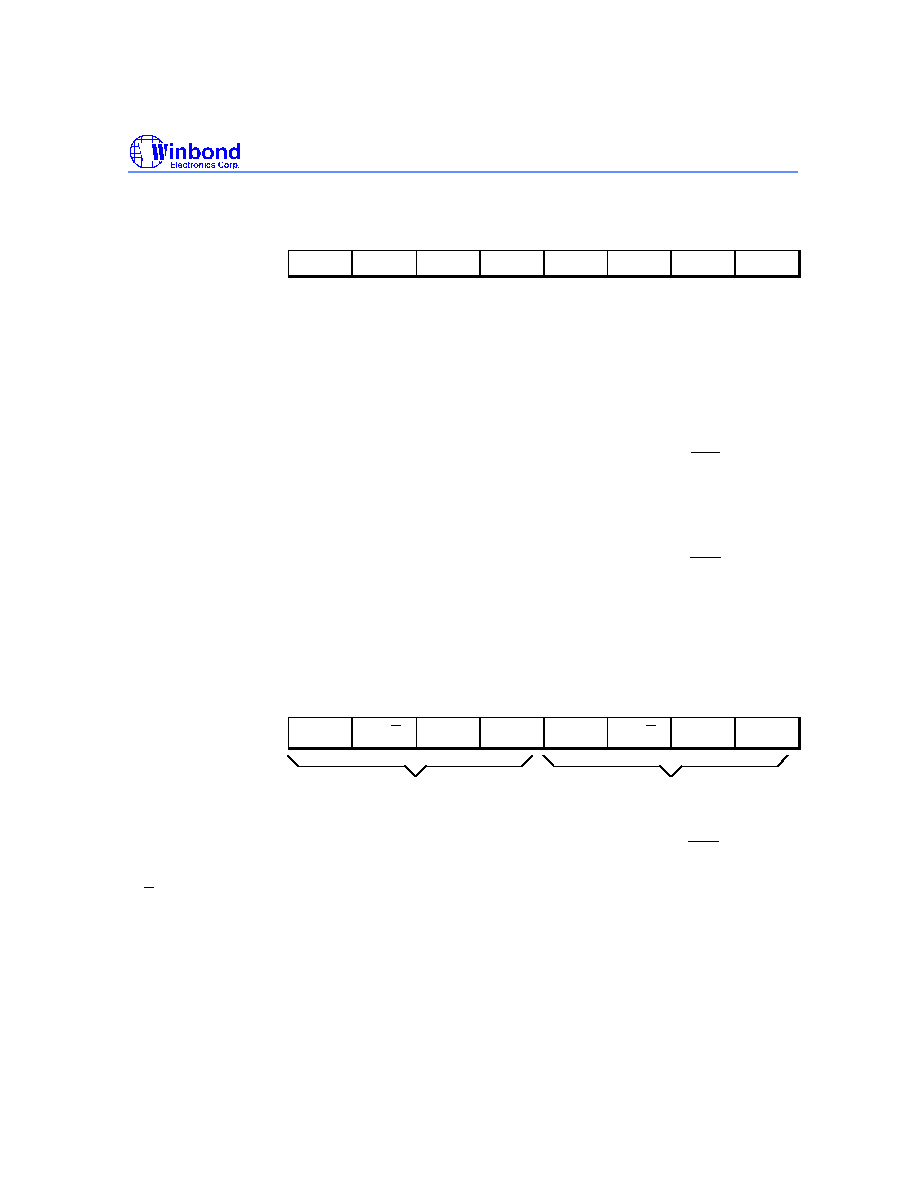
Preliminary W77E58
- 14 -
TIMER CONTROL
Bit:
7
6
5
4
3
2
1
0
TF1
TR1
TF0
TR0
IE1
IT1
IE0
IT0
Mnemonic: TCON
Address: 88h
TF1:
Timer 1 overflow flag: This bit is set when Timer 1 overflows. It is cleared automatically when
the program does a timer 1 interrupt service routine. Software can also set or clear this bit.
TR1:
Timer 1 run control: This bit is set or cleared by software to turn timer/counter on or off.
TF0:
Timer 0 overflow flag: This bit is set when Timer 0 overflows. It is cleared automatically when
the program does a timer 0 interrupt service routine. Software can also set or clear this bit.
TR0:
Timer 0 run control: This bit is set or cleared by software to turn timer/counter on or off.
IE1:
Interrupt 1 edge detect: Set by hardware when an edge/level is detected on
INT1
. This bit is
cleared by hardware when the service routine is vectored to only if the interrupt was edge
triggered. Otherwise it follows the pin.
IT1:
Interrupt 1 type control: Set/cleared by software to specify falling edge/ low level triggered
external inputs.
IE0:
Interrupt 0 edge detect: Set by hardware when an edge/level is detected on INT0 . This bit is
cleared by hardware when the service routine is vectored to only if the interrupt was edge
triggered. Otherwise it follows the pin.
IT0:
Interrupt 0 type control: Set/cleared by software to specify falling edge/ low level triggered
external inputs.
TIMER MODE CONTROL
Bit:
7
6
5
4
3
2
1
0
GATE
C T
/
M1
M0
GATE
C T
/
M1
M0
TIMER1
TIMER0
Mnemonic: TMOD
Address: 89h
GATE: Gating control: When this bit is set, Timer/counter x is enabled only while
INTx
pin is high
and TRx control bit is set. When cleared, Timer x is enabled whenever TRx control bit is set.
C T
/
: Timer or Counter Select: When cleared, the timer is incremented by internal clocks. When set
, the timer counts high-to-low edges of the Tx pin.
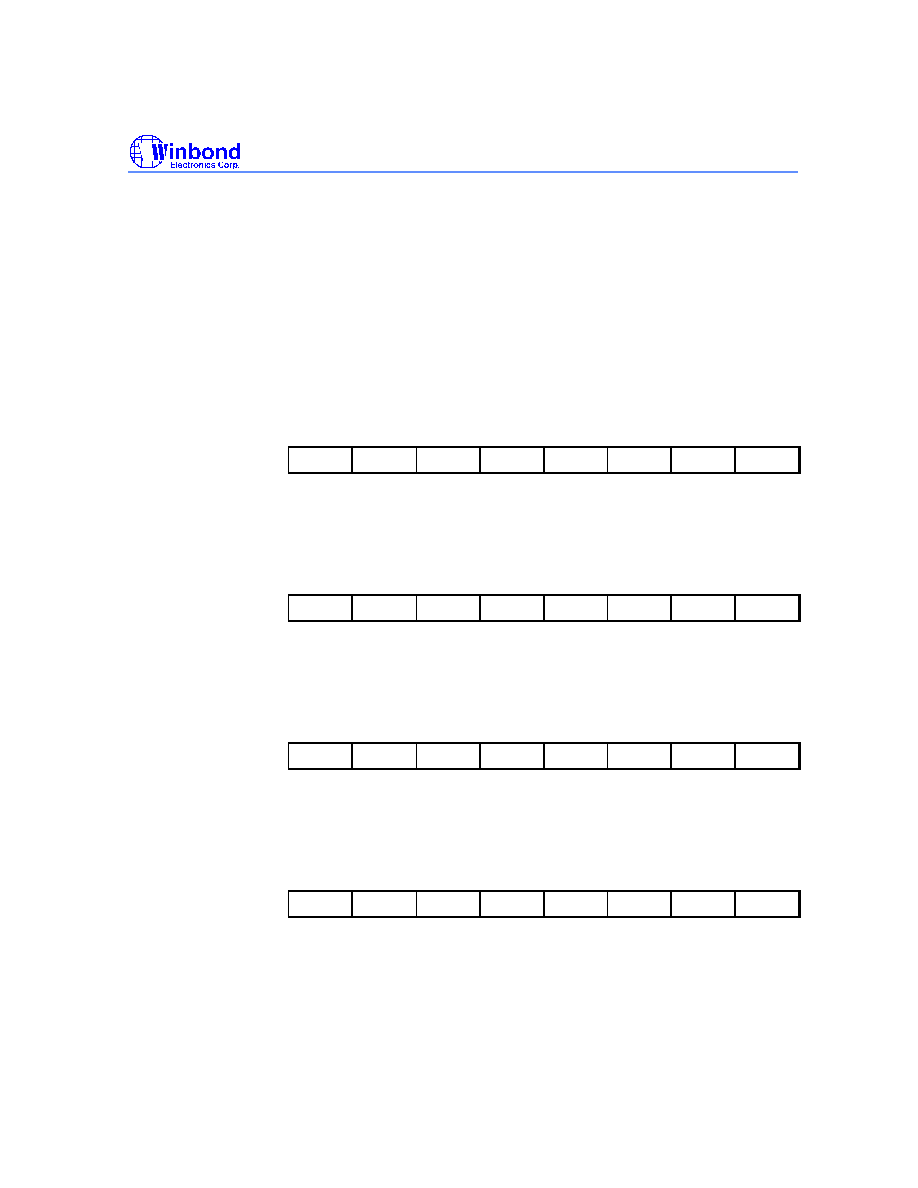
Preliminary W77E58
Publication Release Date: March 1999
- 15 - Revision A1
M1, M0: Mode Select bits:
M1
M0
Mode
0
0
Mode 0: 8-bits with 5-bit prescale.
0
1
Mode 1: 18-bits, no prescale.
1
0
Mode 2: 8-bits with auto-reload from THx
1
1
Mode 3: (Timer 0) TL0 is an 8-bit timer/counter controlled by the standard Timer 0
control bits. TH0 is a 8-bit timer only controlled by Timer 1 control bits. (Timer 1)
Timer/counter is stopped.
TIMER 0 LSB
Bit:
7
6
5
4
3
2
1
0
TL0.7
TL0.6
TL0.5
TL0.4
TL0.3
TL0.2
TL0.1
TL0.0
Mnemonic: TL0
Address: 8Ah
TL0.7-0:Timer 0 LSB
TIMER 1 LSB
Bit:
7
6
5
4
3
2
1
0
TL1.7
TL1.6
TL1.5
TL1.4
TL1.3
TL1.2
TL1.1
TL1.0
Mnemonic: TL1
Address: 8Bh
TL1.7-0:Timer 1 LSB
TIMER 0 MSB
Bit:
7
6
5
4
3
2
1
0
TH0.7
TH0.6
TH0.5
TH0.4
TH0.3
TH0.2
TH0.1
TH0.0
Mnemonic: TH0
Address: 8Ch
TH0.7-0:Timer 0 MSB
TIMER 1 MSB
Bit:
7
6
5
4
3
2
1
0
TH1.7
TH1.6
TH1.5
TH1.4
TH1.3
TH1.2
TH1.1
TH1.0
Mnemonic: TH1
Address: 8Dh
TH1.7-0:Timer 1 MSB

Preliminary W77E58
- 16 -
CLOCK CONTROL
Bit:
7
6
5
4
3
2
1
0
WD1
WD0
T2M
T1M
T0M
MD2
MD1
MD0
Mnemonic: CKCON
Address: 8Eh
WD1-0: Watchdog timer mode select bits: These bits determine the time-out period for the watchdog
timer. In all four time-out options the reset time-out is 512 clocks more than the interrupt time-
out period.
WD1
WD0
Interrupt time-out
Reset time-out
0
0
2
17
2
17
+ 512
0
1
2
20
2
20
+ 512
1
0
2
23
2
23
+ 512
1
1
2
26
2
26
+ 512
T2M:
Timer 2 clock select: When T2M is set to 1, timer 2 uses a divide by 4 clock, and when set to
0 it uses a divide by 12 clock.
T1M:
Timer 1 clock select: When T1M is set to 1, timer 1 uses a divide by 4 clock, and when set to
0 it uses a divide by 12 clock.
T0M:
Timer 0 clock select: When T0M is set to 1, timer 0 uses a divide by 4 clock, and when set to
0 it uses a divide by 12 clock.
MD2-0: Stretch MOVX select bits: These three bits are used to select the stretch value for the MOVX
instruction. Using a variable MOVX length enables the user to access slower external memory
devices or peripherals without the need for external circuits. The
RD
or
WR
strobe will be
stretched by the selected interval. When accessing the on-chip SRAM, the MOVX instruction
is always in 2 machine cycles regardless of the stretch setting. By default, the stretch has
value of 1. If the user needs faster accessing, then a stretch value of 0 should be selected.
MD2
MD1
MD0
Stretch value
MOVX duration
0
0
0
0
2 machine cycles
0
0
1
1
3 machine cycles (Default)
0
1
0
2
4 machine cycles
0
1
1
3
5 machine cycles
1
0
0
4
6 machine cycles
1
0
1
5
7 machine cycles
1
1
0
6
8 machine cycles
1
1
1
7
9 machine cycles
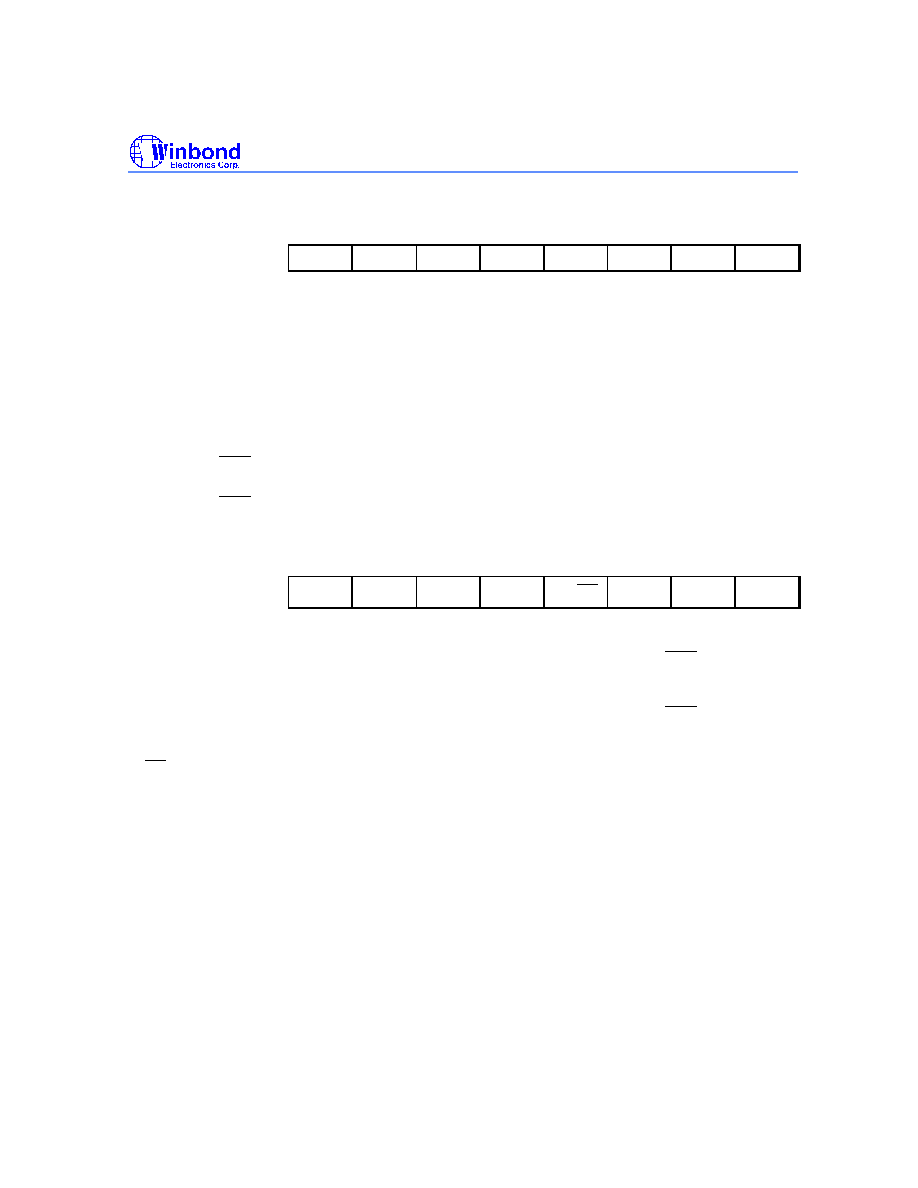
Preliminary W77E58
Publication Release Date: March 1999
- 17 - Revision A1
PORT 1
Bit:
7
6
5
4
3
2
1
0
P1.7
P1.6
P1.5
P1.4
P1.3
P1.2
P1.1
P1.0
Mnemonic: P1
Address: 90h
P1.7-0: General purpose I/O port. Most instructions will read the port pins in case of a port read
access, however in case of read-modify-write instructions, the port latch is read. Some pins
also have alternate input or output functions. This alternate functions are described below:
P1.0 : T2
External I/O for Timer/Counter 2
P1.1 : T2EX
Timer/Counter 2 Capture/Reload Trigger
P1.2 : RXD1
Serial Port 1 Receive
P1.3 : TXD1
Serial Port 1 Transmit
P1.4 : INT2
External Interrupt 2
P1.5 : INT3
External Interrupt 3
P1.6 : INT4
External Interrupt 4
P1.7 : INT5
External Interrupt 5
EXTERNAL INTERRUPT FLAG
Bit:
7
6
5
4
3
2
1
0
IE5
IE4
IE3
IE2
XT/ RG
RGMD
RGSL
-
Mnemonic: EXIF
Address: 91h
IE5: External Interrupt 5 flag. Set by hardware when a falling edge is detected on INT5 .
IE4: External Interrupt 4 flag. Set by hardware when a rising edge is detected on INT4.
IE3: External Interrupt 3 flag. Set by hardware when a falling edge is detected on INT3 .
IE2: External Interrupt 2 flag. Set by hardware when a rising edge is detected on INT2.
XT/ RG : Crystal/RC Oscillator Select. Setting this bit selects crystal or external clock as system clock
source. Clearing this bit selects the on-chip RC oscillator as clock source. XTUP(STATUS.4)
must be set to 1 and XTOFF (PMR.3) must be cleared before this bit can be set. Attempts to
set this bit without obeying these conditions will be ignored. This bit is set to 1 after a power-
on reset and unchanged by other forms of reset.
RGMD: RC Mode Status. This bit indicates the current clock source of microcontroller. When cleared,
CPU is operating from the external crystal or oscillator. When set, CPU is operating from the
on-chip RC oscillator. This bit is cleared to 0 after a power-on reset and unchanged by other
forms of reset.
RGSL: RC Oscillator Select. This bit selects the clock source following a resume from Power Down
Mode. Setting this bit allows device operating from RC oscillator when a resume from Power
Down Mode. When this bit is cleared, the device will hold operation until the crystal oscillator
has warmed-up following a resume from Power Down Mode. This bit is cleared to 0 after a
power-on reset and unchanged by other forms of reset.

Preliminary W77E58
- 18 -
SERIAL PORT CONTROL
Bit:
7
6
5
4
3
2
1
0
SM0/FE
SM1
SM2
REN
TB8
RB8
TI
RI
Mnemonic: SCON
Address: 98h
SM0/FE: Serial port 0, Mode 0 bit or Framing Error Flag: The SMOD0 bit in PCON SFR determines
whether this bit acts as SM0 or as FE. The operation of SM0 is described below. When used
as FE, this bit will be set to indicate an invalid stop bit. This bit must be manually cleared in
software to clear the FE condition.
SM1:
Serial port Mode bit 1:
SM0 SM1 Mode
Description
Length
Baud rate
0
0
0
Synchronous
8
4/12 Tclk
0
1
1
Asynchronous 10
variable
1
0
2
Asynchronous 11
64/32 Tclk
1
1
3
Asynchronous 11
variable
SM2:
Multiple processors communication. Setting this bit to 1 enables the multiprocessor
communication feature in mode 2 and 3. In mode 2 or 3, if SM2 is set to 1, then RI will not be
activated if the received 9th data bit (RB8) is 0. In mode 1, if SM2 = 1, then RI will not be
activated if a valid stop bit was not received. In mode 0, the SM2 bit controls the serial port
clock. If set to 0, then the serial port runs at a divide by 12 clock of the oscillator. This gives
compatibility with the standard 8052. When set to 1, the serial clock become divide by 4 of
the oscillator clock. This results in faster synchronous serial communication.
REN:
Receive enable: When set to 1 serial reception is enabled, otherwise reception is disabled.
TB8:
This is the 9th bit to be transmitted in modes 2 and 3. This bit is set and cleared by software
as desired.
RB8:
In modes 2 and 3 this is the received 9th data bit. In mode 1, if SM2 = 0, RB8 is the stop bit
that was received. In mode 0 it has no function.
TI:
Transmit interrupt flag: This flag is set by hardware at the end of the 8th bit time in mode 0, or
at the beginning of the stop bit in all other modes during serial transmission. This bit must be
cleared by software.
RI:
Receive interrupt flag: This flag is set by hardware at the end of the 8th bit time in mode 0, or
halfway through the stop bits time in the other modes during serial reception. However the
restrictions of SM2 apply to this bit. This bit can be cleared only by software.
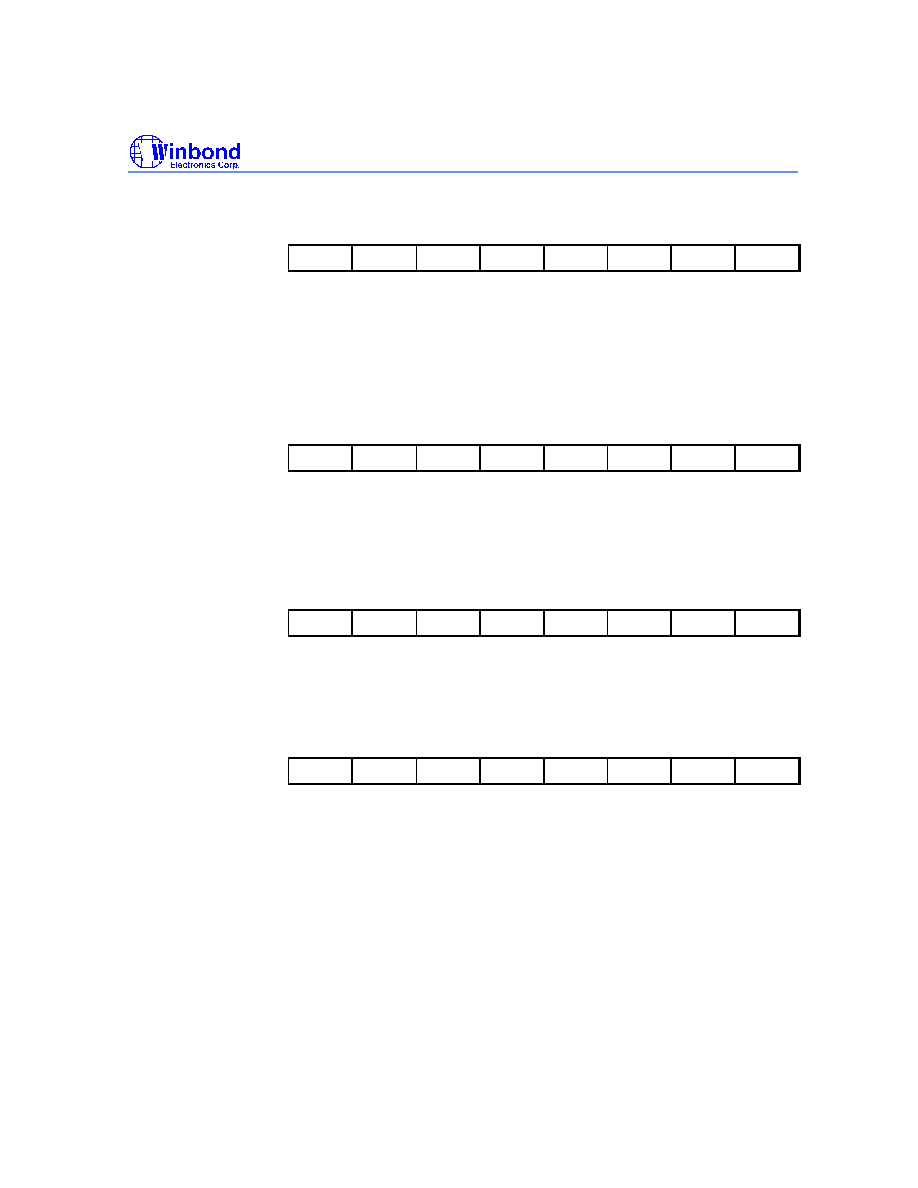
Preliminary W77E58
Publication Release Date: March 1999
- 19 - Revision A1
SERIAL DATA BUFFER
Bit:
7
6
5
4
3
2
1
0
SBUF.7 SBUF.6 SBUF.5 SBUF.4 SBUF.3 SBUF.2 SBUF.1 SBUF.0
Mnemonic: SBUF
Address: 99h
SBUF.7-0: Serial data on the serial port 0 is read from or written to this location. It actually consists of
two separate internal 8-bit registers. One is the receive resister, and the other is the
transmit buffer. Any read access gets data from the receive data buffer, while write access
is to the transmit data buffer.
PORT 2
Bit:
7
6
5
4
3
2
1
0
P2.7
P2.6
P2.5
P2.4
P2.3
P2.2
P2.1
P2.0
Mnemonic: P2
Address: A0h
P2.7-0: Port 2 is a bi-directional I/O port with internal pull-ups. This port also provides the upper
address bits for accesses to external memory.
PORT 4
Bit:
7
6
5
4
3
2
1
0
-
-
-
-
P4.3
P4.2
P4.1
P4.0
Mnemonic: P4
Address: A5h
P4.3-0: Port 4 is a bi-directional I/O port with internal pull-ups.
INTERRUPT ENABLE
Bit:
7
6
5
4
3
2
1
0
EA
ES1
ET2
ES
ET1
EX1
ET0
EX0
Mnemonic: IE
Address: A8h
EA:
Global enable. Enable/disable all interrupts except for PFI.
ES1:
Enable Serial Port 1 interrupt.
ET2:
Enable Timer 2 interrupt.
ES:
Enable Serial Port 0 interrupt.
ET1:
Enable Timer 1 interrupt
EX1:
Enable external interrupt 1
ET0:
Enable Timer 0 interrupt
EX0:
Enable external interrupt 0
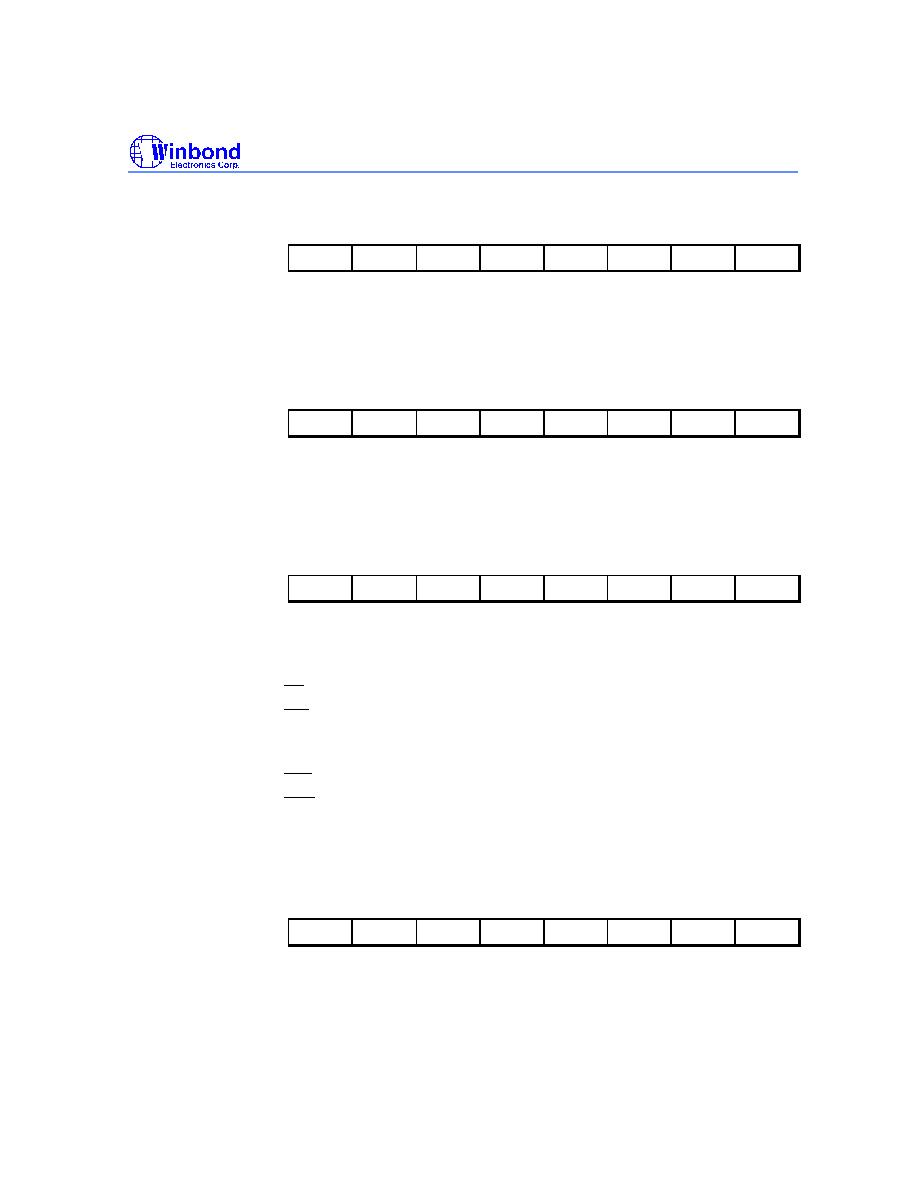
Preliminary W77E58
- 20 -
SLAVE ADDRESS
Bit:
7
6
5
4
3
2
1
0
Mnemonic: SADDR
Address: A9h
SADDR: The SADDR should be programmed to the given or broadcast address for serial port 0 to
which the slave processor is designated.
SLAVE ADDRESS 1
Bit:
7
6
5
4
3
2
1
0
Mnemonic: SADDR1
Address: AAh
SADDR1: The SADDR1 should be programmed to the given or broadcast address for serial port 1 to
which the slave processor is designated.
PORT 3
Bit:
7
6
5
4
3
2
1
0
P3.7
P3.6
P3.5
P3.4
P3.3
P3.2
P3.1
P3.0
Mnemonic: P3
Address: B0h
P3.7-0: General purpose I/O port. Each pin also has an alternate input or output function. The
alternate functions are described below.
P3.7
RD
Strobe for read from external RAM
P3.6
WR
Strobe for write to external RAM
P3.5
T1
Timer/counter 1 external count input
P3.4
T0
Timer/counter 0 external count input
P3.3
INT1
External interrupt 1
P3.2
INT0
External interrupt 0
P3.1
TxD
Serial port 0 output
P3.0
RxD
Serial port 0 input
INTERRUPT PRIORITY
Bit:
7
6
5
4
3
2
1
0
-
PS1
PT2
PS
PT1
PX1
PT0
PX0
Mnemonic: IP
Address: B8h
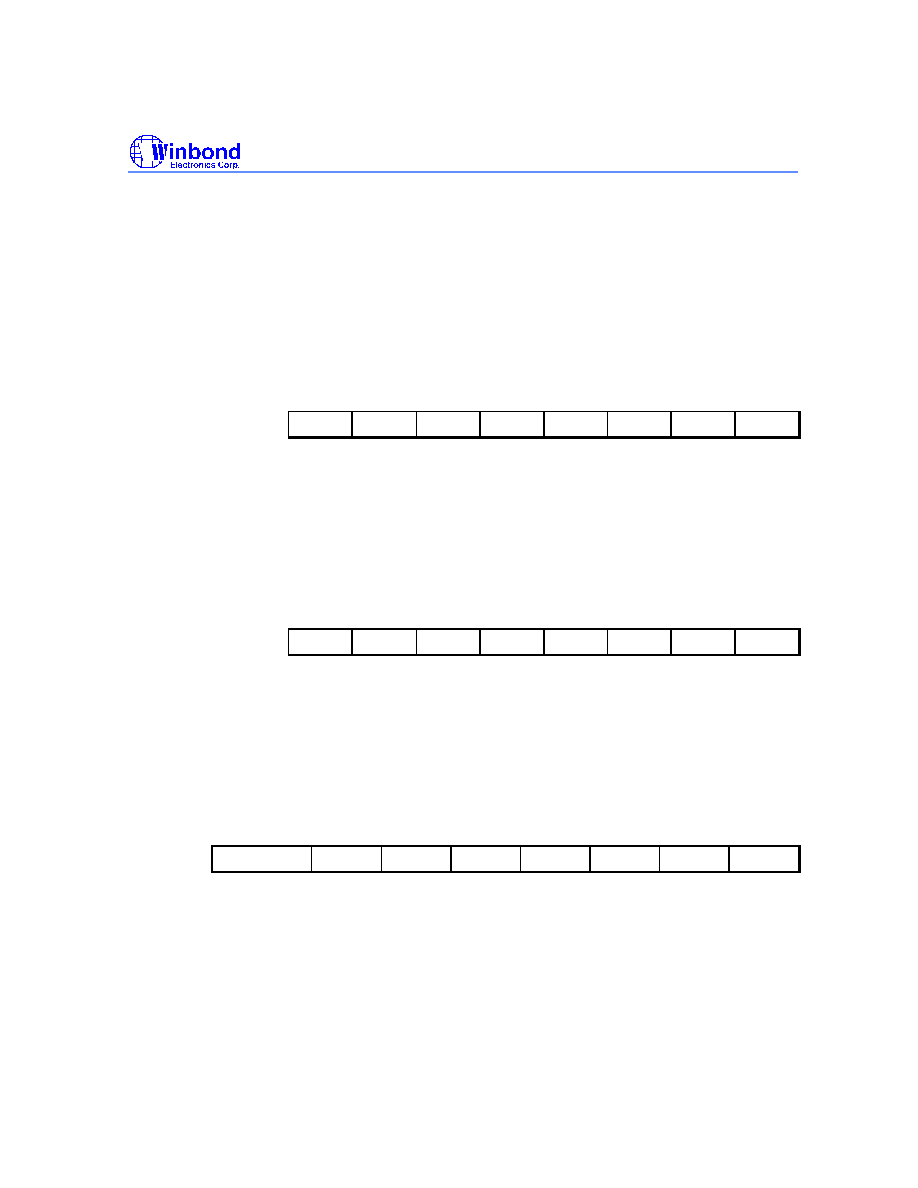
Preliminary W77E58
Publication Release Date: March 1999
- 21 - Revision A1
IP.7:
This bit is un-implemented and will read high.
PS1:
This bit defines the Serial port 1 interrupt priority. PS = 1 sets it to higher priority level.
PT2:
This bit defines the Timer 2 interrupt priority. PT2 = 1 sets it to higher priority level.
PS:
This bit defines the Serial port 0 interrupt priority. PS = 1 sets it to higher priority level.
PT1:
This bit defines the Timer 1 interrupt priority. PT1 = 1 sets it to higher priority level.
PX1:
This bit defines the External interrupt 1 priority. PX1 = 1 sets it to higher priority level.
PT0:
This bit defines the Timer 0 interrupt priority. PT0 = 1 sets it to higher priority level.
PX0:
This bit defines the External interrupt 0 priority. PX0 = 1 sets it to higher priority level.
SLAVE ADDRESS MASK ENABLE
Bit:
7
6
5
4
3
2
1
0
Mnemonic: SADEN
Address: B9h
SADEN: This register enables the Automatic Address Recognition feature of the Serial port 0. When
a bit in the SADEN is set to 1, the same bit location in SADDR will be compared with the
incoming serial data. When SADEN.n is 0, then the bit becomes a "don't care" in the
comparison. This register enables the Automatic Address Recognition feature of the Serial
port 0. When all the bits of SADEN are 0, interrupt will occur for any incoming address.
SLAVE ADDRESS MASK ENABLE 1
Bit:
7
6
5
4
3
2
1
0
Mnemonic: SADEN1
Address: BAh
SADEN1:This register enables the Automatic Address Recognition feature of the Serial port 1. When
a bit in the SADEN1 is set to 1, the same bit location in SADDR1 will be compared with the
incoming serial data. When SADEN1.n is 0, then the bit becomes a "don't care" in the
comparison. This register enables the Automatic Address Recognition feature of the Serial
port 1. When all the bits of SADEN1 are 0, interrupt will occur for any incoming address.
SERIAL PORT CONTROL 1
Bit:
7
6
5
4
3
2
1
0
SM0_1/FE_1
SM1_1
SM2_1
REN_1
TB8_1
RB8_1
TI_1
RI_1
Mnemonic: SCON1
Address: C0h
SM0_1/FE_1: Serial port 1, Mode 0 bit or Framing Error Flag 1: The SMOD0 bit in PCON SFR
determines whether this bit acts as SM0_1 or as FE_1. the operation of SM0_1 is
described below. When used as FE_1, this bit will be set to indicate an invalid stop bit.
This bit must be manually cleared in software to clear the FE_1 condition.
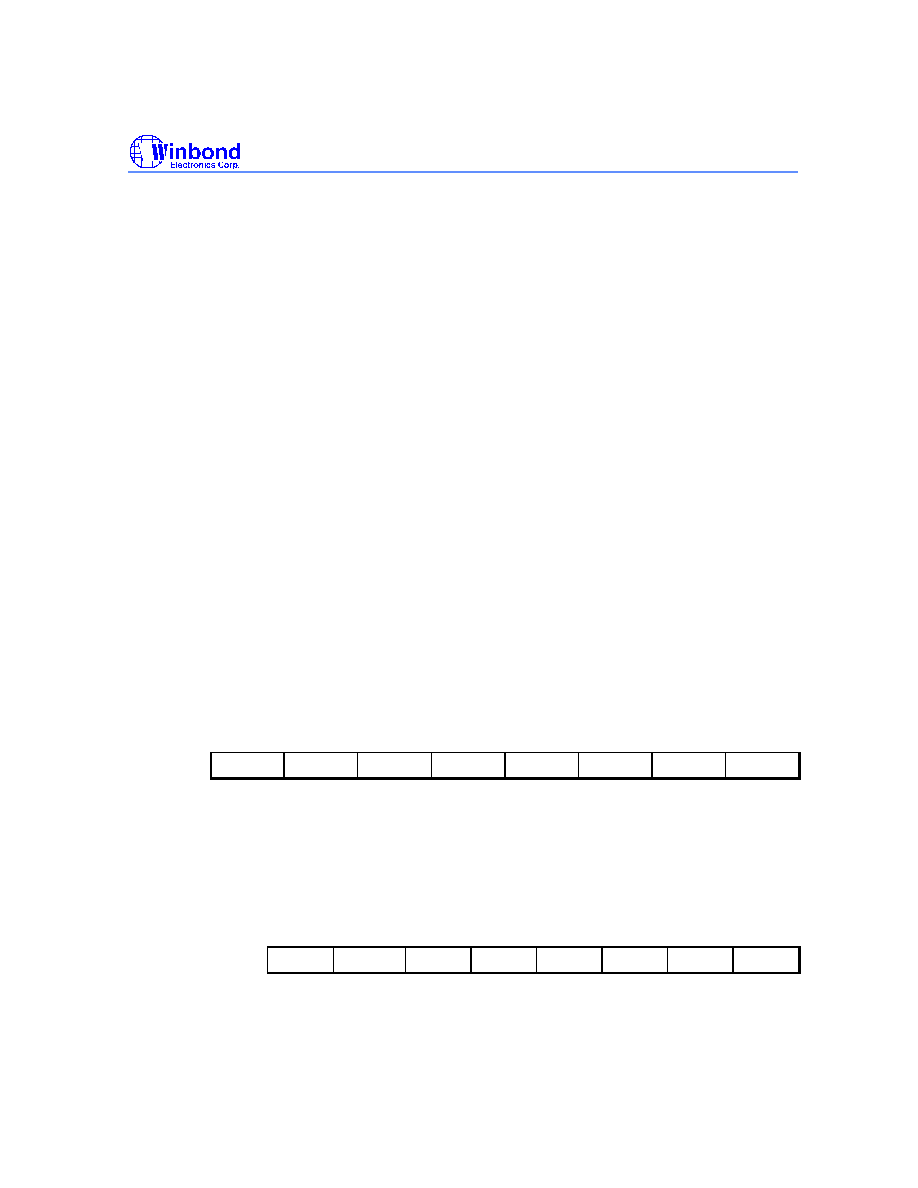
Preliminary W77E58
- 22 -
SM1_1: Serial port 1 Mode bit 1:
SM0_1 SM1_1 Mode
Description
Length
Baud rate
0
0
0
Synchronous
8
4/12 Tclk
0
1
1
Asynchronous 10
variable
1
0
2
Asynchronous 11
64/32 Tclk
1
1
3
Asynchronous 11
variable
SM2_1:Multiple processors communication. Setting this bit to 1 enables the multiprocessor
communication feature in mode 2 and 3. In mode 2 or 3, if SM2_1 is set to 1, then RI_1 will
not be activated if the received 9th data bit (RB8_1) is 0. In mode 1, if SM2_1 = 1, then RI_1
will not be activated if a valid stop bit was not received. In mode 0, the SM2_1 bit controls the
serial port 1 clock. If set to 0, then the serial port 1 runs at a divide by 12 clock of the
oscillator. This gives compatibility with the standard 8052. When set to 1, the serial clock
become divide by 4 of the oscillator clock. This results in faster synchronous serial
communication.
REN_1:Receive enable: When set to 1 serial reception is enabled, otherwise reception is disabled.
TB8_1: This is the 9th bit to be transmitted in modes 2 and 3. This bit is set and cleared by software
as desired.
RB8_1: In modes 2 and 3 this is the received 9th data bit. In mode 1, if SM2_1 = 0, RB8_1 is the stop
bit that was received. In mode 0 it has no function.
TI_1:
Transmit interrupt flag: This flag is set by hardware at the end of the 8th bit time in mode 0, or
at the beginning of the stop bit in all other modes during serial transmission. This bit must be
cleared by software.
RI_1:
Receive interrupt flag: This flag is set by hardware at the end of the 8th bit time in mode 0, or
halfway through the stop bits time in the other modes during serial reception. However the
restrictions of SM2_1 apply to this bit. This bit can be cleared only by software.
SERIAL DATA BUFFER 1
Bit:
7
6
5
4
3
2
1
0
SBUF1.7 SBUF1.6 SBUF1.5 SBUF1.4 SBUF1.3 SBUF1.2 SBUF1.1 SBUF1.0
Mnemonic: SBUF1
Address: C1h
SBUF1.7-0: Serial data of the serial port 1 is read from or written to this location. It actually consists
of two separate 8-bit registers. One is the receive resister, and the other is the transmit
buffer. Any read access gets data from the receive data buffer, while write accesses are
to the transmit data buffer.
ROMMAP
Bit:
7
6
5
4
3
2
1
0
WS
1
-
-
-
-
-
-
Mnemonic: ROMMAP
Address: C2h
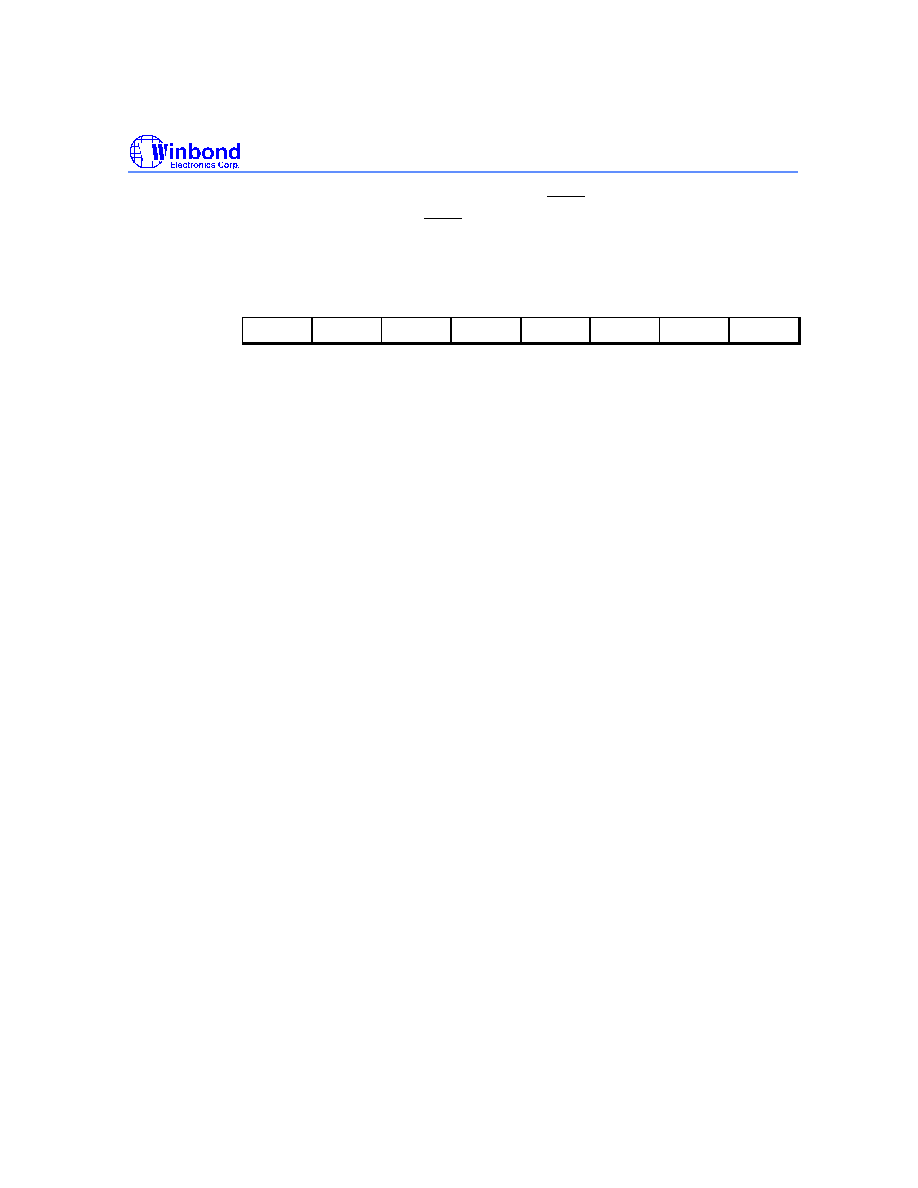
Preliminary W77E58
Publication Release Date: March 1999
- 23 - Revision A1
WS:
Wait State Signal Enable. Setting this bit enables the
WAIT
signal on P4.0. The device will
sample the wait state control signal
WAIT
via P4.0 during MOVX instruction. This bit is time
access protected.
POWER MANAGEMENT REGISTER
Bit:
7
6
5
4
3
2
1
0
CD1
CD0
SWB
-
XTOFF
ALE-OFF
-
DME0
Mnemonic: PMR
Address: C4h
CD1,CD0: Clock Divide Control. These bit selects the number of clocks required to generate one
machine cycle. There are three modes including divide by 4, 64 or 1024. Switching between
modes must first go back devide by 4 mode. For instance, to go from 64 to 1024
clocks/machine cycle the device must first go from 64 to 4 clocks/machine cycle, and then
from 4 to 1024 clocks/machine cycle.
CD1,
CD0
clocks/machine cycle
0
0
Reserved
0
1
4
1
0
64
1
1
1024
SWB:
Switchback Enable. Setting this bit allows an enabled external interrupt or serial port activity
to force the CD1,CD0 to divide by 4 state (0,1). The device will switch modes at the start of
the jump to interrupt service routine while a external interrupt is enabled and actually
recongnized by microcontroller. While a serial port reception, the switchback occurs at the
start of the instruction following the falling edge of the start bit.
XTOFF: Crystal Oscillator Disable. Setting this bit disables the external crystal oscillator. This bit can
only be set to 1 while the microcontroller is operating from the RC oscillator. Clearing this bit
restarts the crystal oscillator, the XTUP (STATUS.4) bit will be set after crystal oscillator
warmed-up has completed.
ALE0FF: This bit disables the expression of the ALE signal on the device pin during all on-board
program and data memory accesses. External memory accesses will automatically enable
ALE independent of ALEOFF.
0 = ALE expression is enable; 1 = ALE expression is disable
DME0: This bit determines the on-chip MOVX SRAM to be enabled or disabled. Set this bit to 1 will
enable the on-chip 1KB MOVX SRAM.
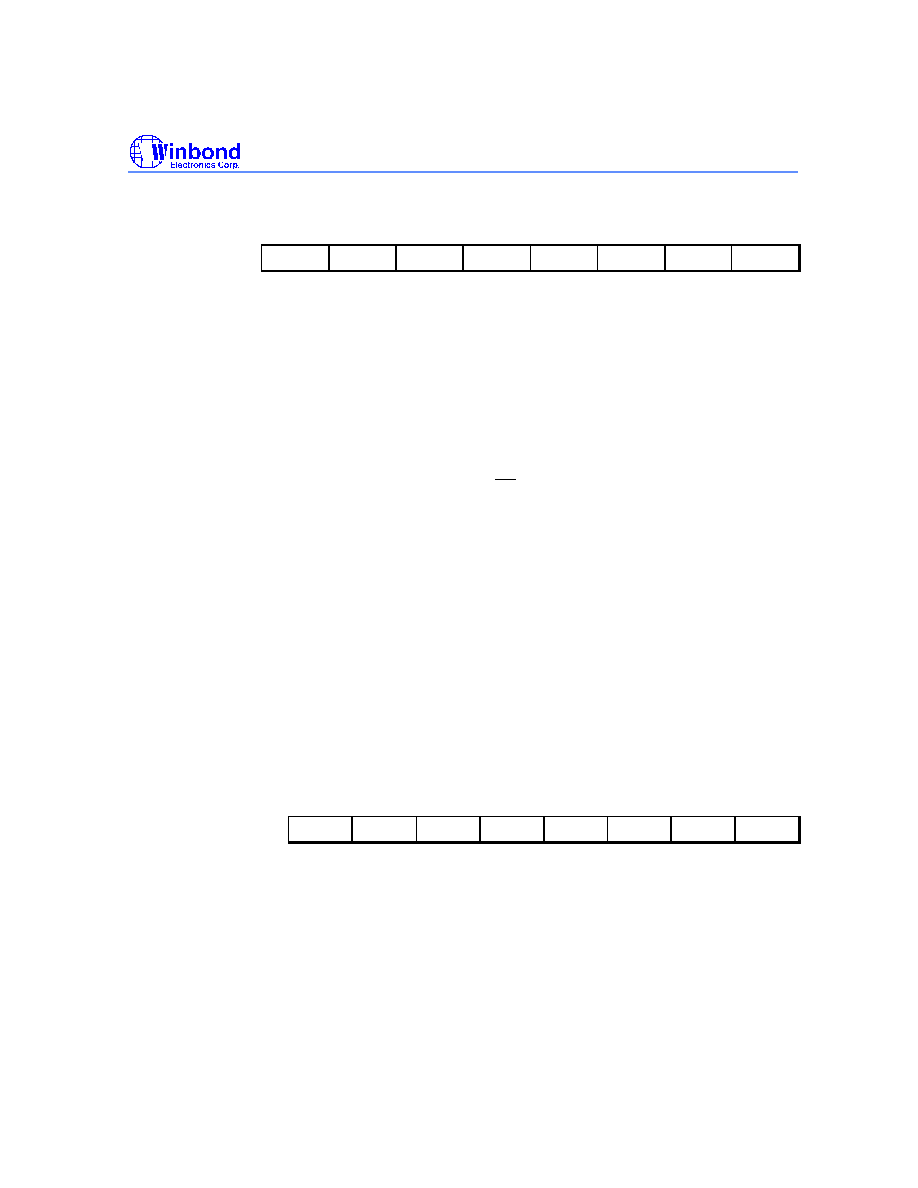
Preliminary W77E58
- 24 -
STATUS REGISTER
Bit:
7
6
5
4
3
2
1
0
-
HIP
LIP
XTUP
SPTA1
SPRA1
SPTA0
SPRA0
Mnemonic: STATUS
Address: C5h
HIP: High Priority Interrupt Status. When set, it indicates that software is servicing a high priority
interrupt. This bit will be cleared when the program executes the corresponding RETI
instruction.
LIP: Low Priority Interrupt Status. When set, it indicates that software is servicing a low priority
interrupt. This bit will be cleared when the program executes the corresponding RETI
instruction.
XTUP: Crystal Oscillator Warm-up Status. when set, this bit indicates CPU has detected clock to be
ready. Each time the crystal oscillator is restarted by exit from power down mode or the XTOFF
bit is set, hardware will clear this bit. This bit is set to 1 after a power-on reset. When this bit is
cleared, it prevents software from setting the XT/ RG bit to enable CPU operation from crystal
oscillator.
SPTA1: Serial Port 1 Transmit Activity. This bit is set during serial port 1 is currently transmitting
data. It is cleared when TI_1 bit is set by hardware. Changing the Clock Divide Control bits
CD0,CD1 will be ignored when this bit is set to 1 and SWB = 1.
SPRA1: Serial Port 1 Receive Activity. This bit is set during serial port 1 is currently receiving a data.
It is cleared when RI_1 bit is set by hardware. Changing the Clock Divide Control bits
CD0,CD1 will be ignored when this bit is set to 1 and SWB = 1.
SPTA0: Serial Port 0 Transmit Activity. This bit is set during serial port 0 is currently transmitting
data. It is cleared when TI bit is set by hardware. Changing the Clock Divide Control bits
CD0,CD1 will be ignored when this bit is set to 1 and SWB = 1.
SPRA0: Serial Port 0 Receive Activity. This bit is set during serial port 0 is currently receiving a data.
It is cleared when RI bit is set by hardware. Changing the Clock Divide Control bits CD0,CD1
will be ignored when this bit is set to 1 and SWB = 1.
TIMED ACCESS
Bit:
7
6
5
4
3
2
1
0
TA.7
TA.6
TA.5
TA.4
TA.3
TA.2
TA.1
TA.0
Mnemonic: TA
Address: C7h
TA: The Timed Access register controls the access to protected bits. To access protected bits, the
user must first write AAH to the TA. This must be immediately followed by a write of 55H to TA.
Now a window is opened in the protected bits for three machine cycles, during which the user
can write to these bits.
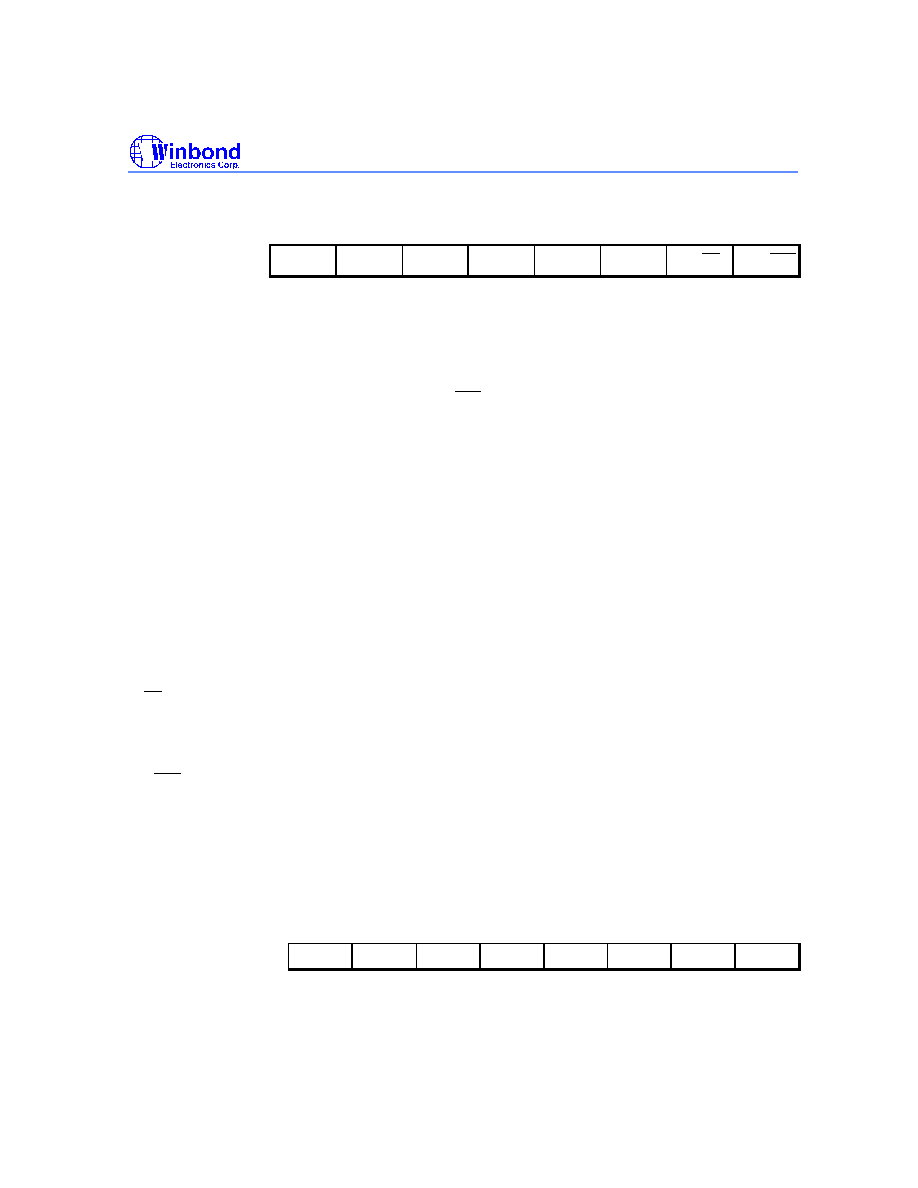
Preliminary W77E58
Publication Release Date: March 1999
- 25 - Revision A1
TIMER 2 CONTROL
Bit:
7
6
5
4
3
2
1
0
TF2
EXF2
RCLK
TCLK
EXEN2
TR2
C T
/ 2
CP RL
/
2
Mnemonic: T2CON
Address: C8h
TF2:
Timer 2 overflow flag: This bit is set when Timer 2 overflows. It is also set when the count is
equal to the capture register in down count mode. It can be set only if RCLK and TCLK are
both 0. It is cleared only by software. Software can also set or clear this bit.
EXF2: Timer 2 External Flag: A negative transition on the T2EX pin (P1.1) or timer 2 overflow will
cause this flag to set based on the CP RL
/
2 , EXEN2 and DCEN bits. If set by a negative
transition, this flag must be cleared by software. Setting this bit in software or detection of a
negative transition on T2EX pin will force a timer interrupt if enabled.
RCLK: Receive Clock Flag: This bit determines the serial port 0 time-base when receiving data in
serial modes 1 or 3. If it is 0, then timer 1 overflow is used for baud rate generation, otherwise
timer 2 overflow is used. Setting this bit forces timer 2 in baud rate generator mode.
TCLK: Transmit Clock Flag: This bit determines the serial port 0 time-base when transmitting data in
modes 1 and 3. If it is set to 0, the timer 1 overflow is used to generate the baud rate clock
otherwise timer 2 overflow is used. Setting this bit forces timer 2 in baud rate generator mode.
EXEN2: Timer 2 External Enable. This bit enables the capture/reload function on the T2EX pin if
Timer 2 is not generating baud clocks for the serial port. If this bit is 0, then the T2EX pin will
be ignored, otherwise a negative transition detected on the T2EX pin will result in capture or
reload.
TR2:
Timer 2 Run Control. This bit enables/disables the operation of timer 2. Clearing this bit will
halt the timer 2 and preserve the current count in TH2, TL2.
C T
/ 2 : Counter/Timer Select. This bit determines whether timer 2 will function as a timer or a
counter. Independent of this bit, the timer will run at 2 clocks per tick when used in baud rate
generator mode. If it is set to 0, then timer 2 operates as a timer at a speed depending on
T2M bit (CKCON.5), otherwise it will count negative edges on T2 pin.
CP RL
/
2 :Capture/Reload Select. This bit determines whether the capture or reload function will be
used for timer 2. If either RCLK or TCLK is set, this bit will be ignored and the timer will
function in an auto-reload mode following each overflow. If the bit is 0 then auto-reload will
occur when timer 2 overflows or a falling edge is detected on T2EX pin if EXEN2 = 1. If this
bit is 1, then timer 2 captures will occur when a falling edge is detected on T2EX pin if EXEN2
= 1.
TIMER 2 MODE CONTROL
Bit:
7
6
5
4
3
2
1
0
HC5
HC4
HC3
HC2
T2CR
-
T2OE
DCEN
Mnemonic: T2MOD
Address: C9h
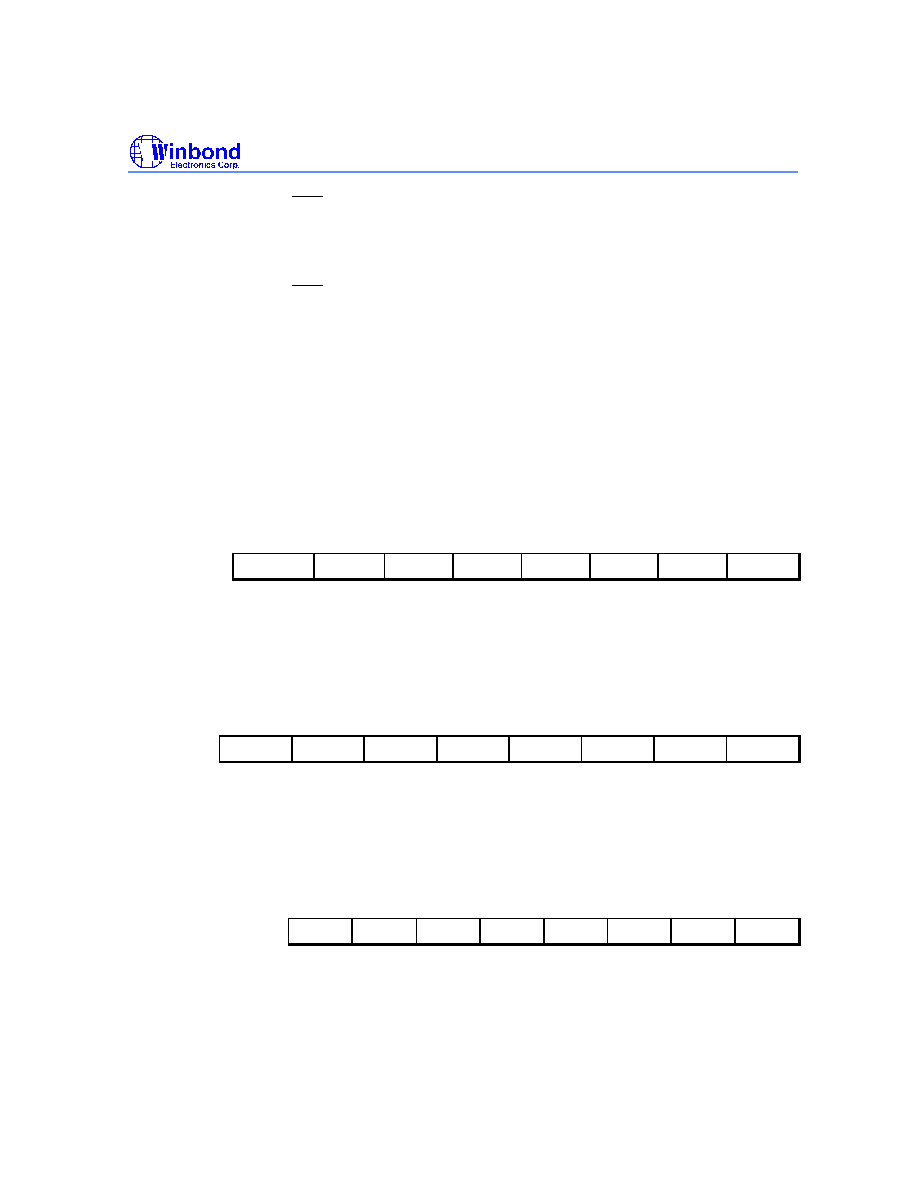
Preliminary W77E58
- 26 -
HC5:
Hardware Clear INT5 flag. Setting this bit allows the flag of external interrupt 5 to be
automatically cleared by hardware while entering the interrupt service routine.
HC4:
Hardware Clear INT4 flag. Setting this bit allows the flag of external interrupt 4 to be
automatically cleared by hardware while entering the interrupt service routine.
HC3:
Hardware Clear INT3 flag. Setting this bit allows the flag of external interrupt 3 to be
automatically cleared by hardware while entering the interrupt service routine.
HC3:
Hardware Clear INT2 flag. Setting this bit allows the flag of external interrupt 3 to be
automatically cleared by hardware while entering the interrupt service routine.
T2CR: Timer 2 Capture Reset. In the Timer 2 Capture Mode this bit enables/disables hardware
automatically reset Timer 2 while the value in TL2 and TH2 have been transferred into the
capture register.
T2OE: Timer 2 Output Enable. This bit enables/disables the Timer 2 clock out function.
DCEN: Down Count Enable: This bit, in conjunction with the T2EX pin, controls the direction that
timer 2 counts in 16-bit auto-reload mode.
TIMER 2 CAPTURE LSB
Bit:
7
6
5
4
3
2
1
0
RCAP2L.7
RCAP2L.6
RCAP2L.5
RCAP2L.4
RCAP2L.3
RCAP2L.2
RCAP2L.1
RCAP2L.0
Mnemonic: RCAP2L
Address: CAh
RCAP2L:This register is used to capture the TL2 value when a timer 2 is configured in capture mode.
RCAP2L is also used as the LSB of a 16-bit reload value when timer 2 is configured in auto-
reload mode.
TIMER 2 CAPTURE MSB
Bit:
7
6
5
4
3
2
1
0
RCAP2H.7 RCAP2H.6 RCAP2H.5 RCAP2H.4 RCAP2H.3 RCAP2H.2 RCAP2H.1 RCAP2H.0
Mnemonic: RCAP2H
Address: CBh
RCAP2H:This register is used to capture the TH2 value when a timer 2 is configured in capture mode.
RCAP2H is also used as the MSB of a 16-bit reload value when timer 2 is configured in
auto-reload mode.
TIMER 2 LSB
Bit:
7
6
5
4
3
2
1
0
TL2.7
TL2.6
TL2.5
TL2.4
TL2.3
TL2.2
TL2.1
TL2.0
Mnemonic: TL2
Address: CCh
TL2:
Timer 2 LSB
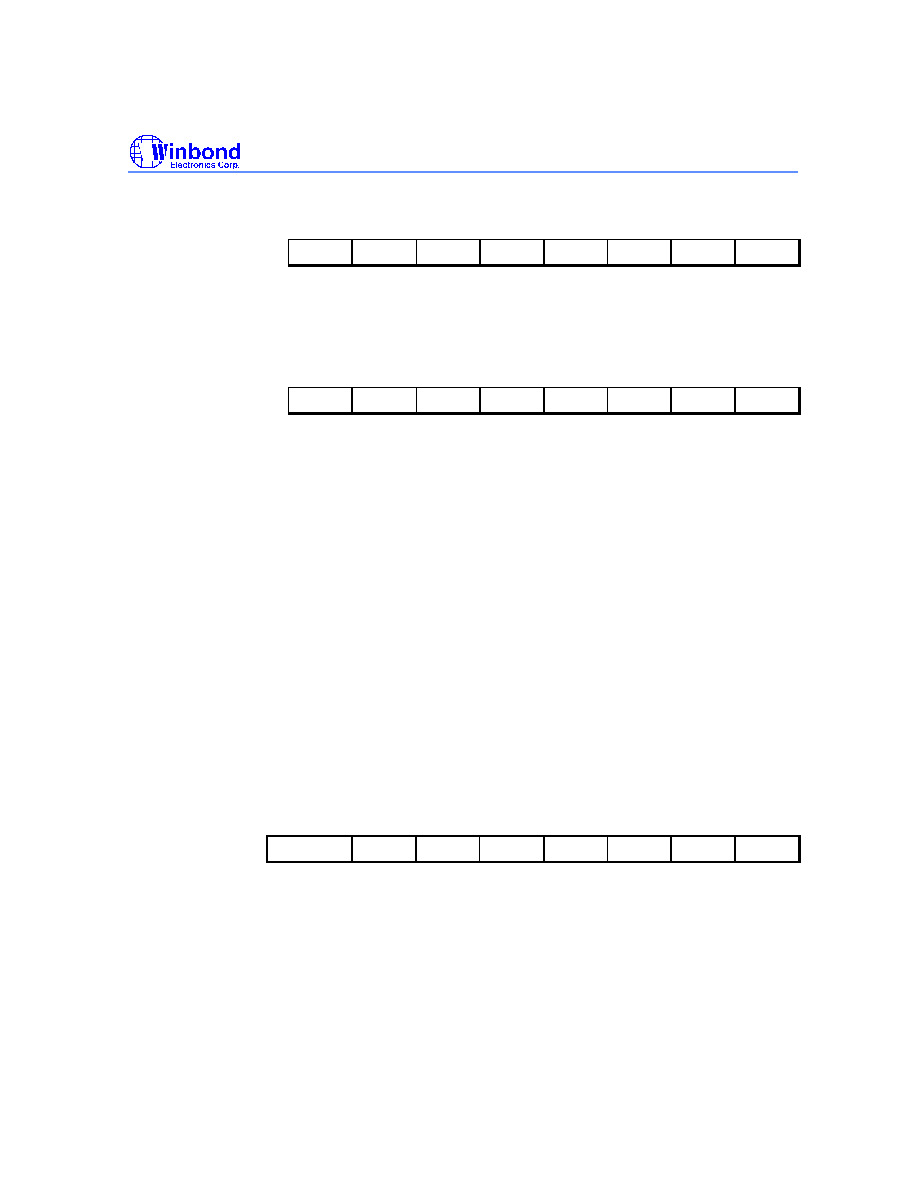
Preliminary W77E58
Publication Release Date: March 1999
- 27 - Revision A1
TIMER 2 MSB
Bit:
7
6
5
4
3
2
1
0
TH2.7
TH2.6
TH2.5
TH2.4
TH2.3
TH2.2
TH2.1
TH2.0
Mnemonic: TH2
Address: CDh
TH2:
Timer 2 MSB
PROGRAM STATUS WORD
Bit:
7
6
5
4
3
2
1
0
CY
AC
F0
RS1
RS0
OV
F1
P
Mnemonic: PSW
Address: D0h
CY:
Carry flag: Set for an arithmetic operation which results in a carry being generated from the
ALU. It is also used as the accumulator for the bit operations.
AC:
Auxiliary carry: Set when the previous operation resulted in a carry from the high order nibble.
F0:
User flag 0: General purpose flag that can be set or cleared by the user.
RS.1-0: Register bank select bits:
RS1 RS0
Register bank
Address
0
0
0
00-07h
0
1
1
08-0Fh
1
0
2
10-17h
1
1
3
18-1Fh
OV:
Overflow flag: Set when a carry was generated from the seventh bit but not from the 8th bit
as a result of the previous operation, or vice-versa.
F1:
User Flag 1: General purpose flag that can be set or cleared by the user by software.
P:
Parity flag: Set/cleared by hardware to indicate odd/even number of 1's in the accumulator.
WATCHDOG CONTROL
Bit:
7
6
5
4
3
2
1
0
SMOD_1
POR
-
-
WDIF
WTRF
EWT
RWT
Mnemonic: WDCON
Address: D8h
SMOD_1:This bit doubles the Serial Port 1 baud rate in mode 1, 2, and 3 when set to 1.
POR:
Power-on reset flag. Hardware will set this flag on a power up condition. This flag can be read
or written by software. A write by software is the only way to clear this bit once it is set.
WDIF: Watchdog Timer Interrupt Flag. If the watchdog interrupt is enabled, hardware will set this bit
to indicate that the watchdog interrupt has occurred. If the interrupt is not enabled, then this
bit indicates that the time-out period has elapsed. This bit must be cleared by software.
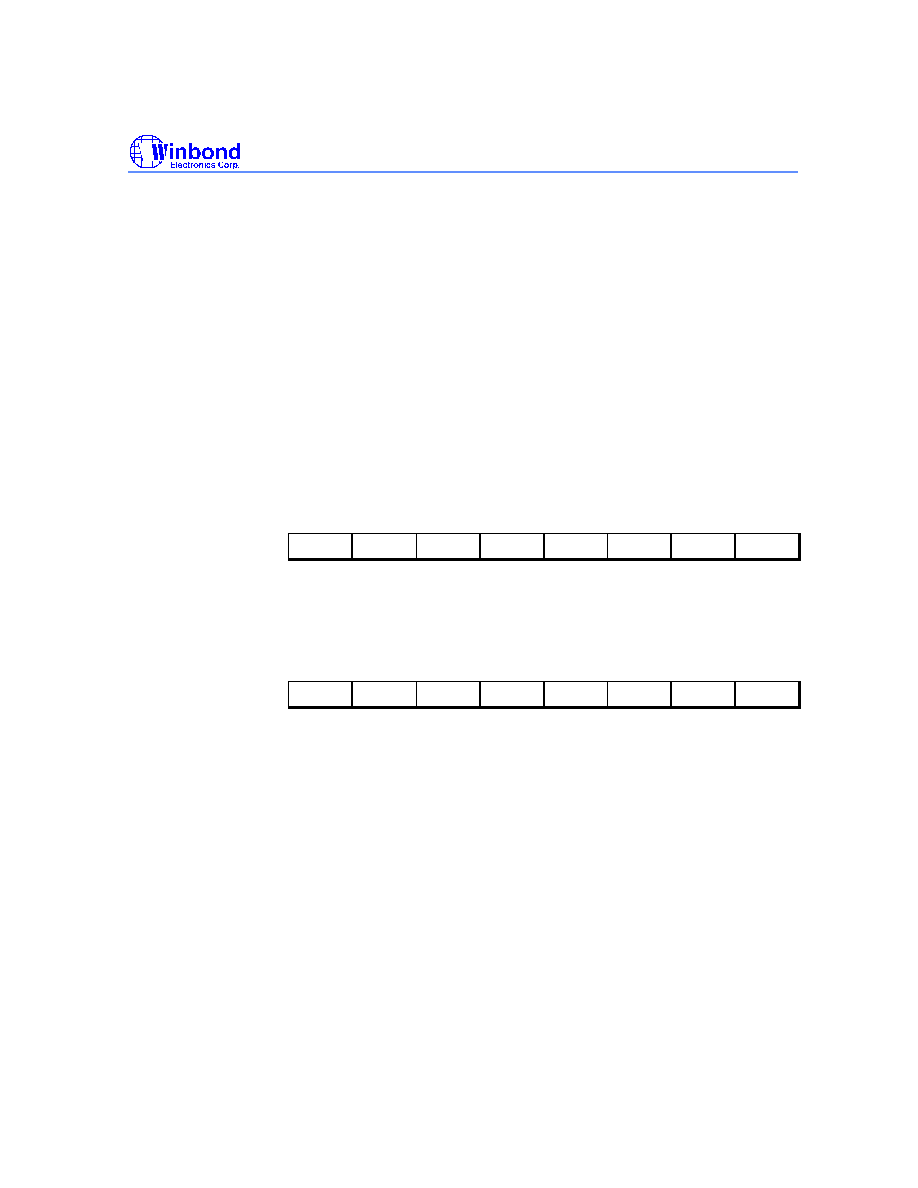
Preliminary W77E58
- 28 -
WTRF: Watchdog Timer Reset Flag. Hardware will set this bit when the watchdog timer causes a
reset. Software can read it but must clear it manually. A power-fail reset will also clear the bit.
This bit helps software in determining the cause of a reset. If EWT = 0, the watchdog timer
will have no affect on this bit.
EWT:
Enable Watchdog timer Reset. Setting this bit will enable the Watchdog timer Reset function.
RWT: Reset Watchdog Timer. This bit helps in putting the watchdog timer into a know state. It also
helps in resetting the watchdog timer before a time-out occurs. Failing to set the EWT before
time-out will cause an interrupt, if EWDI (EIE.4) is set, and 512 clocks after that a watchdog
timer reset will be generated if EWT is set. This bit is self-clearing by hardware.
The WDCON SFR is set to a 0x0x0xx0b on an external reset. WTRF is set to a 1 on a Watchdog
timer reset, but to a 0 on power on/down resets. WTRF is not altered by an external reset. POR is set
to 1 by a power-on reset. EWT is set to 0 on a Power-on reset and unaffected by other resets.
All the bits in this SFR have unrestricted read access. POR, EWT, WDIF and RWT require Timed
Access procedure to write. The remaining bits have unrestricted write accesses.
ACCUMULATOR
Bit:
7
6
5
4
3
2
1
0
ACC.7
ACC.6
ACC.5
ACC.4
ACC.3
ACC.2
ACC.1
ACC.0
Mnemonic: ACC
Address: E0h
ACC.7-0:The A (or ACC) register is the standard 8052 accumulator.
EXTENDED INTERRUPT ENABLE
Bit:
7
6
5
4
3
2
1
0
-
-
-
EWDI
EX5
EX4
EX3
EX2
Mnemonic: EIE
Address: E8h
EIE.7-5:Reserved bits, will read high
EWDI: Enable Watchdog timer interrupt
EX5: External Interrupt 5 Enable.
EX4: External Interrupt 4 Enable.
EX3: External Interrupt 3 Enable.
EX2: External Interrupt 2 Enable.
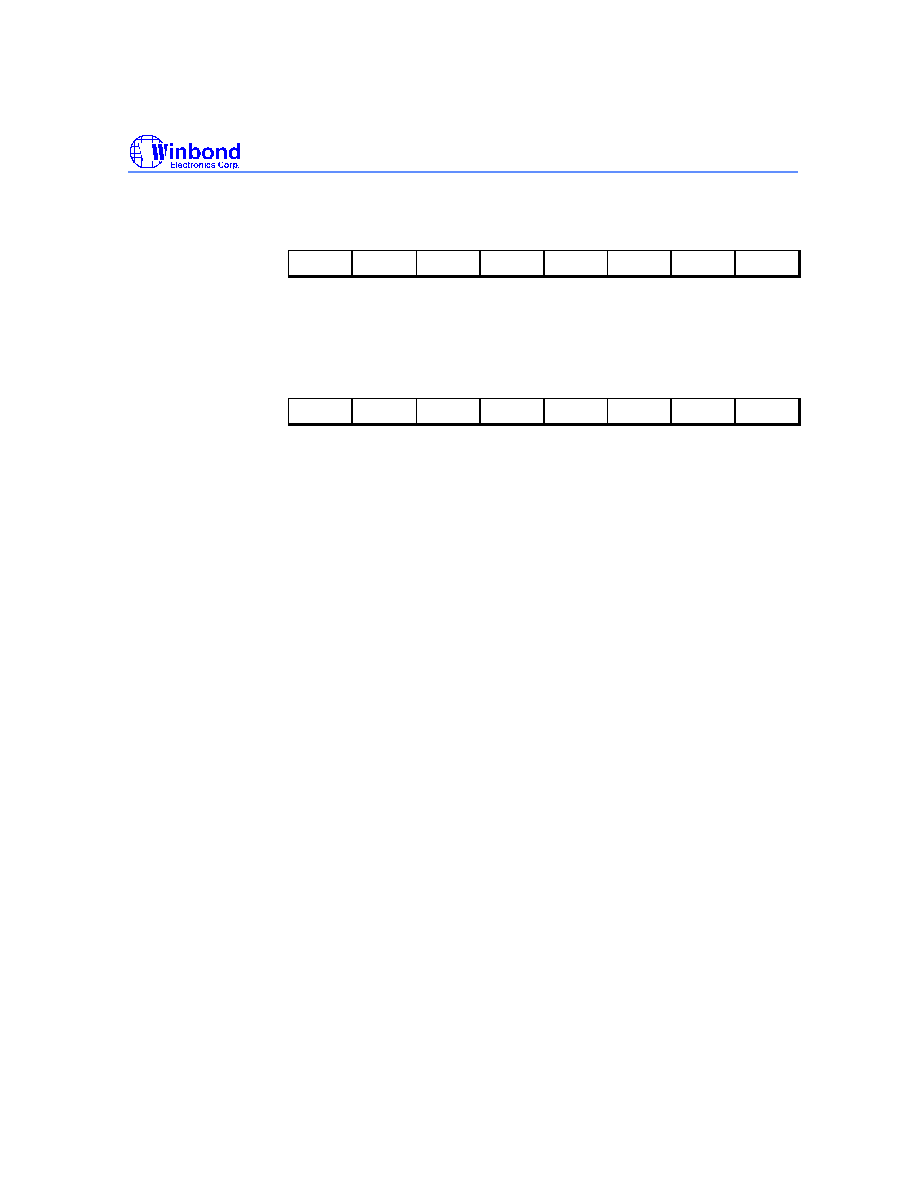
Preliminary W77E58
Publication Release Date: March 1999
- 29 - Revision A1
B REGISTER
Bit:
7
6
5
4
3
2
1
0
B.7
B.6
B.5
B.4
B.3
B.2
B.1
B.0
Mnemonic: B
Address: F0h
B.7-0:The B register is the standard 8052 register that serves as a second accumulator.
EXTENDED INTERRUPT PRIORITY
Bit:
7
6
5
4
3
2
1
0
-
-
-
PWDI
PX5
PX4
PX3
PX2
Mnemonic: EIP
Address: F8h
EIP.7-5:Reserved bits.
PWDI: Watchdog timer interrupt priority.
PX5:
External Interrupt 5 Priority. 0 = Low priority, 1 = High priority.
PX4:
External Interrupt 4 Priority. 0 = Low priority, 1 = High priority.
PX3:
External Interrupt 3 Priority. 0 = Low priority, 1 = High priority.
PX2:
External Interrupt 2 Priority. 0 = Low priority, 1 = High priority.
INSTRUCTION
The W77E58 executes all the instructions of the standard 8032 family. The operation of these
instructions, their effect on the flag bits and the status bits is exactly the same. However, timing of
these instructions is different. The reason for this is two fold. Firstly, in the W77E58, each machine
cycle consists of 4 clock periods, while in the standard 8032 it consists of 12 clock periods. Also, in
the W77E58 there is only one fetch per machine cycle i.e. 4 clocks per fetch, while in the standard
8032 there can be two fetches per machine cycle, which works out to 6 clocks per fetch.
The advantage the W77E58 has is that since there is only one fetch per machine cycle, the number
of machine cycles in most cases is equal to the number of operands that the instruction has. In case
of jumps and calls there will be an additional cycle that will be needed to calculate the new address.
But overall the W77E58 reduces the number of dummy fetches and wasted cycles, thereby improving
efficiency as compared to the standard 8032.
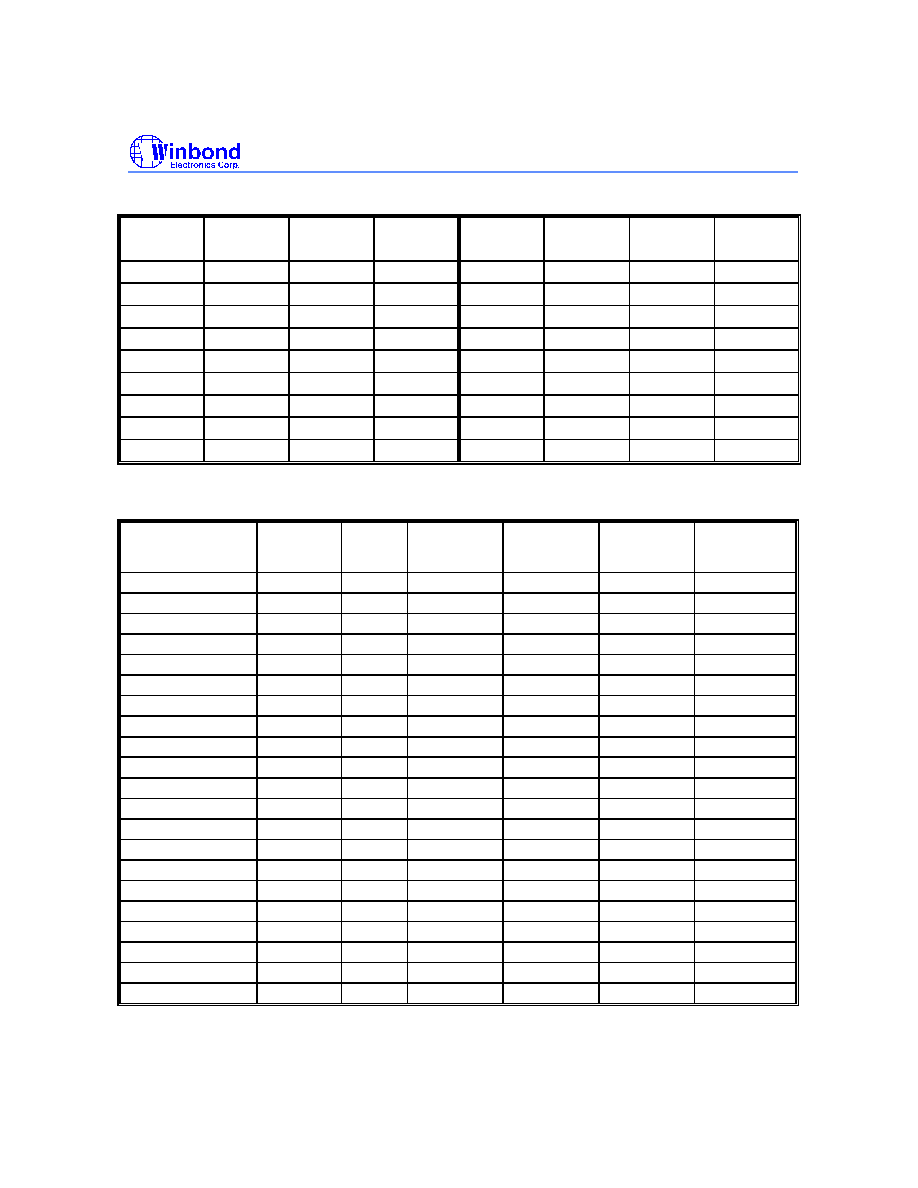
Preliminary W77E58
- 30 -
Table 2. Instructions that affect Flag settings
Instruction
Carry
Overflow
Auxiliary
Carry
Instruction
Carry
Overflow
Auxiliary
Carry
ADD
X
X
X
CLR C
0
ADDC
X
X
X
CPL C
X
SUBB
X
X
X
ANL C, bit
X
MUL
0
X
ANL C, bit
X
DIV
0
X
ORL C, bit
X
DA A
X
ORL C, bit
X
RRC A
X
MOV C, bit
X
RLC A
X
CJNE
X
SETB C
1
A "X" indicates that the modification is as per the result of instruction.
Table 3. Instruction Timing for W77E58
Instruction
HEX
Op-Code
Bytes
W77E58
Machine
Cycles
W77E58
Clock
cycles
8032
Clock
cycles
W77E58 vs.
8032 Speed
Ratio
NOP
00
1
1
4
12
3
ADD A, R0
28
1
1
4
12
3
ADD A, R1
29
1
1
4
12
3
ADD A, R2
2A
1
1
4
12
3
ADD A, R3
2B
1
1
4
12
3
ADD A, R4
2C
1
1
4
12
3
ADD A, R5
2D
1
1
4
12
3
ADD A, R6
2E
1
1
4
12
3
ADD A, R7
2F
1
1
4
12
3
ADD A, @R0
26
1
1
4
12
3
ADD A, @R1
27
1
1
4
12
3
ADD A, direct
25
2
2
8
12
1.5
ADD A, #data
24
2
2
8
12
1.5
ADDC A, R0
38
1
1
4
12
3
ADDC A, R1
39
1
1
4
12
3
ADDC A, R2
3A
1
1
4
12
3
ADDC A, R3
3B
1
1
4
12
3
ADDC A, R4
3C
1
1
4
12
3
ADDC A, R5
3D
1
1
4
12
3
ADDC A, R6
3E
1
1
4
12
3
ADDC A, R7
3F
1
1
4
12
3

Preliminary W77E58
Publication Release Date: March 1999
- 31 - Revision A1
Table 3. Instruction Timing for W77E58, continued
Instruction
HEX
Op-Code
Bytes
W77E58
Machine
Cycles
W77E58
Clock
cycles
8032
Clock
cycles
W77E58 vs.
8032 Speed
Ratio
ADDC A, @R0
36
1
1
4
12
3
ADDC A, @R1
37
1
1
4
12
3
ADDC A, direct
35
2
2
8
12
1.5
ADDC A, #data
34
2
2
8
12
1.5
ACALL addr11
71,91,B1,
11,31,51,
D1,F1
2
3
12
24
2
AJMP ADDR11
01,21,41,
61,81,A1,
C1,E1
2
3
12
24
2
ANL A, R0
58
1
1
4
12
3
ANL A, R1
59
1
1
4
12
3
ANL A, R2
5A
1
1
4
12
3
ANL A, R3
5B
1
1
4
12
3
ANL A, R4
5C
1
1
4
12
3
ANL A, R5
5D
1
1
4
12
3
ANL A, R6
5E
1
1
4
12
3
ANL A, R7
5F
1
1
4
12
3
ANL A, @R0
56
1
1
4
12
3
ANL A, @R1
57
1
1
4
12
3
ANL A, direct
55
2
2
8
12
1.5
ANL A, #data
54
2
2
8
12
1.5
ANL direct, A
52
2
2
8
12
1.5
ANL direct, #data
53
3
3
12
24
2
ANL C, bit
82
2
2
8
24
3
ANL C, /bit
B0
2
2
8
24
3
CJNE A, direct, rel
B5
3
4
16
24
1.5
CJNE A, #data, rel
B4
3
4
16
24
1.5
CJNE @R0, #data, rel
B6
3
4
16
24
1.5
CJNE @R1, #data, rel
B7
3
4
16
24
1.5
CJNE R0, #data, rel
B8
3
4
16
24
1.5
CJNE R1, #data, rel
B9
3
4
16
24
1.5
CJNE R2, #data, rel
BA
3
4
16
24
1.5
CJNE R3, #data, rel
BB
3
4
16
24
1.5
CJNE R4, #data, rel
BC
3
4
16
24
1.5
CJNE R5, #data, rel
BD
3
4
16
24
1.5
CJNE R6, #data, rel
BE
3
4
16
24
1.5
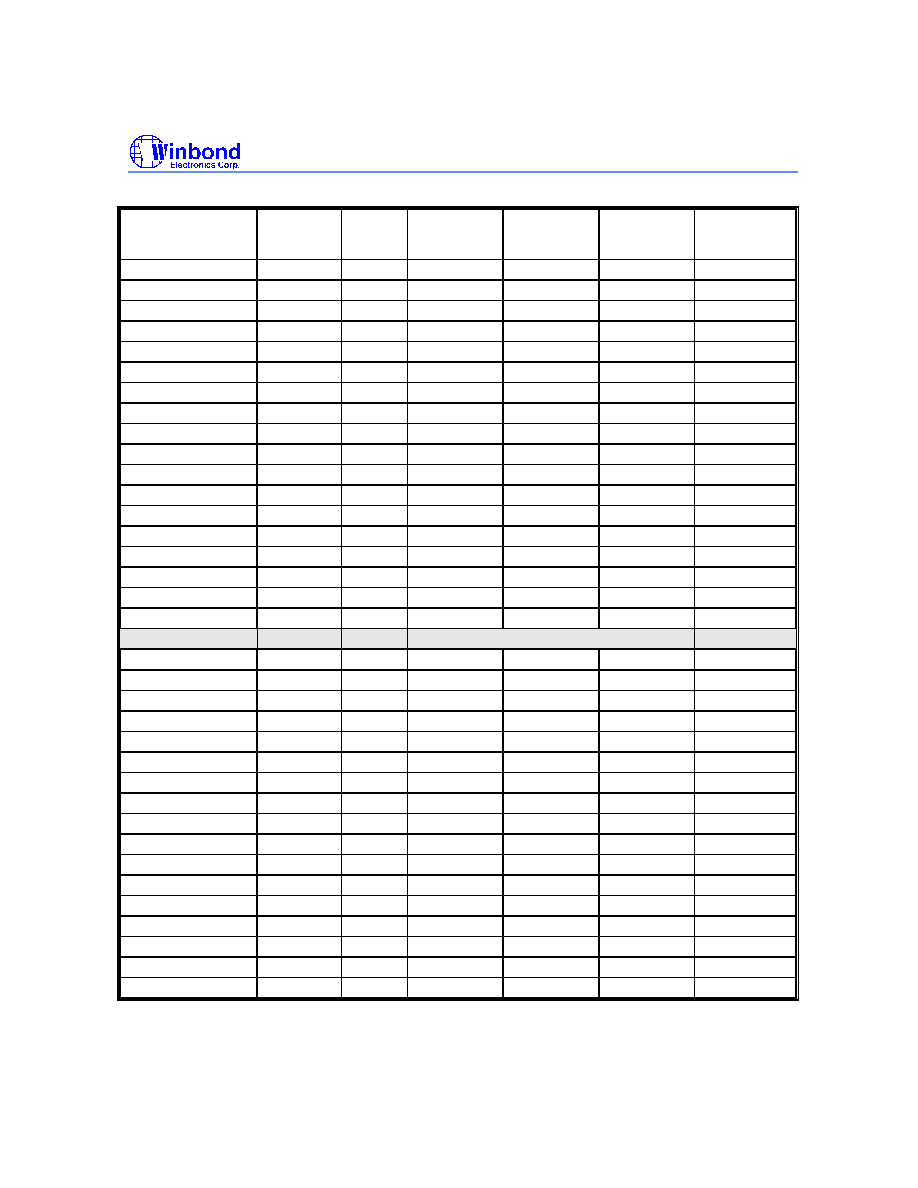
Preliminary W77E58
- 32 -
Table 3. Instruction Timing for W77E58, continued
Instruction
HEX
Op-Code
Bytes
W77E58
Machine
Cycles
W77E58
Clock
cycles
8032
Clock
cycles
W77E58 vs.
8032 Speed
Ratio
CLR A
E4
1
1
4
12
3
CPL A
F4
1
1
4
12
3
CLR C
C3
1
1
4
12
3
CLR bit
C2
2
2
8
12
1.5
CPL C
B3
1
1
4
12
3
CPL bit
B2
2
2
8
12
1.5
DEC A
14
1
1
4
12
3
DEC R0
18
1
1
4
12
3
DEC R1
19
1
1
4
12
3
DEC R2
1A
1
1
4
12
3
DEC R3
1B
1
1
4
12
3
DEC R4
1C
1
1
4
12
3
DEC R5
1D
1
1
4
12
3
DEC R6
1E
1
1
4
12
3
DEC R7
1F
1
1
4
12
3
DEC @R0
16
1
1
4
12
3
DEC @R1
17
1
1
4
12
3
DEC direct
15
2
2
8
12
1.5
DEC DPTR
A5
1
2
8
-
-
DIV AB
84
1
5
20
48
2.4
DA A
D4
1
1
4
12
3
DJNZ R0, rel
D8
2
3
12
24
2
DJNZ R1, rel
D9
2
3
12
24
2
DJNZ R5, rel
DD
2
3
12
24
2
DJNZ R2, rel
DA
2
3
12
24
2
DJNZ R3, rel
DB
2
3
12
24
2
DJNZ R4, rel
DC
2
3
12
24
2
DJNZ R6, rel
DE
2
3
12
24
2
DJNZ R7, rel
DF
2
3
12
24
2
DJNZ direct, rel
D5
3
4
16
24
1.5
INC A
04
1
1
4
12
3
INC R0
08
1
1
4
12
3
INC R1
09
1
1
4
12
3
INC R2
0A
1
1
4
12
3
INC R3
0B
1
1
4
12
3
INC R4
0C
1
1
4
12
3

Preliminary W77E58
Publication Release Date: March 1999
- 33 - Revision A1
Table 3. Instruction Timing for W77E58, continued
Instruction
HEX
Op-Code
Bytes
W77E58
Machine
Cycles
W77E58
Clock
cycles
8032
Clock
cycles
W77E58 vs.
8032 Speed
Ratio
INC R6
0E
1
1
4
12
3
INC R7
0F
1
1
4
12
3
INC @R0
06
1
1
4
12
3
INC @R1
07
1
1
4
12
3
INC direct
05
2
2
8
12
1.5
INC DPTR
A3
1
2
8
24
3
JMP @A+DPTR
73
1
2
8
24
3
JZ rel
60
2
3
12
24
2
JNZ rel
70
2
3
12
24
2
JC rel
40
2
3
12
24
2
JNC rel
50
2
3
12
24
2
JB bit, rel
20
3
4
16
24
1.5
JNB bit, rel
30
3
4
16
24
1.5
JBC bit, rel
10
3
4
16
24
1.5
LCALL addr16
12
3
4
16
24
1.5
LJMP addr16
02
3
4
16
24
1.5
MUL AB
A4
1
5
20
48
2.4
MOV A, R0
E8
1
1
4
12
3
MOV A, R1
E9
1
1
4
12
3
MOV A, R2
EA
1
1
4
12
3
MOV A, R3
EB
1
1
4
12
3
MOV A, R4
EC
1
1
4
12
3
MOV A, R5
ED
1
1
4
12
3
MOV A, R6
EE
1
1
4
12
3
MOV A, R7
EF
1
1
4
12
3
MOV A, @R0
E6
1
1
4
12
3
MOV A, @R1
E7
1
1
4
12
3
MOV A, direct
E5
2
2
8
12
1.5
MOV A, #data
74
2
2
8
12
1.5
MOV R0, A
F8
1
1
4
12
3
MOV R1, A
F9
1
1
4
12
3
MOV R2, A
FA
1
1
4
12
3
MOV R3, A
FB
1
1
4
12
3
MOV R4, A
FC
1
1
4
12
3
MOV R5, A
FD
1
1
4
12
3
MOV R6, A
FE
1
1
4
12
3
MOV R7, A
FF
1
1
4
12
3

Preliminary W77E58
- 34 -
Table 3. Instruction Timing for W77E58, continued
Instruction
HEX
Op-Code
Bytes
W77E58
Machine
Cycles
W77E58
Clock
cycles
8032
Clock
cycles
W77E58 vs.
8032 Speed
Ratio
MOV R1, direct
A9
2
2
8
12
1.5
MOV R2, direct
AA
2
2
8
12
1.5
MOV R3, direct
AB
2
2
8
12
1.5
MOV R4, direct
AC
2
2
8
12
1.5
MOV R5, direct
AD
2
2
8
12
1.5
MOV R6, direct
AE
2
2
8
12
1.5
MOV R7, direct
AF
2
2
8
12
1.5
MOV R0, #data
78
2
2
8
12
1.5
MOV R1, #data
79
2
2
8
12
1.5
MOV R2, #data
7A
2
2
8
12
1.5
MOV R3, #data
7B
2
2
8
12
1.5
MOV R4, #data
7C
2
2
8
12
1.5
MOV R5, #data
7D
2
2
8
12
1.5
MOV R6, #data
7E
2
2
8
12
1.5
MOV R7, #data
7F
2
2
8
12
1.5
MOV @R0, A
F6
1
1
4
12
3
MOV @R1, A
F7
1
1
4
12
3
MOV @R0, direct
A6
2
2
8
12
1.5
MOV @R1, direct
A7
2
2
8
12
1.5
MOV @R0, #data
76
2
2
8
12
1.5
MOV @R1, #data
77
2
2
8
12
1.5
MOV direct, A
F5
2
2
8
12
1.5
MOV direct, R0
88
2
2
8
12
1.5
MOV direct, R1
89
2
2
8
12
1.5
MOV direct, R2
8A
2
2
8
12
1.5
MOV direct, R3
8B
2
2
8
12
1.5
MOV direct, R4
8C
2
2
8
12
1.5
MOV direct, R5
8D
2
2
8
12
1.5
MOV direct, R6
8E
2
2
8
12
1.5
MOV direct, R7
8F
2
2
8
12
1.5
MOV direct, @R0
86
2
2
8
12
1.5
MOV direct, @R1
87
2
2
8
12
1.5
MOV direct, direct
85
3
3
12
24
2
MOV direct, #data
75
3
3
12
24
2
MOV DPTR, #data 16
90
3
3
12
24
2
MOVC A, @A+DPTR
93
1
2
8
24
3

Preliminary W77E58
Publication Release Date: March 1999
- 35 - Revision A1
Table 3. Instruction Timing for W77E58, continued
Instruction
HEX
Op-Code
Bytes
W77E58
Machine
Cycles
W77E58
Clock
cycles
8032
Clock
cycles
W77E58 vs.
8032 Speed
Ratio
MOVX A, @R0
E2
1
2 - 9
8 - 36
24
3 - 0.66
MOVX A, @R1
E3
1
2 - 9
8 - 36
24
3 - 0.66
MOVX A, @DPTR
E0
1
2 - 9
8 - 36
24
3 - 0.66
MOVX @R0, A
F2
1
2 - 9
8 - 36
24
3 - 0.66
MOVX @R1, A
F3
1
2 - 9
8 - 36
24
3 - 0.66
MOVX @DPTR, A
F0
1
2 - 9
8 - 36
24
3 - 0.66
MOV C, bit
A2
2
2
8
12
1.5
MOV bit, C
92
2
2
8
24
3
ORL A, R0
48
1
1
4
12
3
ORL A, R1
49
1
1
4
12
3
ORL A, R2
4A
1
1
4
12
3
ORL A, R3
4B
1
1
4
12
3
ORL A, R4
4C
1
1
4
12
3
ORL A, R5
4D
1
1
4
12
3
ORL A, R6
4E
1
1
4
12
3
ORL A, R7
4F
1
1
4
12
3
ORL A, @R0
46
1
1
4
12
3
ORL A, @R1
47
1
1
4
12
3
ORL A, direct
45
2
2
8
12
1.5
ORL A, #data
44
2
2
8
12
1.5
ORL direct, A
42
2
2
8
12
1.5
ORL direct, #data
43
3
3
12
24
2
ORL C, bit
72
2
2
8
24
3
ORL C, /bit
A0
2
2
6
24
3
PUSH direct
C0
2
2
8
24
3
POP direct
D0
2
2
8
24
3
RET
22
1
2
8
24
3
RETI
32
1
2
8
24
3
RL A
23
1
1
4
12
3
RLC A
33
1
1
4
12
3
RR A
03
1
1
4
12
3
RRC A
13
1
1
4
12
3
SETB C
D3
1
1
4
12
3
SETB bit
D2
2
2
8
12
1.5
SWAP A
C4
1
1
4
12
3
SJMP rel
80
2
3
12
24
2
SUBB A, R0
98
1
1
4
12
3

Preliminary W77E58
- 36 -
Table 3. Instruction Timing for W77E58, continued
Instruction
HEX
Op-Code
Bytes
W77E58
Machine
Cycles
W77E58
Clock
cycles
8032
Clock
cycles
W77E58 vs.
8032 Speed
Ratio
SUBB A, R2
9A
1
1
4
12
3
SUBB A, R3
9B
1
1
4
12
3
SUBB A, R4
9C
1
1
4
12
3
SUBB A, R5
9D
1
1
4
12
3
SUBB A, R6
9E
1
1
4
12
3
SUBB A, R7
9F
1
1
4
12
3
SUBB A, @R0
96
1
1
4
12
3
SUBB A, @R1
97
1
1
4
12
3
SUBB A, direct
95
2
2
8
12
1.5
SUBB A, #data
94
2
2
8
12
1.5
XCH A, R0
C8
1
1
4
12
3
XCH A, R1
C9
1
1
4
12
3
XCH A, R2
CA
1
1
4
12
3
XCH A, R3
CB
1
1
4
12
3
XCH A, R4
CC
1
1
4
12
3
XCH A, R5
CD
1
1
4
12
3
XCH A, R6
CE
1
1
4
12
3
XCH A, R7
CF
1
1
4
12
3
XCH A, @R0
C6
1
1
4
12
3
XCH A, @R1
C7
1
1
4
12
3
XCHD A, @R0
D6
1
1
4
12
3
XCHD A, @R1
D7
1
1
4
12
3
XCH A, direct
C5
2
2
8
12
1.5
XRL A, R0
68
1
1
4
12
3
XRL A, R1
69
1
1
4
12
3
XRL A, R2
6A
1
1
4
12
3
XRL A, R3
6B
1
1
4
12
3
XRL A, R4
6C
1
1
4
12
3
XRL A, R5
6D
1
1
4
12
3
XRL A, R6
6E
1
1
4
12
3
XRL A, R7
6F
1
1
4
12
3
XRL A, @R0
66
1
1
4
12
3
XRL A, @R1
67
1
1
4
12
3
XRL A, direct
65
2
2
8
12
1.5
XRL A, #data
64
2
2
8
12
1.5
XRL direct, A
62
2
2
8
12
1.5
XRL direct, #data
63
3
3
12
24
2
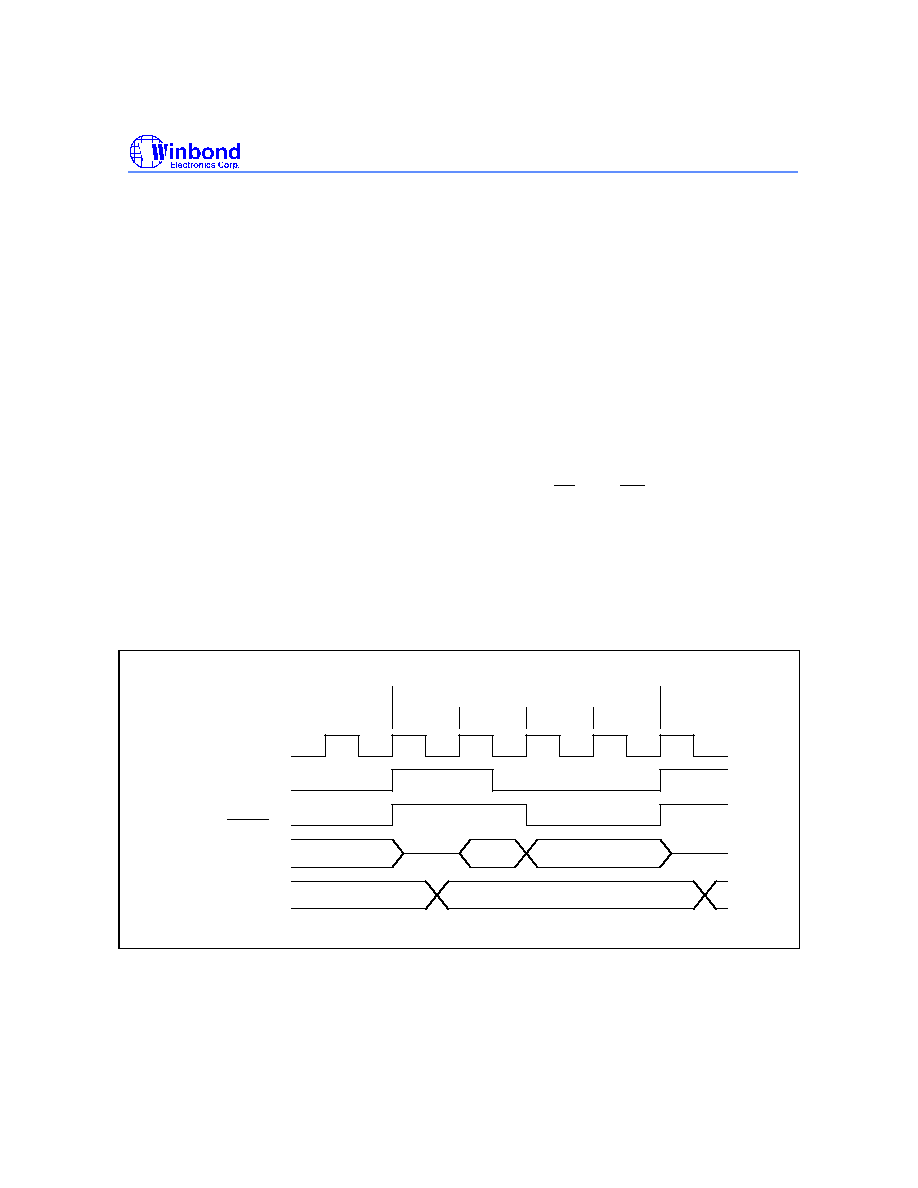
Preliminary W77E58
Publication Release Date: March 1999
- 37 - Revision A1
INSTRUCTION TIMING
The instruction timing for the W77E58 is an important aspect, especially for those users who wish to
use software instructions to generate timing delays. Also, it provides the user with an insight into the
timing differences between the W77E58 and the standard 8032. In the W77E58 each machine cycle
is four clock periods long. Each clock period is designated a state. Thus each machine cycle is made
up of four states, C1, C2 C3 and C4, in that order. Due to the reduced time for each instruction
execution, both the clock edges are used for internal timing. Hence it is important that the duty cycle
of the clock be as close to 50% as possible to avoid timing conflicts. As mentioned earlier, the
W77E58 does one op-code fetch per machine cycle. Therefore, in most of the instructions, the
number of machine cycles needed to execute the instruction is equal to the number of bytes in the
instruction. Of the 256 available op-codes, 128 of them are single cycle instructions. Thus more than
half of all op-codes in the W77E58 are executed in just four clock periods. Most of the two-cycle
instructions are those that have two byte instruction codes. However there are some instructions that
have only one byte instructions, yet they are two cycle instructions. One instruction which is of
importance is the MOVX instruction. In the standard 8032, the MOVX instruction is always two
machine cycles long. However in the W77E58, the user has a facility to stretch the duration of this
instruction from 2 machine cycles to 9 machine cycles. The
RD
and
WR
strobe lines are also
proportionately elongated. This gives the user flexibility in accessing both fast and slow peripherals
without the use of external circuitry and with minimum software overhead. The rest of the instructions
are either three, four or five machine cycle instructions. Note that in the W77E58, based on the
number of machine cycles, there are five different types, while in the standard 8032 there are only
three. However, in the W77E58 each machine cycle is made of only 4 clock periods compared to the
12 clock periods for the standard 8032. Therefore, even though the number of categories has
increased, each instruction is at least 1.5 to 3 times faster than the standard 8032 in terms of clock
periods.
Single Cycle
C4
C3
C2
C1
CLK
ALE
PSEN
AD7-0
PORT 2
A7-0
Address A15-8
Data_ in D7-0
Figure 3. Single Cycle Instruction Timing
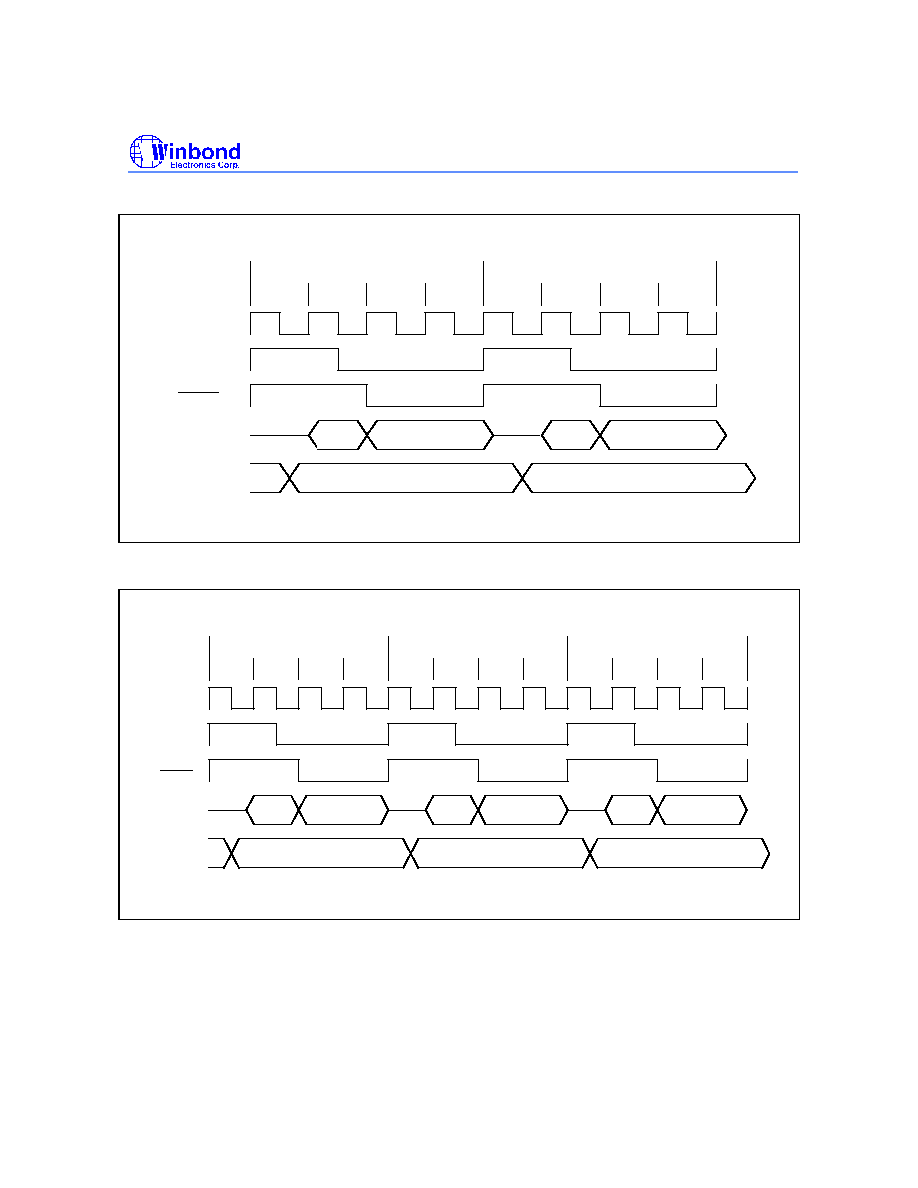
Preliminary W77E58
- 38 -
Instruction Fetch
C4
C3
C2
C1
OP-CODE
Address A15-8
Address A15-8
ALE
PSEN
PC
AD7-0
PORT 2
CLK
Operand Fetch
C4
C3
C2
C1
OPERAND
PC+1
Figure 4. Two Cycle Instruction Timing
OPERAND
OPERAND
A7-0
A7-0
A7-0
OP-CODE
Address A15-8
Address A15-8
Address A15-8
Operand Fetch
Operand Fetch
Instruction Fetch
C2
C3
C4
C2
C3
C4
C4
C3
C2
C1
C1
C1
CLK
ALE
PSEN
AD7-0
PORT 2
Figure 5. Three Cycle Instruction Timing
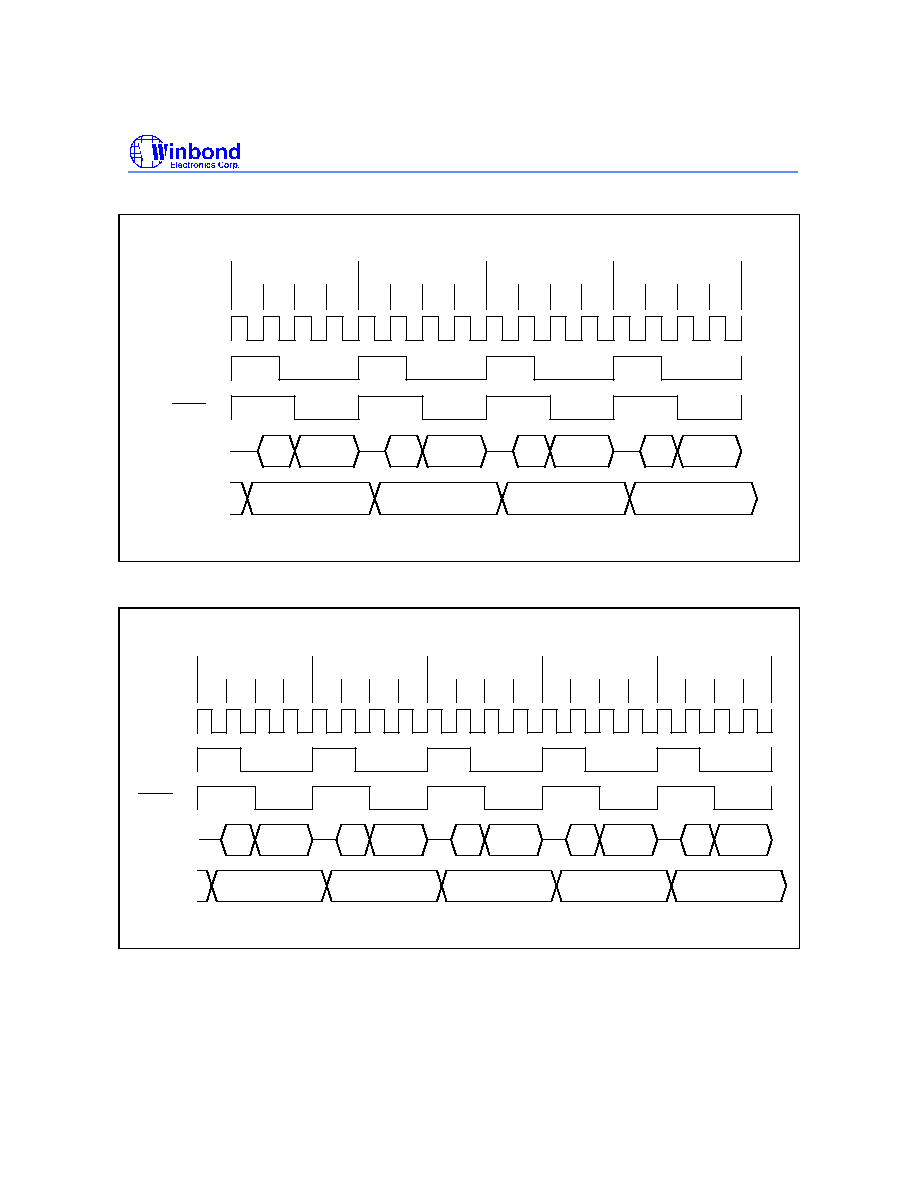
Preliminary W77E58
Publication Release Date: March 1999
- 39 - Revision A1
OPERAND
OPERAND
OPERAND
OP-CODE
Address A15-8
Address A15-8
Address A15-8
Address A15-8
A7-0
A7-0
A7-0
A7-0
Operand Fetch
Operand Fetch
Operand Fetch
Instruction Fetch
C2
C1
C4
C3
C2
C1
CLK
ALE
PSEN
AD7-0
Port 2
C4
C3
C2
C1
C4
C3
C2
C1
C4
C3
Figure 6. Four Cycle Instruction Timing
OPERAND
OPERAND
OPERAND
OP-CODE
Address A15-8
Address A15-8
Address A15-8
Address A15-8
A7-0
A7-0
A7-0
A7-0
Operand Fetch
Operand Fetch
Operand Fetch
Operand Fetch
Instruction Fetch
C2
C1
C4
C3
C2
C1
CLK
ALE
PSEN
AD7-0
PORT 2
C4
C3
C2
C1
C4
C3
C2
C1
C4
C3
C2
C1
C4
C3
OPERAND
A7-0
Address A15-8
Figure 7. Five Cycle Instruction Timing

Preliminary W77E58
- 40 -
MOVX Instruction
The W77E58, like the standard 8032, uses the MOVX instruction to access external Data Memory.
This Data Memory includes both off-chip memory as well as memory mapped peripherals. While the
results of the MOVX instruction are the same as in the standard 8032, the operation and the timing of
the strobe signals have been modified in order to give the user much greater flexibility.
The MOVX instruction is of two types, the MOVX @Ri and MOVX @DPTR. In the MOVX @Ri, the
address of the external data comes from two sources. The lower 8-bits of the address are stored in
the Ri register of the selected working register bank. The upper 8-bits of the address come from the
port 2 SFR. In the MOVX @DPTR type, the full 16-bit address is supplied by the Data Pointer.
Since the W77E58 has two Data Pointers, DPTR and DPTR1, the user has to select between the two
by setting or clearing the DPS bit. The Data Pointer Select bit (DPS) is the LSB of the DPS SFR,
which exists at location 86h. No other bits in this SFR have any effect, and they are set to 0. When
DPS is 0, then DPTR is selected, and when set to 1, DPTR1 is selected. The user can switch between
DPTR and DPTR1 by toggling the DPS bit. The quickest way to do this is by the INC instruction. The
advantage of having two Data Pointers is most obvious while performing block move operations. The
accompanying code shows how the use of two separate Data Pointers speeds up the execution time
for code performing the same task.
Block Move with single Data Pointer:
; SH and SL are the high and low bytes of Source Address
; DH and DL are the high and low bytes of Destination Address
; CNT is the number of bytes to be moved
Machine cycles of W77E58
#
MOV
R2, #CNT
; Load R2 with the count value
2
MOV
R3, #SL
; Save low byte of Source Address in R3
2
MOV
R4, #SH
; Save high byte of Source address in R4
2
MOV
R5, #DL
; Save low byte of Destination Address in R5
2
MOV
R6, #DH
; Save high byte of Destination address in R6
2
LOOP:
MOV
DPL, R3
; Load DPL with low byte of Source address
2
MOV
DPH, R4
; Load DPH with high byte of Source address
2
MOVX A, @DPTR
; Get byte from Source to Accumulator
2
INC
DPTR
; Increment Source Address to next byte
2
MOV
R3, DPL
; Save low byte of Source address in R3
2
MOV
R4, DPH
; Save high byte of Source Address in R4
2
MOV
DPL, R5
; Load low byte of Destination Address in DPL
2
MOV
DPH, R6
; Load high byte of Destination Address in DPH
2
MOVX @DPTR, A
; Write data to destination
2
INC
DPTR
; Increment Destination Address
2
MOV
DPL, R5
; Save low byte of new destination address in R5
2
MOV
DPH, R6
; Save high byte of new destination address in R6
2
DJNZ
R2, LOOP
; Decrement count and do LOOP again if count <> 0
2

Preliminary W77E58
Publication Release Date: March 1999
- 41 - Revision A1
Machine cycles in standard 8032 = 10 + (26 * CNT)
Machine cycles in W77E58 = 10 + (26 * CNT)
If CNT = 50
Clock cycles in standard 8032= ((10 + (26 *50)) * 12 = (10 + 1300) * 12 = 15720
Clock cycles in W77E58 = ((10 + (26 * 50)) * 4 = (10 + 1300) * 4 = 5240
Block Move with Two Data Pointers in W77E58:
; SH and SL are the high and low bytes of Source Address
; DH and DL are the high and low bytes of Destination Address
; CNT is the number of bytes to be moved
Machine cycles of W77E58
#
MOV
R2, #CNT
; Load R2 with the count value
2
MOV
DPS, #00h
; Clear DPS to point to DPTR
2
MOV
DPTR, #DHDL ; Load DPTR with Destination address
3
INC
DPS
; Set DPS to point to DPTR1
2
MOV
DPTR, #SHSL ; Load DPTR1 with Source address
3
LOOP:
MOVX A, @DPTR
; Get data from Source block
2
INC
DPTR
; Increment source address
2
DEC
DPS
; Clear DPS to point to DPTR
2
MOVX @DPTR, A
; Write data to Destination
2
INC
DPTR
; Increment destination address
2
INC
DPS
; Set DPS to point to DPTR1
2
DJNZ
R2, LOOP
; Check if all done
3
Machine cycles in W77E58 = 12 + (15 * CNT)
If CNT = 50
Clock cycles in W77E58 = (12 + (15 * 50)) * 4 = (12 + 750) * 4 = 3048
We can see that in the first program the standard 8032 takes 15720 cycles, while the W77E58 takes
only 5240 cycles for the same code. In the second program, written for the W77E58, program
execution requires only 3048 clock cycles. If the size of the block is increased then the saving is even
greater.
External Data Memory Access Timing:
The timing for the MOVX instruction is another feature of the W77E58. In the standard 8032, the
MOVX instruction has a fixed execution time of 2 machine cycles. However in the W77E58, the
duration of the access can be varied by the user.
The instruction starts off as a normal op-code fetch of 4 clocks. In the next machine cycle, the
W77E58 puts out the address of the external Data Memory and the actual access occurs here. The
user can change the duration of this access time by setting the STRETCH value. The Clock Control
SFR (CKCON) has three bits that control the stretch value. These three bits are M2-0 (bits 2-0 of
CKCON). These three bits give the user 8 different access time options. The stretch can be varied
from 0 to 7, resulting in MOVX instructions that last from 2 to 9 machine cycles in length. Note that
the stretching of the instruction only results in the elongation of the MOVX instruction, as if the state

Preliminary W77E58
- 42 -
of the CPU was held for the desired period. There is no effect on any other instruction or its timing. By
default, the Stretch value is set at 1, giving a MOVX instruction of 3 machine cycles. If desired by the
user the stretch value can be set to 0 to give the fastest MOVX instruction of only 2 machine cycles.
Table 4. Data Memory Cycle Stretch Values
M2
M1
M0
Machine
Cycles
RD
or
WR
strobe width
in Clocks
RD
or
WR
strobe width
@ 25 MHz
RD
or
WR
strobe width
@ 40 MHz
0
0
0
2
2
80 nS
50 nS
0
0
1
3(default)
4
160 nS
100 nS
0
1
0
4
8
320 nS
200 nS
0
1
1
5
12
480 nS
300 nS
1
0
0
6
16
640 nS
400 nS
1
0
1
7
20
800 nS
500 nS
1
1
0
8
24
960 nS
600 nS
1
1
1
9
28
1120 nS
700 nS
Next Instruction
Machine Cycle
Second
Machine cycle
First
Machine cycle
Last Cycle
of Previous
Instruction
C4
PORT 2
PORT 0
WR
PSEN
ALE
CLK
C3
C2
D0-D7
A0-A7
D0-D7
A0-A7
D0-D7
A0-A7
D0-D7
A15-A8
A15-A8
A15-A8
A15-A8
A0-A7
C1
C4
C3
C2
C1
C4
C3
C2
C1
C4
C3
C2
C1
MOVX instruction cycle
Next Inst. Read
Next Inst.
Address
MOVX Data out
MOVX Data
Address
MOVX Inst.
Address
MOVX Inst
.
Figure 8. Data Memory Write with Stretch Value = 0
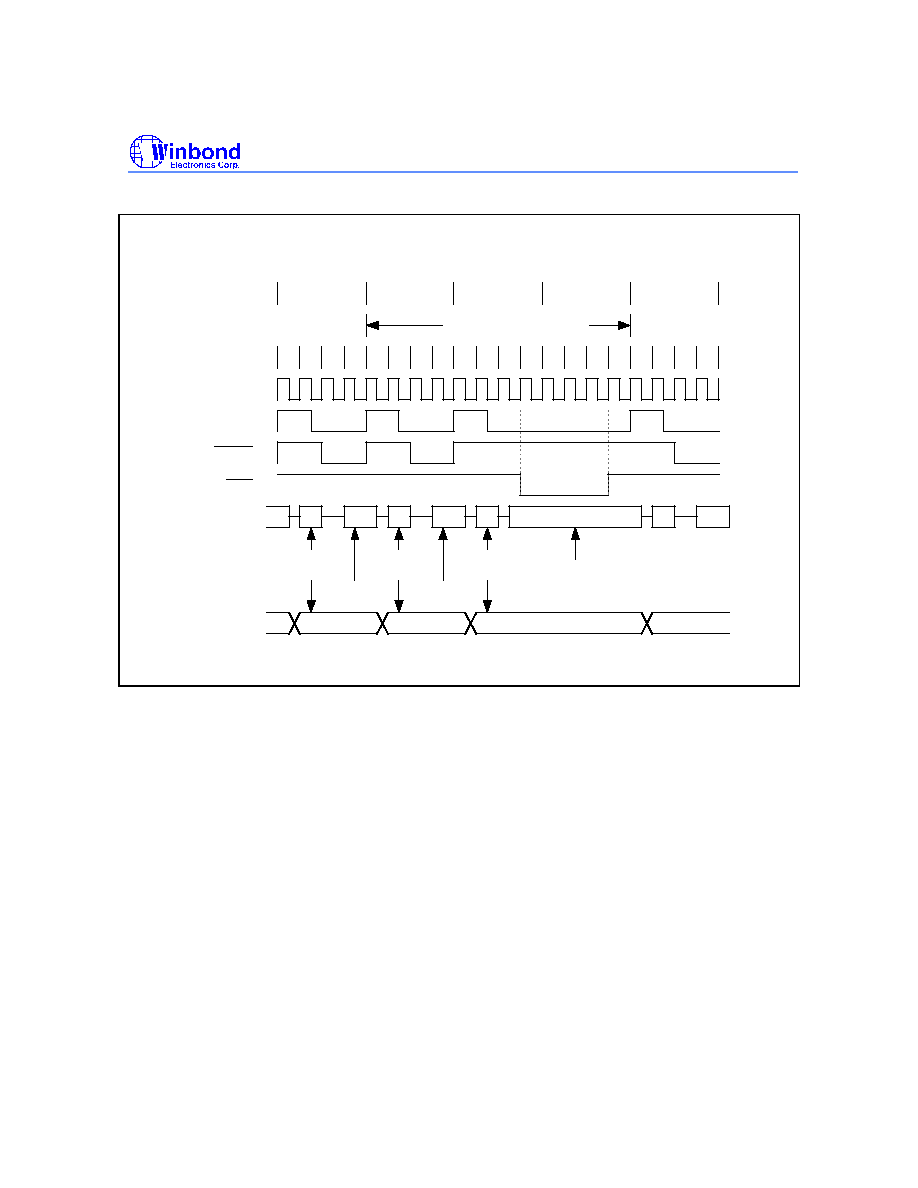
Preliminary W77E58
Publication Release Date: March 1999
- 43 - Revision A1
Next Instruction
Machine Cycle
Third
Machine Cycle
Second
Machine Cycle
First
Machine Cycle
Last Cycle
of Previous
Instruction
C4
PORT 2
PORT 0
WR
PSEN
ALE
CLK
C3
C2
D0-D7
A0-A7
D0-D7
A0-A7
D0-D7
A0-A7
D0-D7
A15-A8
A15-A8
A15-A8
A15-A8
A0-A7
C1
C4
C3
C2
C1
C4
C3
C2
C1
C4
C3
C2
C1
MOVX instruction cycle
Next Inst.
Read
Next Inst.
Address
MOVX Data out
MOVX Data
Address
MOVX Inst.
Address
MOVX Inst.
C4
C3
C2
C1
Figure 9. Data Memory Write with Stretch Value = 1

Preliminary W77E58
- 44 -
Next
Instruction
Machine Cycle
Fourth
Machine Cycle
Third
Machine Cycle
Second
Machine Cycle
First
Machine Cycle
Last Cycle
of Previous
Instruction
C4
PORT 2
PORT 0
WR
PSEN
ALE
CLK
C3
C2
D0-D7
A0-A7
D0-D7
A0-A7
D0-D7
A0-A7
D0-D7
A15-A8
A15-A8
A15-A8
A15-A8
A0-A7
C1
C4
C3
C2
C1
C4
C3
C2
C1
C4
C3
C2
C1
MOVX instruction cycle
Next Inst.
Read
Next Inst.
Address
MOVX Data out
MOVX Data
Address
MOVX Inst.
Address
MOVX Inst.
C4
C3
C2
C1
C4
C3
C2
C1
Figure 10. Data Memory Write with Stretch Value = 2
Wait State Control Signal
Either with the software using stretch value to change the required machine cycle of MOVX
instruction, the W77E58 provides another hardware signal
WAIT
to implement the wider duration of
external data access timing. This wait state control signal is the alternate function of P4.0 such that it
can only be invoked to 44-pin PLCC/QFP package type. The wait state control signal can be enabled
by setting WS (ROMMAP.7) bit. When enabled, the setting of stretch value decides the minimum
length of MOVX instruction cycle and the device will sample the
WAIT
pin at each C3 state before
the rising edge of read/write strobe signal during MOVX instruction. Once this signal being
recongnized, one more machine cycle (wait state cycle) will be inserted into next cycle. The inserted
wait state cycles are unlimited, so the MOVX instruction cycle will end in which the wait state control
signal is deactivated. Using wait state control signal allows a dynamically access timimg to a selected
external peripheral. The WS bit is accessed by the Timed Access Protection procedure.

Preliminary W77E58
Publication Release Date: March 1999
- 45 - Revision A1
Wait State Control Signal Timing ( when Stretch = 1 )
C2 C3
C4
C1
CLOCK
ALE
PSEN
ADDRESS
RD / WR
C2 C3
C4
C1
C2 C3 C4
C1
C2 C3
C4
C1
C2 C3 C4
C1
MOVX Instruction
First
Machine
Cycle
Second
Machine
Cycle
Wait-State
Cycle
Third
Machine
Cycle
WAIT
sample
WAIT
sample WAIT
Extended duration
original rising edge
Wait State Control Signal Timing ( when Stretch = 2 )
C2 C3
C4
C1
CLOCK
ALE
PSEN
ADDRESS
RD / WR
C2 C3
C4
C1
C2 C3
C4
C1
C2 C3
C4
C1
C3
C4
C2
C1
MOVX Instruction
First
Machine
Cycle
Second
Machine
Cycle
Wait-State
Cycle
Third
Machine
Cycle
WAIT
sample
WAIT
sample WAIT
Extended duration
original rising edge
C2
C1
Cycle
Fourth
Machine

Preliminary W77E58
- 46 -
POWER MANAGEMENT
The W77E58 has several features that help the user to control the power consumption of the device.
The power saving features are basically the POWER DOWN mode, ECONOMY mode and the IDLE
mode of operation.
Idle Mode
The user can put the device into idle mode by writing 1 to the bit PCON.0. The instruction that sets
the idle bit is the last instruction that will be executed before the device goes into Idle Mode. In the
Idle mode, the clock to the CPU is halted, but not to the Interrupt, Timer, Watchdog timer and Serial
port blocks. This forces the CPU state to be frozen; the Program counter, the Stack Pointer, the
Program Status Word, the Accumulator and the other registers hold their contents. The ALE and
PSEN pins are held high during the Idle state. The port pins hold the logical states they had at the
time Idle was activated. The Idle mode can be terminated in two ways. Since the interrupt controller is
still active, the activation of any enabled interrupt can wake up the processor. This will automatically
clear the Idle bit, terminate the Idle mode, and the Interrupt Service Routine(ISR) will be executed.
After the ISR, execution of the program will continue from the instruction which put the device into
Idle mode.
The Idle mode can also be exited by activating the reset. The device can be put into reset either by
applying a high on the external RST pin, a Power on reset condition or a Watchdog timer reset. The
external reset pin has to be held high for at least two machine cycles i.e. 8 clock periods to be
recognized as a valid reset. In the reset condition the program counter is reset to 0000h and all the
SFRs are set to the reset condition. Since the clock is already running there is no delay and execution
starts immediately. In the Idle mode, the Watchdog timer continues to run, and if enabled, a time-out
will cause a watchdog timer interrupt which will wake up the device. The software must reset the
Watchdog timer in order to preempt the reset which will occur after 512 clock periods of the time-out.
When the W77E58 is exiting from an Idle mode with a reset, the instruction following the one which
put the device into Idle mode is not executed. So there is no danger of unexpected writes.
Economy Mode
The power consumption of microcontroller relates to operating frequency. The W77E58 offers a
Economy mode to reduce the internal clock rate dynamically without external components. By
default, one machine cycle needs 4 clocks. In Economy mode, software can select 4, 64 or 1024
clocks per machine cycle. It keeps the CPU operating at a acceptable speed but eliminates the power
consumption. In the Idle mode, the clock of the core logic is stopped, but all clocked peripherals such
as watchdog timer are still running at a rate of clock/4. In the Economy mode, all clocked peripherals
run at the same reduced clocks rate as in core logic. So the Economy mode may provide a lower
power consumption than idle mode.
Software invokes the Economy mode by setting the appropriate bits in the SFRs. Setting the bits
CD0(PMR.6), CD1(PMR.7) decides the instruction cycle rate as below:
CD1 CD0 clocks/machine cycle
0 0 Reserved
0 1 4 (default)
1 0 64
1 1 1024

Preliminary W77E58
Publication Release Date: March 1999
- 47 - Revision A1
The selection of instruction rate is going to take effect after a delay of one instruction cycle. Switching
to divide by 64 or 1024 mode must first go from divide by 4 mode. This means software can not
switch directly between clock/64 and clock/1024 mode. The CPU has to return clock/4 mode first,
then go to clock/64 or clock/1024 mode.
The W77E58 allows the user to use internal RC oscillator instead of external crystal. Setting the
XT/ RG bit (EXIF.3) selects the crystal or RC oscillator as the clock source. When invoking RC
oscillator in Economy mode, software may set the XTOFF bit to turn off the crystal amplifier for
saving power. The CPU would run at the clock rate of approximately 2
-
4 MHz divided by 4, 64 or
1024. The RC oscillator is not precise so that can not be invoked to the operation which needs the
accurate time-base such as serial communication. The RGMD(EXIF.2) indicates current clock source.
When switching the clock source, CPU needs one instruction cycle delay to take effect new setting. If
crystal amplifier is disabled and RC oscillator is present clock source, software must first clear the
XTOFF bit to turn on crystal amplifier before switch to crystal operation. Hardware will set the XTUP
bit (STATUS.4) once the crystal is warm-up and ready for use. It is unable to set XT/ RG bit to 1 if
XTUP = 0.
In Economy mode, the serial port can not receive/transmit data correctly because the baud rate is
changed. In some systems, the external interrupts may require the fastest process such that the
reducing of operating speed is restricted. In order to solve these dilemmas, the W77E58 offers a
switchback feature which allows the CPU back to clock/4 mode immediately when triggered by serial
operation or external interrupts. The switchback feature is enabled by setting the SWB bit (PMR.5). A
serial port reception/transmission or qualified external interrupt which is enabled and acknowledged
without block conditions will cause CPU to return to divide by 4 mode. For the serial port reception, a
switchback is generated by a falling edge associated with start bit if the serial port reception is
enabled. When a serial port transmission, an instruction which writes a byte of data to serial port
buffer will cause a switchback to ensure the correct transmission. The switchback feature is
unaffected by serial port interrupt flags. After a switchback is generated, the software can manually
return the CPU to Economy mode. Note that the modification of clock control bits CD0 and CD1 will
be ignored during serial port transmit/receive when switchback is enabled. The Watchdog timer reset,
power-on/fail reset or external reset will force the CPU to return to divide by 4 mode.
Power Down Mode
The device can be put into Power Down mode by writing 1 to bit PCON.1. The instruction that does
this will be the last instruction to be executed before the device goes into Power Down mode. In the
Power Down mode, all the clocks are stopped and the device comes to a halt. All activity is
completely stopped and the power consumption is reduced to the lowest possible value. In this state
the ALE and PSEN pins are pulled low. The port pins output the values held by their respective
SFRs.
The W77E58 will exit the Power Down mode with a reset or by an external interrupt pin enabled as
level detect. An external reset can be used to exit the Power down state. The high on RST pin
terminates the Power Down mode, and restarts the clock. The program execution will restart from
0000h. In the Power down mode, the clock is stopped, so the Watchdog timer cannot be used to
provide the reset to exit Power down mode.
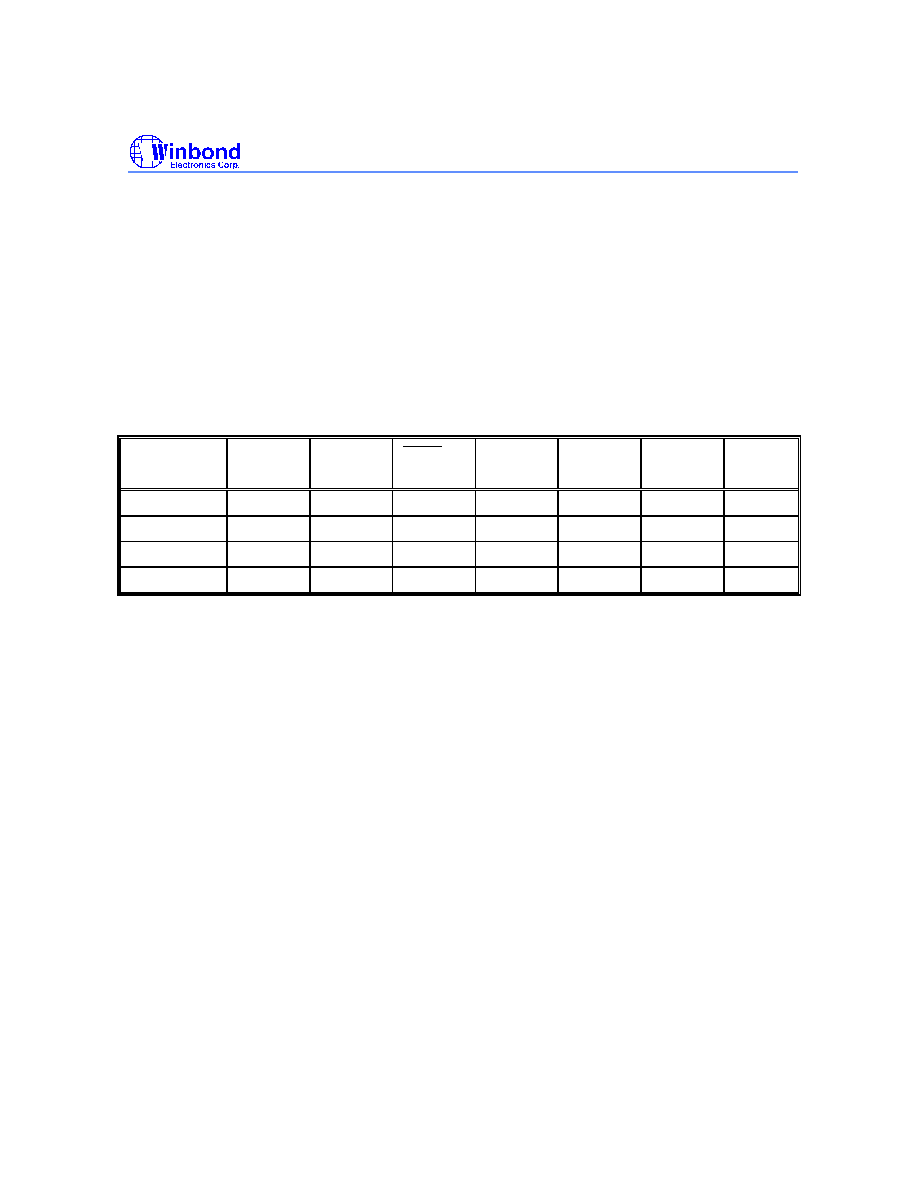
Preliminary W77E58
- 48 -
The W77E58 can be woken from the Power Down mode by forcing an external interrupt pin activated,
provided the corresponding interrupt is enabled, while the global enable(EA) bit is set and the external
input has been set to a level detect mode. If these conditions are met, then the low level on the
external pin re-starts the oscillator. Then device executes the interrupt service routine for the
corresponding external interrupt. After the interrupt service routine is completed, the program
execution returns to the instruction after the one which put the device into Power Down mode and
continues from there. When RGSL(EXIF.1) bit is set to 1, the CPU will use the internal RC oscillator
instead of crystal to exit Power Down mode. The microcontroller will automatically switch from RC
oscillator to crystal after clock is stable. The RC oscillator runs at approximately 2
-
4 MHz. Using RC
oscillator to exit from Power Down mode saves the time for waiting crystal start-up. It is useful in the
low power system which usually be awakened from a short operation then returns to Power Down
mode.
Table 5. Status of external pins during Idle and Power Down
Mode
Program
Memory
ALE
PSEN
PORT0
PORT1
PORT2
PORT3
Idle
Internal
1
1
Data
Data
Data
Data
Idle
External
1
1
Float
Data
Address
Data
Power Down
Internal
0
0
Data
Data
Data
Data
Power Down
External
0
0
Float
Data
Data
Data
RESET CONDITIONS
The user has several hardware related options for placing the W77E58 into reset condition. In
general, most register bits go to their reset value irrespective of the reset condition, but there are a
few flags whose state depends on the source of reset. The user can use these flags to determine the
cause of reset using software. There are two ways of putting the device into reset state. They are
External reset and Watchdog reset.
External Reset
The device continuously samples the RST pin at state C4 of every machine cycle. Therefore the RST
pin must be held for at least 2 machine cycles to ensure detection of a valid RST high. The reset
circuitry then synchronously applies the internal reset signal. Thus the reset is a synchronous
operation and requires the clock to be running to cause an external reset.
Once the device is in reset condition, it will remain so as long as RST is 1. Even after RST is
deactivated, the device will continue to be in reset state for up to two machine cycles, and then begin
program execution from 0000h. There is no flag associated with the external reset condition. However
since the other two reset sources have flags, the external reset can be considered as the default reset
if those two flags are cleared.
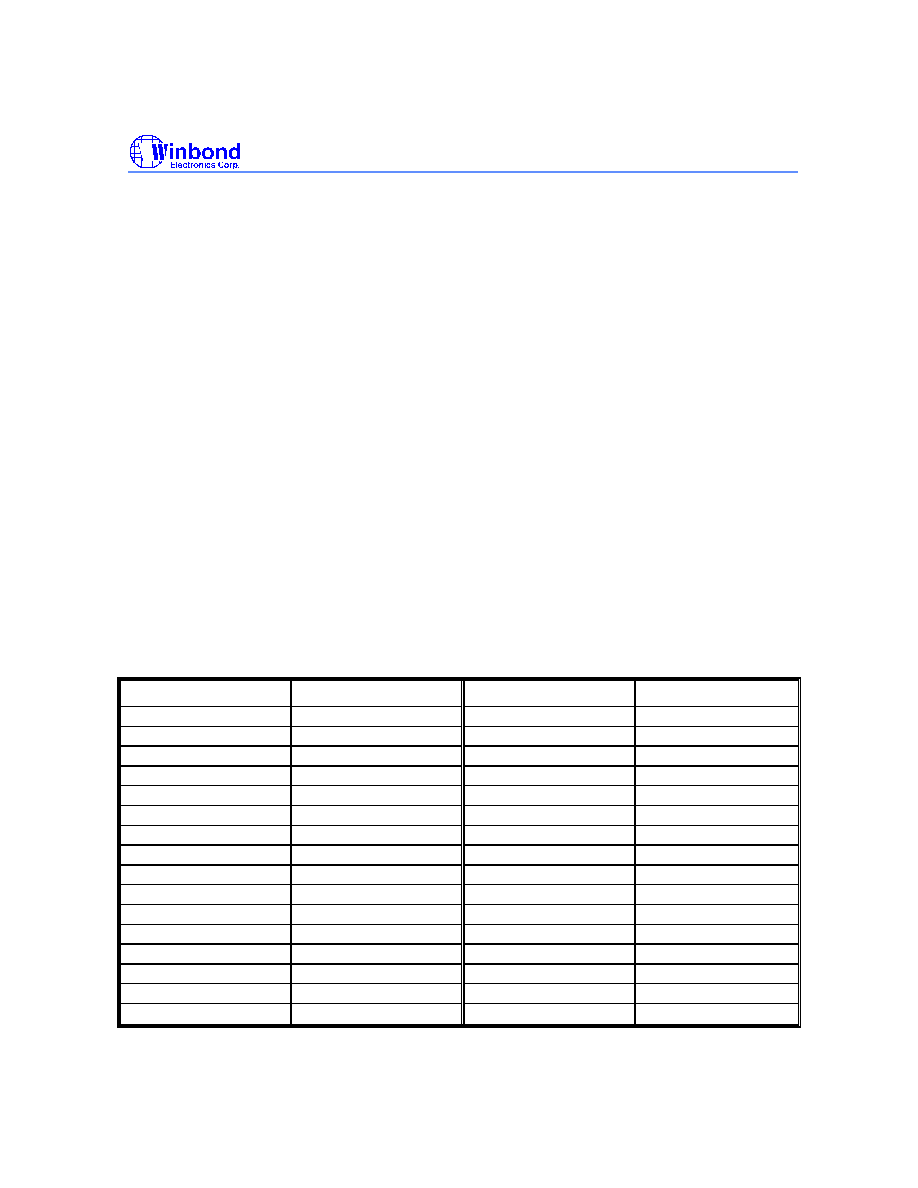
Preliminary W77E58
Publication Release Date: March 1999
- 49 - Revision A1
The software must clear the POR flag after reading it, otherwise it will not be possible to correctly
determine future reset sources. If the power fails, i.e. falls below Vrst, then the device will once again
go into reset state. When the power returns to the proper operating levels, the device will again
perform a power on reset delay and set the POR flag.
Watchdog Timer Reset
The Watchdog timer is a free running timer with programmable time-out intervals. The user can clear
the watchdog timer at any time, causing it to restart the count. When the time-out interval is reached
an interrupt flag is set. If the Watchdog reset is enabled and the watchdog timer is not cleared, then
512 clocks from the flag being set, the watchdog timer will generate a reset . This places the device
into the reset condition. The reset condition is maintained by hardware for two machine cycles. Once
the reset is removed the device will begin execution from 0000h.
RESET STATE
Most of the SFRs and registers on the device will go to the same condition in the reset state. The
Program Counter is forced to 0000h and is held there as long as the reset condition is applied.
However, the reset state does not affect the on-chip RAM. The data in the RAM will be preserved
during the reset. However, the stack pointer is reset to 07h, and therefore the stack contents will be
lost. The RAM contents will be lost if the V
DD
falls below approximately 2V, as this is the minimum
voltage level required for the RAM to operate normally. Therefore after a first time power on reset the
RAM contents will be indeterminate. During a power fail condition, if the power falls below 2V, the
RAM contents are lost.
After a reset most SFRs are cleared. Interrupts and Timers are disabled. The Watchdog timer is
disabled if the reset source was a POR. The port SFRs have FFh written into them which puts the
port pins in a high state. Port 0 floats as it does not have on-chip pull-ups.
Table 6. SFR Reset Value
SFR Name
Reset Value
SFR Name
Reset Value
P0
11111111b
IE
00000000b
SP
00000111b
SADDR
00000000b
DPL
00000000b
P3
11111111b
DPH
00000000b
IP
x0000000b
DPL1
00000000b
SADEN
00000000b
DPH1
00000000b
T2CON
00000000b
DPS
00000000b
T2MOD
00000x00b
PCON
00xx0000b
RCAP2L
00000000b
TCON
00000000b
RCAP2H
00000000b
TMOD
00000000b
TL2
00000000b
TL0
00000000b
TH2
00000000b
TL1
00000000b
TA
11111111b
TH0
00000000b
PSW
00000000b
TH1
00000000b
WDCON
0x0x0xx0b
CKCON
00000001b
ACC
00000000b
P1
11111111b
EIE
xxx
00000b

Preliminary W77E58
- 50 -
Table 6. SFR Reset Value, continued
SFR Name
Reset Value
SFR Name
Reset Value
SCON
00000000b
B
00000000b
SBUF
xxxxxxxx
b
EIP
xxx00000b
P2
11111111b
PC
00000000b
SADDR1
00000000b
SADEN1
00000000b
SCON1
00000000b
SBUF1
xxxxxxxx
b
ROMMAP
01
xxx
110b
PMR
010xx0x0b
EXIF
0000
xxx
0b
STATUS
000x0000b
P4
xxxx
1111b
The WDCON SFR bits are set/cleared in reset condition depending on the source of the reset.
External reset
Watchdog reset
Power on reset
WDCON
0x0x0xx0b
0x0x01x0b
01000000b
The POR bit WDCON.6 is set only by the power on reset. The PFI bit WDCON.4 is set when the
power fail condition occurs. However, a power-on reset will clear this bit. The WTRF bit WDCON.2 is
set when the Watchdog timer causes a reset. A power on reset will also clear this bit. The EWT bit
WDCON.1 is cleared by power on resets. This disables the Watchdog timer resets. A watchdog or
external reset does not affect the EWT bit.
INTERRUPTS
The W77E58 has a two priority level interrupt structure with 12 interrupt sources. Each of the interrupt
sources has an individual priority bit, flag, interrupt vector and enable bit. In addition, the interrupts
can be globally enabled or disabled.
Interrupt Sources
The External Interrupts INT0 and
INT1
can be either edge triggered or level triggered, depending on
bits IT0 and IT1. The bits IE0 and IE1 in the TCON register are the flags which are checked to
generate the interrupt. In the edge triggered mode, the INTx inputs are sampled in every machine
cycle. If the sample is high in one cycle and low in the next, then a high to low transition is detected
and the interrupts request flag IEx in TCON or EXIF is set. The flag bit requests the interrupt. Since
the external interrupts are sampled every machine cycle, they have to be held high or low for at least
one complete machine cycle. The IEx flag is automatically cleared when the service routine is called.
If the level triggered mode is selected, then the requesting source has to hold the pin low till the
interrupt is serviced. The IEx flag will not be cleared by the hardware on entering the service routine.
If the interrupt continues to be held low even after the service routine is completed, then the
processor may acknowledge another interrupt request from the same source. Note that the external
interrupts INT2 to INT5 are edge triggered only. By default, the individual interrupt flag corresponding
to external interrupt 2 to 5 must be cleared manually by software. It can be configured with hardware
cleared by setting the corresponding bit HCx in the T2MOD register. For instance, if HC2 is set
hardware will clear IE2 flag after program enters the interrupt 2 service routine.
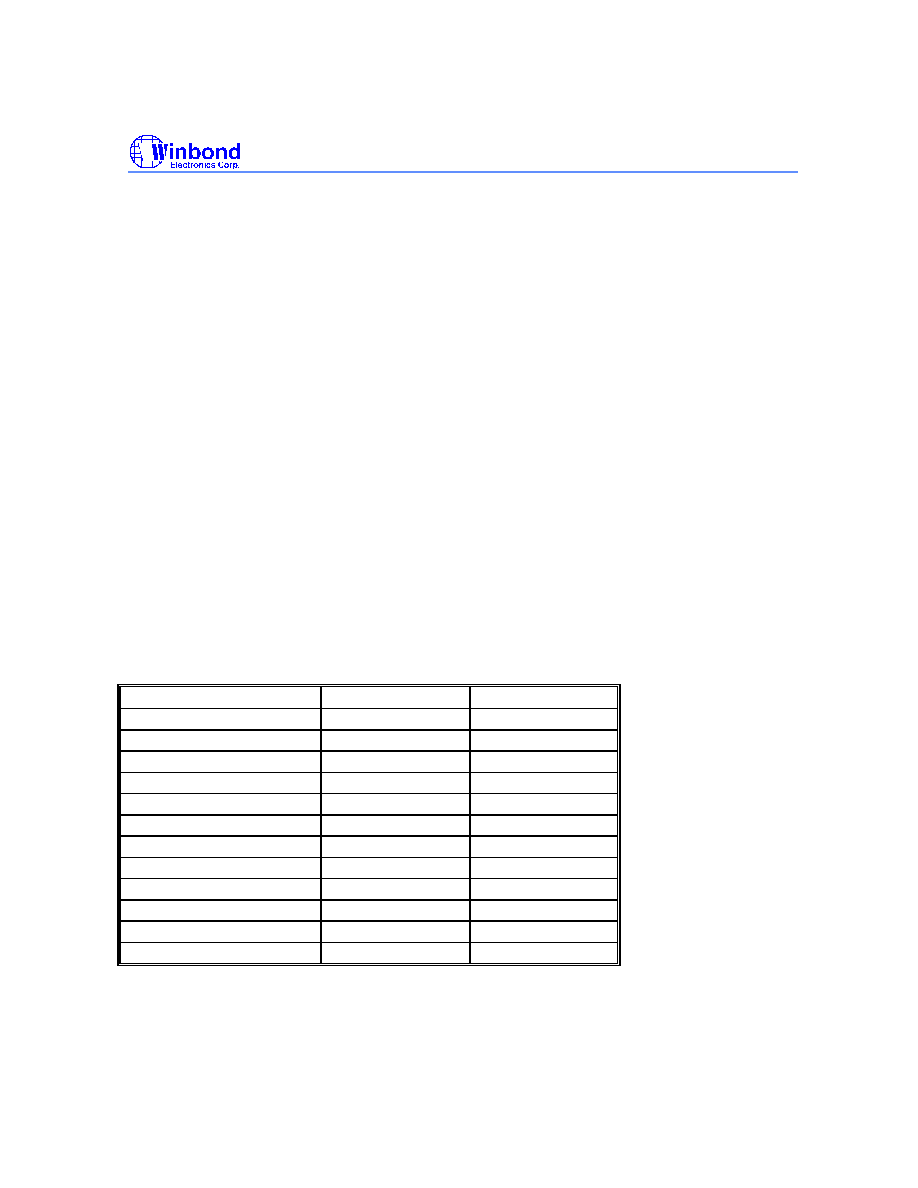
Preliminary W77E58
Publication Release Date: March 1999
- 51 - Revision A1
The Timer 0 and 1 Interrupts are generated by the TF0 and TF1 flags. These flags are set by the
overflow in the Timer 0 and Timer 1. The TF0 and TF1 flags are automatically cleared by the
hardware when the timer interrupt is serviced. The Timer 2 interrupt is generated by a logical OR of
the TF2 and the EXF2 flags. These flags are set by overflow or capture/reload events in the timer 2
operation. The hardware does not clear these flags when a timer 2 interrupt is executed. Software has
to resolve the cause of the interrupt between TF2 and EXF2 and clear the appropriate flag.
The Watchdog timer can be used as a system monitor or a simple timer. In either case, when the
time-out count is reached, the Watchdog timer interrupt flag WDIF (WDCON.3) is set. If the interrupt
is enabled by the enable bit EIE.4, then an interrupt will occur.
The Serial block can generate interrupts on reception or transmission. There are two interrupt sources
from the Serial block, which are obtained by the RI and TI bits in the SCON SFR and RI_1 and TI_1
in the SCON1 SFR. These bits are not automatically cleared by the hardware, and the user will have
to clear these bits using software.
All the bits that generate interrupts can be set or reset by hardware, and thereby software initiated
interrupts can be generated. Each of the individual interrupts can be enabled or disabled by setting or
clearing a bit in the IE SFR. IE also has a global enable/disable bit EA, which can be cleared to
disable all the interrupts, except PFI, at once.
Priority Level Structure
There are three priority levels for the interrupts, highest, high and low. The interrupt sources can be
individually set to either high or low levels. Naturally, a higher priority interrupt cannot be interrupted
by a lower priority interrupt. However there exists a pre-defined hierarchy amongst the interrupts
themselves. This hierarchy comes into play when the interrupt controller has to resolve simultaneous
requests having the same priority level. This hierarchy is defined as shown below; the interrupts are
numbered starting from the highest priority to the lowest.
Table 7. Priority structure of interrupts
Source
Flag
Priority level
External Interrupt 0
IE0
1(highest)
Timer 0 Overflow
TF0
2
External Interrupt 1
IE1
3
Timer 1 Overflow
TF1
4
Serial Port
RI + TI
5
Timer 2 Overflow
TF2 + EXF2
6
Serial Port 1
RI_1 + TI_1
7
External Interrupt 2
IE2
8
External Interrupt 3
IE3
9
External Interrupt 4
IE4
10
External Interrupt 5
IE5
11
Watchdog Timer
WDIF
12 (lowest)

Preliminary W77E58
- 52 -
The interrupt flags are sampled every machine cycle. In the same machine cycle, the sampled
interrupts are polled and their priority is resolved. If certain conditions are met then the hardware will
execute an internally generated LCALL instruction which will vector the process to the appropriate
interrupt vector address. The conditions for generating the LCALL are
1. An interrupt of equal or higher priority is not currently being serviced.
2. The current polling cycle is the last machine cycle of the instruction currently being executed.
3. The current instruction does not involve a write to IP, IE, EIP or EIE registers and is not a RETI.
If any of these conditions are not met, then the LCALL will not be generated. The polling cycle is
repeated every machine cycle, with the interrupts sampled in the same machine cycle. If an interrupt
flag is active in one cycle but not responded to, and is not active when the above conditions are met,
the denied interrupt will not be serviced. This means that active interrupts are not remembered; every
polling cycle is new.
The processor responds to a valid interrupt by executing an LCALL instruction to the appropriate
service routine. This may or may not clear the flag which caused the interrupt. In case of Timer
interrupts, the TF0 or TF1 flags are cleared by hardware whenever the processor vectors to the
appropriate timer service routine. In case of external interrupt, INT0 and INT1, the flags are cleared
only if they are edge triggered. In case of Serial interrupts, the flags are not cleared by hardware. In
the case of Timer 2 interrupt, the flags are not cleared by hardware. The Watchdog timer interrupt
flag WDIF has to be cleared by software. The hardware LCALL behaves exactly like the software
LCALL instruction. This instruction saves the Program Counter contents onto the Stack, but does not
save the Program Status Word PSW. The PC is reloaded with the vector address of that interrupt
which caused the LCALL. These vector address for the different sources are as follows
Table 8. Vector locations for interrupt sources
Source
Vector Address
Source
Vector Address
Timer 0 Overflow
000Bh
External Interrupt 0
0003h
Timer 1 Overflow
001Bh
External Interrupt 1
0013h
Timer 2 Interrupt
002Bh
Serial Port
0023h
External Interrupt 2
0043h
Serial Port 1
003Bh
External Interrupt 4
0053h
External Interrupt 3
004Bh
Watchdog Timer
0063h
External Interrupt 5
005Bh
The vector table is not evenly spaced; this is to accommodate future expansions to the device family.

Preliminary W77E58
Publication Release Date: March 1999
- 53 - Revision A1
Execution continues from the vectored address till an RETI instruction is executed. On execution of
the RETI instruction the processor pops the Stack and loads the PC with the contents at the top of the
stack. The user must take care that the status of the stack is restored to what is was after the
hardware LCALL, if the execution is to return to the interrupted program. The processor does not
notice anything if the stack contents are modified and will proceed with execution from the address
put back into PC. Note that a RET instruction would perform exactly the same process as a RETI
instruction, but it would not inform the Interrupt Controller that the interrupt service routine is
completed, and would leave the controller still thinking that the service routine is underway.
Interrupt Response Time
The response time for each interrupt source depends on several factors, such as the nature of the
interrupt and the instruction underway. In the case of external interrupts INT0 to INT5 , they are
sampled at C3 of every machine cycle and then their corresponding interrupt flags IEx will be set or
reset. The Timer 0 and 1 overflow flags are set at C3 of the machine cycle in which overflow has
occurred. These flag values are polled only in the next machine cycle. If a request is active and all
three conditions are met, then the hardware generated LCALL is executed. This LCALL itself takes
four machine cycles to be completed. Thus there is a minimum time of five machine cycles between
the interrupt flag being set and the interrupt service routine being executed.
A longer response time should be anticipated if any of the three conditions are not met. If a higher or
equal priority is being serviced, then the interrupt latency time obviously depends on the nature of the
service routine currently being executed. If the polling cycle is not the last machine cycle of the
instruction being executed, then an additional delay is introduced. The maximum response time (if no
other interrupt is in service) occurs if the W77E58 is performing a write to IE, IP, EIE or EIP and then
executes a MUL or DIV instruction. From the time an interrupt source is activated, the longest
reaction time is 12 machine cycles. This includes 1 machine cycle to detect the interrupt, 2 machine
cycles to complete the IE, IP, EIE or EIP access, 5 machine cycles to complete the MUL or DIV
instruction and 4 machine cycles to complete the hardware LCALL to the interrupt vector location.
Thus in a single-interrupt system the interrupt response time will always be more than 5 machine
cycles and not more than 12 machine cycles. The maximum latency of 12 machine cycle is 48 clock
cycles. Note that in the standard 8051 the maximum latency is 8 machine cycles which equals 96
machine cycles. This is a 50% reduction in terms of clock periods.
PROGRAMMABLE TIMERS/COUNTERS
The W77E58 has three 16-bit programmable timer/counters and one programmable Watchdog timer.
The Watchdog timer is operationally quite different from the other two timers.
TIMER/COUNTERS 0 & 1
The W77E58 has two 16-bit Timer/Counters. Each of these Timer/Counters has two 8 bit registers
which form the 16 bit counting register. For Timer/Counter 0 they are TH0, the upper 8 bits register,
and TL0, the lower 8 bit register. Similarly Timer/Counter 1 has two 8 bit registers, TH1 and TL1. The
two can be configured to operate either as timers, counting machine cycles or as counters counting
external inputs.

Preliminary W77E58
- 54 -
When configured as a "Timer", the timer counts clock cycles. The timer clock can be programmed to
be thought of as 1/12 of the system clock or 1/4 of the system clock. In the "Counter" mode, the
register is incremented on the falling edge of the external input pin, T0 in case of Timer 0, and T1 for
Timer 1. The T0 and T1 inputs are sampled in every machine cycle at C4. If the sampled value is
high in one machine cycle and low in the next, then a valid high to low transition on the pin is
recognized and the count register is incremented. Since it takes two machine cycles to recognize a
negative transition on the pin, the maximum rate at which counting will take place is 1/24 of the
master clock frequency. In either the "Timer" or "Counter" mode, the count register will be updated at
C3. Therefore, in the "Timer" mode, the recognized negative transition on pin T0 and T1 can cause
the count register value to be updated only in the machine cycle following the one in which the
negative edge was detected.
The "Timer" or "Counter" function is selected by the " C T
/
" bit in the TMOD Special Function
Register. Each Timer/Counter has one selection bit for its own; bit 2 of TMOD selects the function for
Timer/Counter 0 and bit 6 of TMOD selects the function for Timer/Counter 1. In addition each
Timer/Counter can be set to operate in any one of four possible modes. The mode selection is done
by bits M0 and M1 in the TMOD SFR.
Time-Base Selection
The W77E58 gives the user two modes of operation for the timer. The timers can be programmed to
operate like the standard 8051 family, counting at the rate of 1/12 of the clock speed. This will ensure
that timing loops on the W77E58 and the standard 8051 can be matched. This is the default mode of
operation of the W77E58 timers. The user also has the option to count in the turbo mode, where the
timers will increment at the rate of 1/4 clock speed. This will straight-away increase the counting
speed three times. This selection is done by the T0M and T1M bits in CKCON SFR. A reset sets
these bits to 0, and the timers then operate in the standard 8051 mode. The user should set these bits
to 1 if the timers are to operate in turbo mode.
MODE 0
In Mode 0, the timer/counters act as a 8 bit counter with a 5 bit, divide by 32 pre-scale. In this mode
we have a 13 bit timer/counter. The 13 bit counter consists of 8 bits of THx and 5 lower bits of TLx.
The upper 3 bits of TLx are ignored.
The negative edge of the clock increments the count in the TLx register. When the fifth bit in TLx
moves from 1 to 0, then the count in the THx register is incremented. When the count in THx moves
from FFh to 00h, then the overflow flag TFx in TCON SFR is set. The counted input is enabled only if
TRx is set and either GATE = 0 or
INTx
= 1. When C T
/
is set to 0, then it will count clock cycles,
and if C T
/
is set to 1, then it will count 1 to 0 transitions on T0 (P3.4) for timer 0 and T1 (P3.5) for
timer 1. When the 13 bit count reaches 1FFFh the next count will cause it to roll-over to 0000h. The
timer overflow flag TFx of the relevant timer is set and if enabled an interrupts will occur. Note that
when used as a timer, the time-base may be either clock cycles/12 or clock cycles/4 as selected by
the bits TxM of the CKCON SFR.

Preliminary W77E58
Publication Release Date: March 1999
- 55 - Revision A1
1/4
1/12
C/T = TMOD.2
(C/T = TMOD.6)
T0M = CKCON.3
(T1M = CKCON.4)
M1,M0 = TMOD.1,TMOD.0
(M1,M0 = TMOD.5,TMOD.4)
Interrupt
T0 = P3.4
(T1 = P3.5)
TH0
(TH1)
TL0
(TL1)
TF0
(TF1)
TR0 = TCON.4
(TR1 = TCON.6)
GATE = TMOD.3
(GATE = TMOD.7)
INT0 = P3.2
(INT1 = P3.3)
7
0
TFx
4
7
0
Timer 1 functions are shown in brackets
1
00
0
0
1
01
Clock Source
Mode input
div. by 4 osc/1
div. by 64 osc/16
div. by 1024 osc/256
Figure 11. Timer/Counter Mode 0 & Mode 1
MODE 1
Mode 1 is similar to Mode 0 except that the counting register forms a 16 bit counter, rather than a 13
bit counter. This means that all the bits of THx and TLx are used. Roll-over occurs when the timer
moves from a count of FFFFh to 0000h. The timer overflow flag TFx of the relevant timer is set and if
enabled an interrupt will occur. The selection of the time-base in the timer mode is similar to that in
Mode 0. The gate function operates similarly to that in Mode 0.
MODE 2
In Mode 2, the timer/counter is in the Auto Reload Mode. In this mode, TLx acts as a 8 bit count
register, while THx holds the reload value. When the TLx register overflows from FFh to 00h, the TFx
bit in TCON is set and TLx is reloaded with the contents of THx, and the counting process continues
from here. The reload operation leaves the contents of the THx register unchanged. Counting is
enabled by the TRx bit and proper setting of GATE and
INTx
pins. As in the other two modes 0 and 1
mode 2 allows counting of either clock cycles (clock/12 or clock/4) or pulses on pin Tn.

Preliminary W77E58
- 56 -
1/4
1/12
T0M = CKCON.3
(T1M = CKCON.4)
C/T = TMOD.2
(C/T = TMOD.6)
Interrupt
T0 = P3.4
(T1 = P3.5)
TH0
(TH1)
TL0
(TL1)
TF0
(TF1)
TR0 = TCON.4
(TR1 = TCON.6)
GATE = TMOD.3
(GATE = TMOD.7)
INT0 = P3.2
(INT1 = P3.3)
7
0
TFx
7
0
Timer 1 functions are shown in brackets
1
0
0
1
Clock Source
Mode input
div. by 4 osc/1
div. by 64 osc/16
div. by 1024 osc/256
Figure 12. Timer/Counter Mode 2.
MODE 3
Mode 3 has different operating methods for the two timer/counters. For timer/counter 1, mode 3
simply freezes the counter. Timer/Counter 0, however, configures TL0 and TH0 as two separate 8 bit
count registers in this mode. The logic for this mode is shown in the figure. TL0 uses the
Timer/Counter 0 control bits C T
/
, GATE, TR0, INT0 and TF0. The TL0 can be used to count clock
cycles (clock/12 or clock/4) or 1-to-0 transitions on pin T0 as determined by C/T (TMOD.2). TH0 is
forced as a clock cycle counter (clock/12 or clock/4) and takes over the use of TR1 and TF1 from
Timer/Counter 1. Mode 3 is used in cases where an extra 8 bit timer is needed. With Timer 0 in Mode
3, Timer 1 can still be used in Modes 0, 1 and 2., but its flexibility is somewhat limited. While its basic
functionality is maintained, it no longer has control over its overflow flag TF1 and the enable bit TR1.
Timer 1 can still be used as a timer/counter and retains the use of GATE and INT1 pin. In this
condition it can be turned on and off by switching it out of and into its own Mode 3. It can also be used
as a baud rate generator for the serial port.
TIMER/COUNTER 2
Timer/Counter 2 is a 16 bit up/down counter which is configured by the T2MOD register and
controlled by the T2CON register. Timer/Counter 2 is equipped with a capture/reload capability. As
with the Timer 0 and Timer 1 counters, there exists considerable flexibility in selecting and controlling
the clock, and in defining the operating mode. The clock source for Timer/Counter 2 may be selected
for either the external T2 pin (C/T2 = 1) or the crystal oscillator, which is divided by 12 or 4 (C/T2 =
0). The clock is then enabled when TR2 is a 1, and disabled when TR2 is a 0.

Preliminary W77E58
Publication Release Date: March 1999
- 57 - Revision A1
1/4
1/12
T0M = CKCON.3
Interrupt
C/T = TMOD.2
T0 = P3.4
TH0
TL0
TR0 = TCON.4
GATE = TMOD.3
TR1 = TCON.6
INT0 = P3.2
7
0
TF1
7
0
Interrupt
TF0
1
0
0
1
Clock Source
Mode input
div. by 4 osc/1
div. by 64 osc/16
div. by 1024 osc/256
Figure 13. Timer/Counter 0 Mode 3
CAPTURE MODE
The capture mode is enabled by setting the CP RL
/
2 bit in the T2CON register to a 1. In the capture
mode, Timer/Counter 2 serves as a 16 bit up counter. When the counter rolls over from FFFFh to
0000h, the TF2 bit is set, which will generate an interrupt request. If the EXEN2 bit is set, then a
negative transition of T2EX pin will cause the value in the TL2 and TH2 register to be captured by the
RCAP2L and RCAP2H registers. This action also causes the EXF2 bit in T2CON to be set, which will
also generate an interrupt. Setting the T2CR bit (T2MOD.3), the W77E58 allows hardware to reset
timer 2 automatically after the value of TL2 and TH2 have been captured.
1/4
Clock Source
Mode input
div. by 4 osc/1
div. by 64 osc/16
div. by 1024 osc/256
1/12
T2M = CKCON.5
C/T2 = T2CON.1
T2CON.7
T2 = P1.0
T2CON.6
TR2 = T2CON.2
T2EX = P1.1
EXEN2 = T2CON.3
EXF2
Timer 2
Interrupt
TF2
TH2
TL2
RCAP2H
RCAP2L
1
0
0
1
Figure 14. 16-Bit Capture Mode
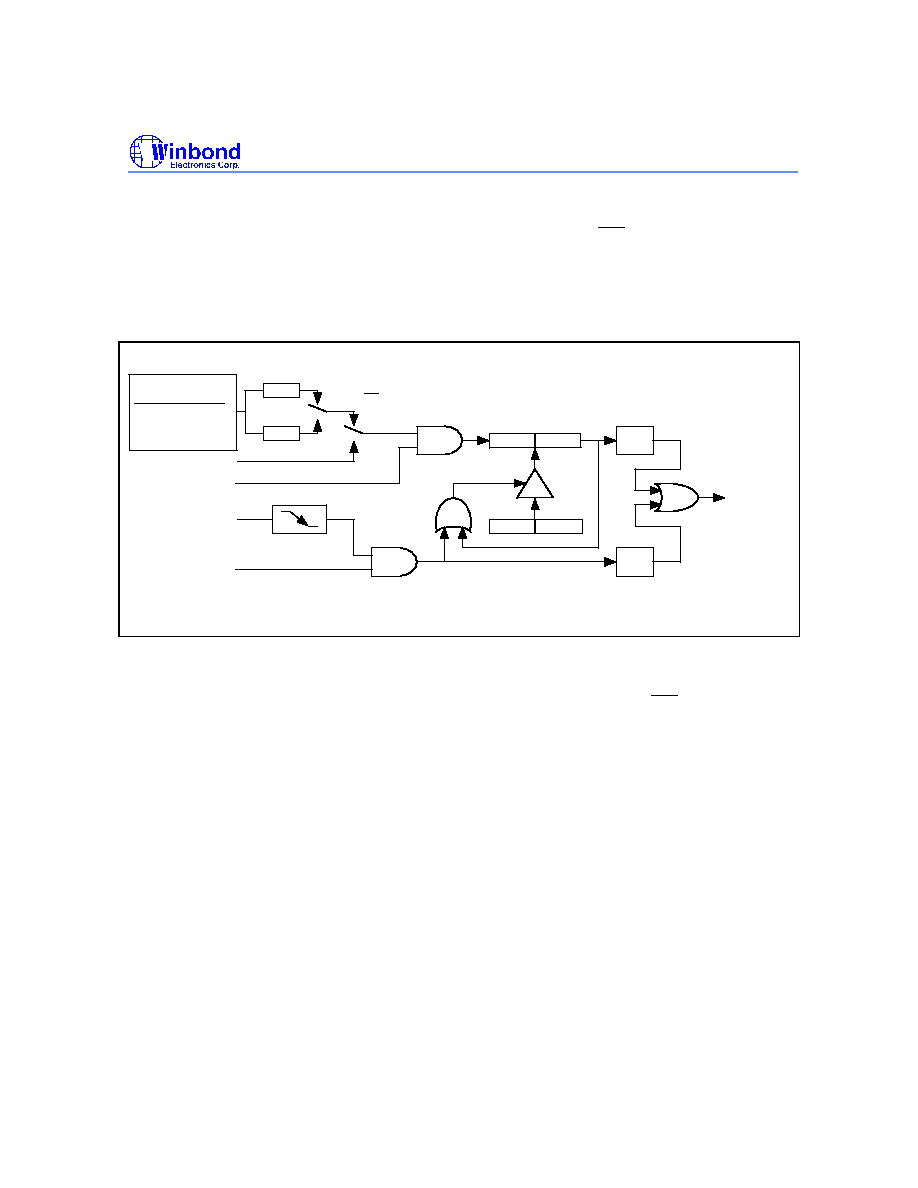
Preliminary W77E58
- 58 -
AUTO-RELOAD MODE, COUNTING UP
The auto-reload mode as an up counter is enabled by clearing the CP RL
/
2 bit in the T2CON register
and clearing the DCEN bit in T2MOD register. In this mode, Timer/Counter 2 is a 16 bit up counter.
When the counter rolls over from FFFFh, a reload is generated that causes the contents of the
RCAP2L and RCAP2H registers to be reloaded into the TL2 and TH2 registers. The reload action also
sets the TF2 bit. If the EXEN2 bit is set, then a negative transition of T2EX pin will also cause a
reload. This action also sets the EXF2 bit in T2CON.
1/4
1/12
T2M = CKCON.5
C/T2 = T2CON.1
T2CON.7
T2 = P1.0
T2CON.6
TR2 =
T2CON.2
T2EX = P1.1
EXEN2 = T2CON.3
EXF2
Timer 2
Interrupt
TF2
TH2
TL2
RCAP2H
RCAP2L
1
0
0
1
Clock Source
Mode input
div. by 4 osc/1
div. by 64 osc/16
div. by 1024 osc/256
Figure 15. 16-Bit Auto-reload Mode, Counting Up
AUTO-RELOAD MODE, COUNTING UP/DOWN
Timer/Counter 2 will be in auto-reload mode as an up/down counter if CP RL
/
2 bit in T2CON is
cleared and the DCEN bit in T2MOD is set. In this mode, Timer/Counter 2 is an up/down counter
whose direction is controlled by the T2EX pin. A 1 on this pin cause the counter to count up. An
overflow while counting up will cause the counter to be reloaded with the contents of the capture
registers. The next down count following the case where the contents of Timer/Counter equal the
capture registers will load an FFFFh into Timer/Counter 2. In either event a reload will set the TF2 bit.
A reload will also toggle the EXF2 bit. However, the EXF2 bit can not generate an interrupt while in
this mode.

Preliminary W77E58
Publication Release Date: March 1999
- 59 - Revision A1
C/T = T2CON.1
1/4
1/12
T2M = CKCON.5
Down Counting Reload Value
T2CON
.7
Up Counting Reload Value
T2 = P1.0
T2CON.6
TR2 = T2CON.2
T2EX = P1.1
EXF2
Timer 2
Interrupt
TF2
TH2
TL2
RCAP2H
RCAP2L
1
0
0
1
0FFh
0FFh
DCEN = 1
Clock Source
Mode input
div. by 4 osc/1
div. by 64 osc/16
div. by 1024 osc/256
Figure 16. 16-Bit Auto-reload Up/Down Counter
BAUD RATE GENERATOR MODE
The baud rate generator mode is enabled by setting either the RCLK or TCLK bits in T2CON register.
While in the baud rate generator mode, Timer/Counter 2 is a 16 bit counter with auto reload when the
count rolls over from FFFFh. However, rolling over does not set the TF2 bit. If EXEN2 bit is set, then
a negative transition of the T2EX pin will set EXF2 bit in the T2CON register and cause an interrupt
request.
C/T = T2CON.1
T2 = P1.0
T2CON.6
TR2 = T2CON.2
T2EX = P1.1
EXEN2 = T2CON.3
EXF2
Timer 2
overflow
Timer 2
Interrupt
TH2
TL2
RCAP2H
RCAP2L
0
1
Clock Source
Mode input
div. by 4 osc/2
div. by 64 osc/32
div. by 1024 osc/512
Figure 17. Baud Rate Generator Mode

Preliminary W77E58
- 60 -
PROGRAMMABLE CLOCK-OUT
Timer 2 is equipped with a new clock-out feature which outputs a 50% duty cycle clock on P1.0. It can
be invoked as a programmable clock generator. To configure Timer 2 with clock-out mode, software
must initiate it by setting bit T2OE = 1, C/T2 = 0 and CP/RL = 0. Setting bit TR2 will start the timer.
This mode is similar to the baud rate generator mode, it will not generate an interrupt while Timer 2
overflow. So it is possible to use Timer 2 as a baud rate generator and a clock generator at the same
time. The clock-out frequency is determined by the following equation:
The Clock-Out Frequency = Oscillator Frequency / [4 X (RCAP2H,RCAP2L) ]
T2CON.6
TR2 = T2CON.2
T2EX = P1.1
EXEN2 = T2CON.3
EXF2
T2=P1.0
Timer 2
Interrupt
TH2
TL2
RCAP2H
RCAP2L
Clock Source
Mode input
div. by 4 osc/2
div. by 64 osc/32
div. by 1024 osc/512
1/2
Figure 18. Programmable Clock-Out Mode
WATCHDOG TIMER
The Watchdog timer is a free-running timer which can be programmed by the user to serve as a
system monitor, a time-base generator or an event timer. It is basically a set of dividers that divide
the system clock. The divider output is selectable and determines the time-out interval. When the
time-out occurs a flag is set, which can cause an interrupt if enabled, and a system reset can also be
caused if it is enabled. The interrupt will occur if the individual interrupt enable and the global enable
are set. The interrupt and reset functions are independent of each other and may be used separately
or together depending on the users software.
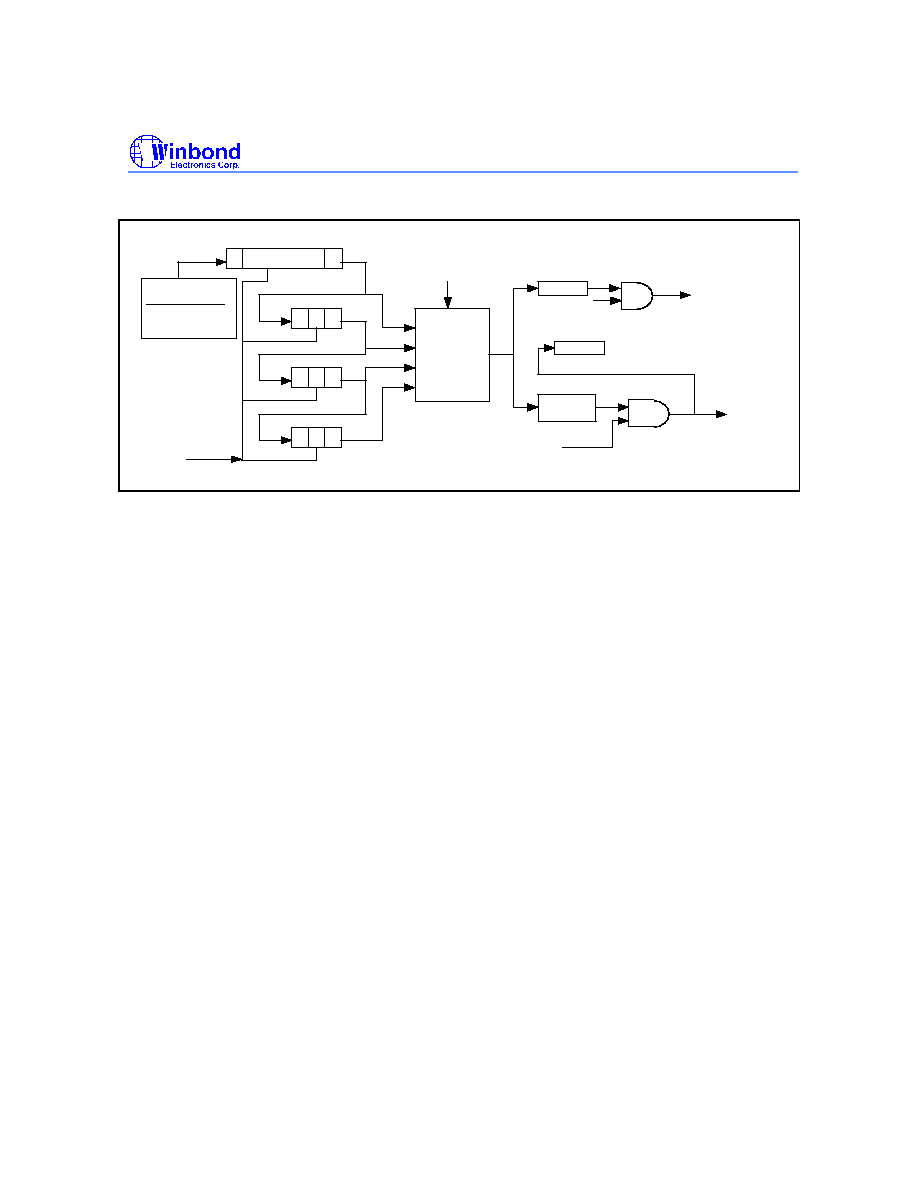
Preliminary W77E58
Publication Release Date: March 1999
- 61 - Revision A1
16
WD1,WD0
00
01
10
11
Interrupt
Reset
Enable Watchdog timer reset
EWT(WDCON.1)
Reset Watchdog
RWT (WDCON.0)
0
17
19
20
22
23
25
Time-out
WDIF
WTRF
512 clock
delay
EWDI(EIE.4)
Clock Source
Mode input
div. by 4 osc/1
div. by 64 osc/16
div. by 1024 osc/256
Figure 19. Watchdog Timer
The Watchdog timer should first be restarted by using RWT. This ensures that the timer starts from a
known state. The RWT bit is used to restart the watchdog timer. This bit is self clearing, i.e. after
writing a 1 to this bit the software will automatically clear it. The watchdog timer will now count clock
cycles. The time-out interval is selected by the two bits WD1 and WD0 (CKCON.7 and CKCON.6).
When the selected time-out occurs, the Watchdog interrupt flag WDIF (WDCON.3) is set. After the
time-out has occurred, the watchdog timer waits for an additional 512 clock cycles. If the Watchdog
Reset EWT (WDCON.1) is enabled, then 512 clocks after the time-out, if there is no RWT, a system
reset due to Watchdog timer will occur. This will last for two machine cycles, and the Watchdog timer
reset flag WTRF (WDCON.2) will be set. This indicates to the software that the watchdog was the
cause of the reset.
When used as a simple timer, the reset and interrupt functions are disabled. The timer will set the
WDIF flag each time the timer completes the selected time interval. The WDIF flag is polled to detect
a time-out and the RWT allows software to restart the timer. The Watchdog timer can also be used as
a very long timer. The interrupt feature is enabled in this case. Every time the time-out occurs an
interrupt will occur if the global interrupt enable EA is set.

Preliminary W77E58
- 62 -
The main use of the Watchdog timer is as a system monitor. This is important in real-time control
applications. In case of some power glitches or electro-magnetic interference, the processor may
begin to execute errant code. If this is left unchecked the entire system may crash. Using the
watchdog timer interrupt during software development will allow the user to select ideal watchdog
reset locations. The code is first written without the watchdog interrupt or reset. Then the watchdog
interrupt is enabled to identify code locations where interrupt occurs. The user can now insert
instructions to reset the watchdog timer which will allow the code to run without any watchdog timer
interrupts. Now the watchdog timer reset is enabled and the watchdog interrupt may be disabled. If
any errant code is executed now, then the reset watchdog timer instructions will not be executed at
the required instants and watchdog reset will occur.
The watchdog time-out selection will result in different time-out values depending on the clock speed.
The reset, when enabled, will occur 512 clocks after the time-out has occurred.
Table 9. Time-out values for the Watchdog timer
WD1
WD0
Watchdog
Interval
Number of
Clocks
Time
@ 1.8432 MHz
Time
@ 10 MHz
Time
@ 25 MHz
0
0
2
17
131072
71.11 mS
13.11 mS
5.24 mS
0
1
2
20
1048576
568.89 mS
104.86 mS
41.94 mS
1
0
2
23
8388608
4551.11 mS
838.86 mS
335.54 mS
1
1
2
26
67108864
36408.88 mS
6710.89 mS
2684.35 mS
The Watchdog timer will de disabled by a power-on/fail reset. The Watchdog timer reset does not
disable the watchdog timer, but will restart it. In general, software should restart the timer to put it into
a known state.
The control bits that support the Watchdog timer are discussed below.
WATCHDOG CONTROL
WDIF: WDCON.3 - Watchdog Timer Interrupt flag. This bit is set whenever the time-out occurs in
the watchdog timer. If the Watchdog interrupt is enabled (EIE.4), then an interrupt will occur
(if the global interrupt enable is set and other interrupt requirements are met). Software or any
reset can clear this bit.
WTRF: WDCON.2 - Watchdog Timer Reset flag. This bit is set whenever a watchdog reset occurs.
This bit is useful for determined the cause of a reset. Software must read it, and clear it
manually. A Power-fail reset will clear this bit. If EWT = 0, then this bit will not be affected by
the watchdog timer.
EWT:
WDCON.1 - Enable Watchdog timer Reset. This bit when set to 1 will enable the Watchdog
timer reset function. Setting this bit to 0 will disable the Watchdog timer reset function, but
will leave the timer running.

Preliminary W77E58
Publication Release Date: March 1999
- 63 - Revision A1
RWT: WDCON.0 - Reset Watchdog Timer. This bit is used to clear the Watchdog timer and to
restart it. This bit is self-clearing, so after the software writes 1 to it the hardware will
automatically clear it. If the Watchdog timer reset is enabled, then the RWT has to be set by
the user within 512 clocks of the time-out. If this is not done then a Watchdog timer reset will
occur.
CLOCK CONTROL
WD1, WD0: CKCON.7, CKCON.6 - Watchdog Timer Mode select bits. These two bits select the time-
out interval for the watchdog timer. The reset time is 512 clock longer than the interrupt
time-out value.
The default Watchdog time-out is 2
17
clocks, which is the shortest time-out period. The EWT, WDIF
and RWT bits are protected by the Timed Access procedure. This prevents software from accidentally
enabling or disabling the watchdog timer. More importantly, it makes it highly improbable that errant
code can enable or disable the watchdog timer.
SERIAL PORT
Serial port in the W77E58 is a full duplex port. The W77E58 provides the user with additional features
such as the Frame Error Detection and the Automatic Address Recognition. The serial ports are
capable of synchronous as well as asynchronous communication. In Synchronous mode the W77E58
generates the clock and operates in a half duplex mode. In the asynchronous mode, full duplex
operation is available. This means that it can simultaneously transmit and receive data. The transmit
register and the receive buffer are both addressed as SBUF Special Function Register. However any
write to SBUF will be to the transmit register, while a read from SBUF will be from the receive buffer
register. The serial port can operate in four different modes as described below.
MODE 0
This mode provides synchronous communication with external devices. In this mode serial data is
transmitted and received on the RXD line. TXD is used to transmit the shift clock. The TxD clock is
provided by the W77E58 whether the device is transmitting or receiving. This mode is therefore a half
duplex mode of serial communication. In this mode, 8 bits are transmitted or received per frame. The
LSB is transmitted/received first. The baud rate is fixed at 1/12 or 1/4 of the oscillator frequency. This
baud rate is determined by the SM2 bit (SCON.5). When this bit is set to 0, then the serial port runs at
1/12 of the clock. When set to 1, the serial port runs at 1/4 of the clock. This additional facility of
programmable baud rate in mode 0 is the only difference between the standard 8051 and the
W77E58.
The functional block diagram is shown below. Data enters and leaves the Serial port on the RxD line.
The TxD line is used to output the shift clock. The shift clock is used to shift data into and out of the
W77E58 and the device at the other end of the line. Any instruction that causes a write to SBUF will
start the transmission. The shift clock will be activated and data will be shifted out on the RxD pin till
all 8 bits are transmitted. If SM2 = 1, then the data on RxD will appear 1 clock period before the
falling edge of shift clock on TxD. The clock on TxD then remains low for 2 clock periods, and then
goes high again. If SM2 = 0, the data on RxD will appear 3 clock periods before the falling edge of
shift clock on TxD. The clock on TxD then remains low for 6 clock periods, and then goes high again.
This ensures that at the receiving end the data on RxD line can either be clocked on the rising edge
of the shift clock on TxD or latched when the TxD clock is low.
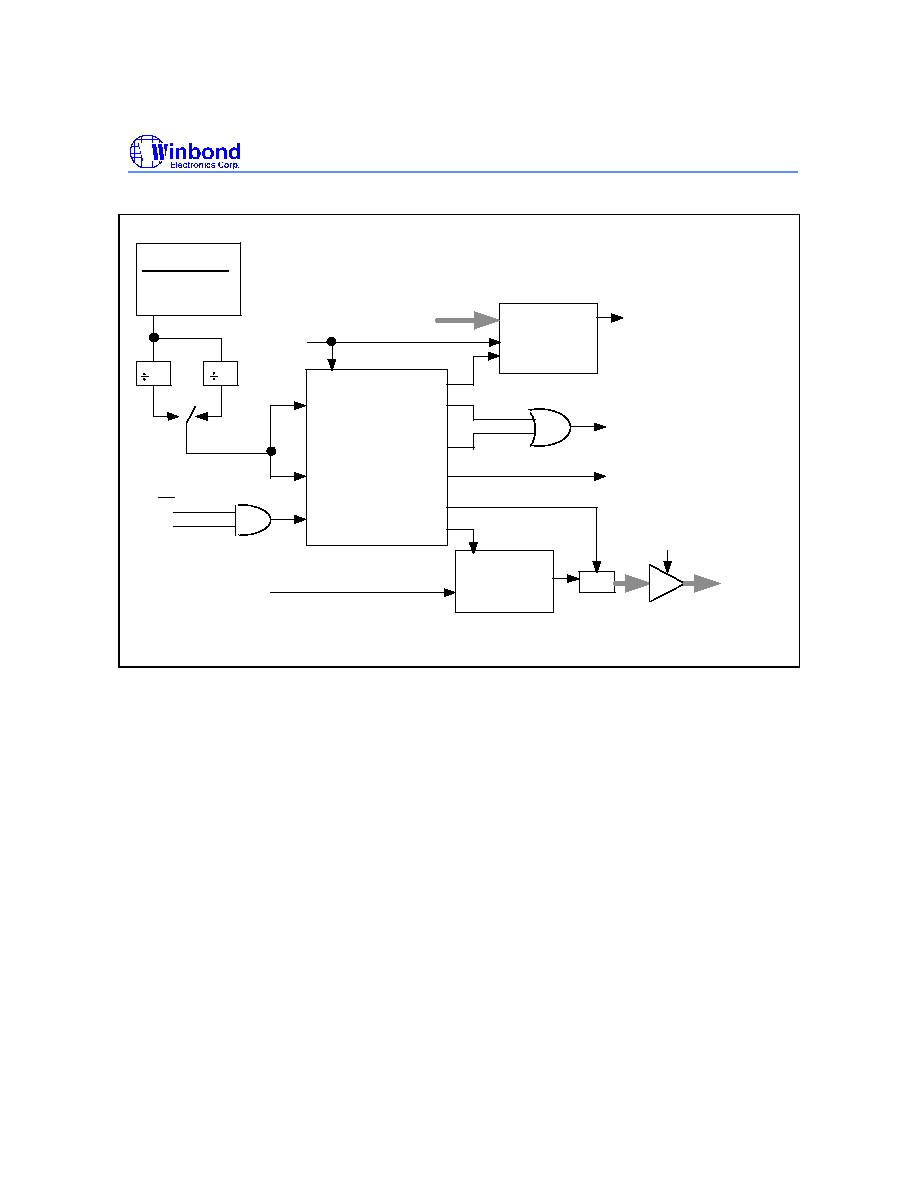
Preliminary W77E58
- 64 -
SBUF
Transmit Shift Register
Receive Shift Register
TX
SHIFT
PAROUT
Internal
Data Bus
Internal
Data Bus
RXD
P3.0 Alternate
Output Function
TXD
P3.1 Alternate
Output function
RXD
P3.0 Alternate
Iutput function
Serial Port Interrupt
Write to
SBUF
TX
START
SOUT
TI
RI
REN
PARIN
LOAD
CLOCK
Read SBUF
SBUF
TX CLOCK
RI
SERIAL
CONTROLLE
SHIFT
CLOCK
RX
CLOCK
LOAD SBUF
RX
START
RX SHIFT
CLOCK
SIN
4
12
1
0
SM2
Clock Source
Mode input
div. by 4 osc/1
div. by 64 osc/16
div. by 1024 osc/256
Figure 20. Serial Port Mode 1
The TI flag is set high in C1 following the end of transmission of the last bit. The serial port will
receive data when REN is 1 and RI is zero. The shift clock (TxD) will be activated and the serial port
will latch data on the rising edge of shift clock. The external device should therefore present data on
the falling edge on the shift clock. This process continues till all the 8 bits have been received. The RI
flag is set in C1 following the last rising edge of the shift clock on TxD. This will stop reception, till the
RI is cleared by software.
MODE 1
In Mode 1, the full duplex asynchronous mode is used. Serial communication frames are made up of
10 bits transmitted on TXD and received on RXD. The 10 bits consist of a start bit (0), 8 data bits
(LSB first), and a stop bit (1). On receive, the stop bit goes into RB8 in the SFR SCON. The baud rate
in this mode is variable. The serial baud can be programmed to be 1/16 or 1/32 of the Timer 1
overflow. Since the Timer 1 can be set to different reload values, a wide variation in baud rates is
possible.

Preliminary W77E58
Publication Release Date: March 1999
- 65 - Revision A1
Transmission begins with a write to SBUF. The serial data is brought out on to TxD pin at C1
following the first roll-over of divide by 16 counter. The next bit is placed on TxD pin at C1 following
the next rollover of the divide by 16 counter. Thus the transmission is synchronized to the divide by
16 counter and not directly to the write to SBUF signal. After all 8 bits of data are transmitted, the stop
bit is transmitted. The TI flag is set in the C1 state after the stop bit has been put out on TxD pin. This
will be at the 10th rollover of the divide by 16 counter after a write to SBUF.
Reception is enabled only if REN is high. The serial port actually starts the receiving of serial data,
with the detection of a falling edge on the RxD pin. The 1-to-0 detector continuously monitors the RxD
line, sampling it at the rate of 16 times the selected baud rate. When a falling edge is detected, the
divide by 16 counter is immediately reset. This helps to align the bit boundaries with the rollovers of
the divide by 16 counter.
The 16 states of the counter effectively divide the bit time into 16 slices. The bit detection is done on
a best of three basis. The bit detector samples the RxD pin, at the 8th, 9th and 10th counter states.
By using a majority 2 of 3 voting system, the bit value is selected. This is done to improve the noise
rejection feature of the serial port. If the first bit detected after the falling edge of RxD pin is not 0,
then this indicates an invalid start bit, and the reception is immediately aborted. The serial port again
looks for a falling edge in the RxD line. If a valid start bit is detected, then the rest of the bits are also
detected and shifted into the SBUF.
After shifting in 8 data bits, there is one more shift to do, after which the SBUF and RB8 are loaded
and RI is set. However certain conditions must be met before the loading and setting of RI can be
done.
1. RI must be 0 and
2. Either SM2 = 0, or the received stop bit = 1.
If these conditions are met, then the stop bit goes to RB8, the 8 data bits go into SBUF and RI is set.
Otherwise the received frame may be lost. After the middle of the stop bit, the receiver goes back to
looking for a 1-to-0 transition on the RxD pin.
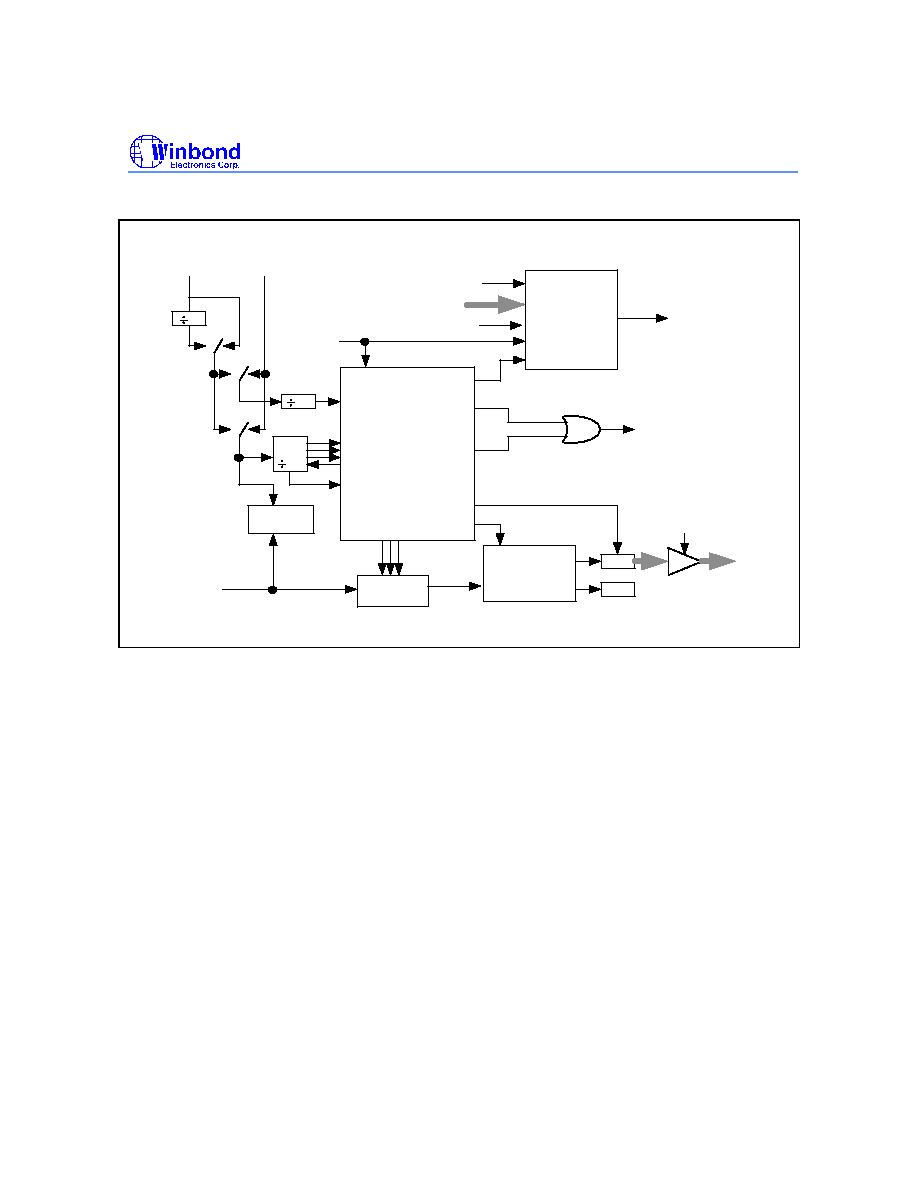
Preliminary W77E58
- 66 -
SBUF
RB8
Transmit Shift Register
Receive Shift
Register
TX SHIFT
PAROUT
D8
Internal
Data Bus
Internal
Data
Bus
TXD
RXD
Serial Port
Interrupt
SMOD=
(SMOD_1)
TCLK
RCLK
SAMPLE
Write to
SBUF
TX START
SOUT
0
1
0
1
TI
1
0
PARIN
STOP
START
LOAD
CLOCK
Read
SBUF
Timer 2 Overflow
(for Serial Port 0 only)
Timer 1
Overflow
TX CLOCK
RI
SERIAL
CONTROLLER
RX CLOCK
LOAD
SBUF
RX
START
RX SHIFT
2
16
1-TO-0
DETECTOR
BIT
DETECTOR
16
CLOCK
SIN
Figure 21. Serial Port Mode 1
MODE 2
This mode uses a total of 11 bits in asynchronous full-duplex communication. The functional
description is shown in the figure below. The frame consists of one start bit (0), 8 data bits (LSB first),
a programmable 9th bit (TB8) and a stop bit (0). The 9th bit received is put into RB8. The baud rate is
programmable to 1/32 or 1/64 of the oscillator frequency, which is determined by the SMOD bit in
PCON SFR. Transmission begins with a write to SBUF. The serial data is brought out on to TxD pin
at C1 following the first roll-over of the divide by 16 counter. The next bit is placed on TxD pin at C1
following the next rollover of the divide by 16 counter. Thus the transmission is synchronized to the
divide by 16 counter, and not directly to the write to SBUF signal. After all 9 bits of data are
transmitted, the stop bit is transmitted. The TI flag is set in the C1 state after the stop bit has been put
out on TxD pin. This will be at the 11th rollover of the divide by 16 counter after a write to SBUF.
Reception is enabled only if REN is high. The serial port actually starts the receiving of serial data,
with the detection of a falling edge on the RxD pin. The 1-to-0 detector continuously monitors the RxD
line, sampling it at the rate of 16 times the selected baud rate. When a falling edge is detected, the
divide by 16 counter is immediately reset. This helps to align the bit boundaries with the rollovers of
the divide by 16 counter. The 16 states of the counter effectively divide the bit time into 16 slices. The
bit detection is done on a best of three basis. The bit detector samples the RxD pin, at the 8th, 9th
and 10th counter states. By using a majority 2 of 3 voting system, the bit value is selected. This is
done to improve the noise rejection feature of the serial port.
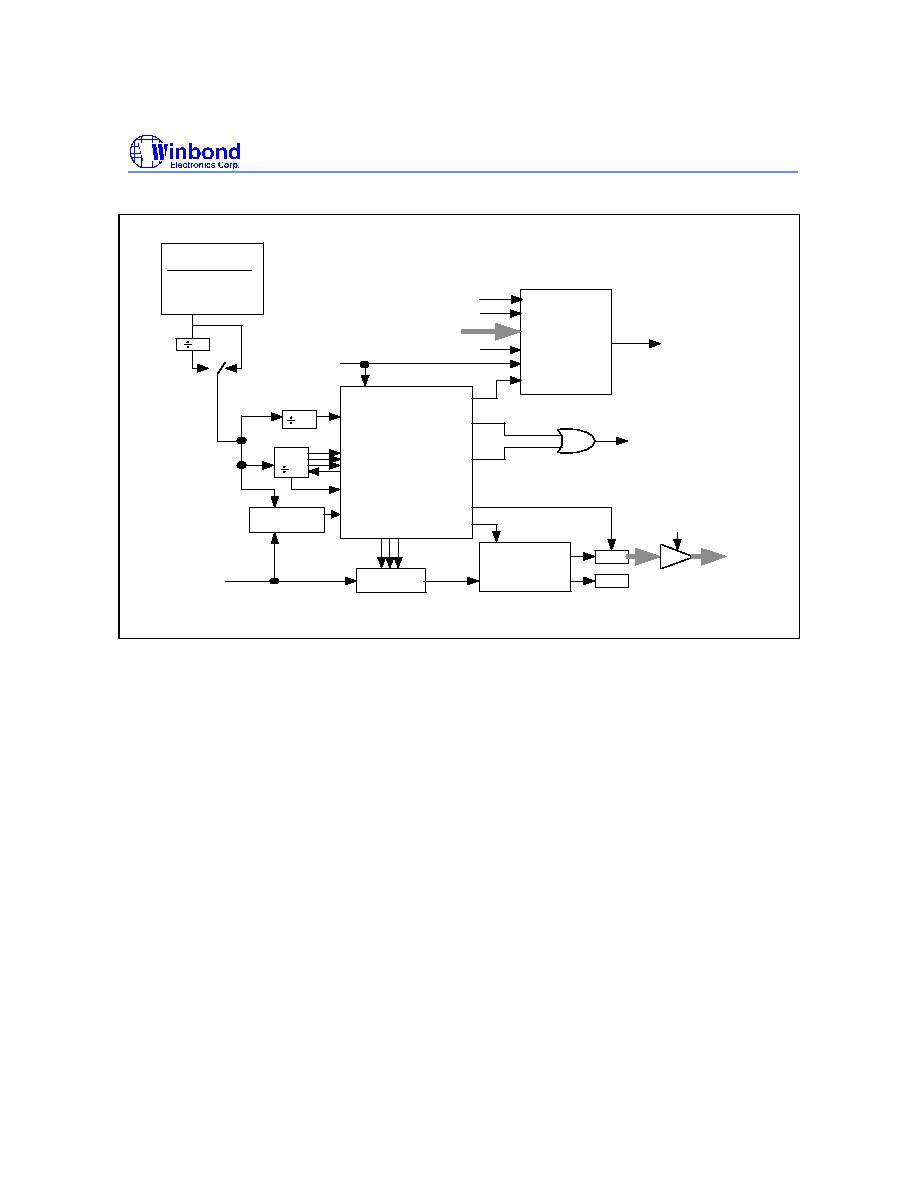
Preliminary W77E58
Publication Release Date: March 1999
- 67 - Revision A1
SBUF
RB8
Transmit Shift Register
Receive Shift Register
TX
SHIFT
PAROUT
D8
Internal
Data Bus
Internal
Data
Bus
TXD
RXD
Serial Port
Interrupt
SMOD=
(SMOD_1)
SAMPLE
Write to
SBUF
TX
START
SOUT
0
1
TI
PARIN
STOP
START
LOAD
CLOCK
Read
SBUF
TX
CLOCK
RI
SERIAL
CONTROLLER
RX CLOCK
LOAD
SBUF
RX START
RX SHIFT
2
16
1-TO-0
DETECTOR
BIT
DETECTOR
16
CLOCK
SIN
D8
TB8
Clock Source
Mode input
div. by 4 osc/2
div. by 64 osc/32
div. by 1024 osc/512
Figure 22. Serial Port Mode 2
If the first bit detected after the falling edge of RxD pin, is not 0, then this indicates an invalid start bit,
and the reception is immediately aborted. The serial port again looks for a falling edge in the RxD
line. If a valid start bit is detected, then the rest of the bits are also detected and shifted into the
SBUF. After shifting in 9 data bits, there is one more shift to do, after which the SBUF and RB8 are
loaded and RI is set. However certain conditions must be met before the loading and setting of RI can
be done.
1. RI must be 0 and
2. Either SM2 = 0, or the received stop bit = 1.
If these conditions are met, then the stop bit goes to RB8, the 8 data bits go into SBUF and RI is set.
Otherwise the received frame may be lost. After the middle of the stop bit, the receiver goes back to
looking for a 1-to-0 transition on the RxD pin.
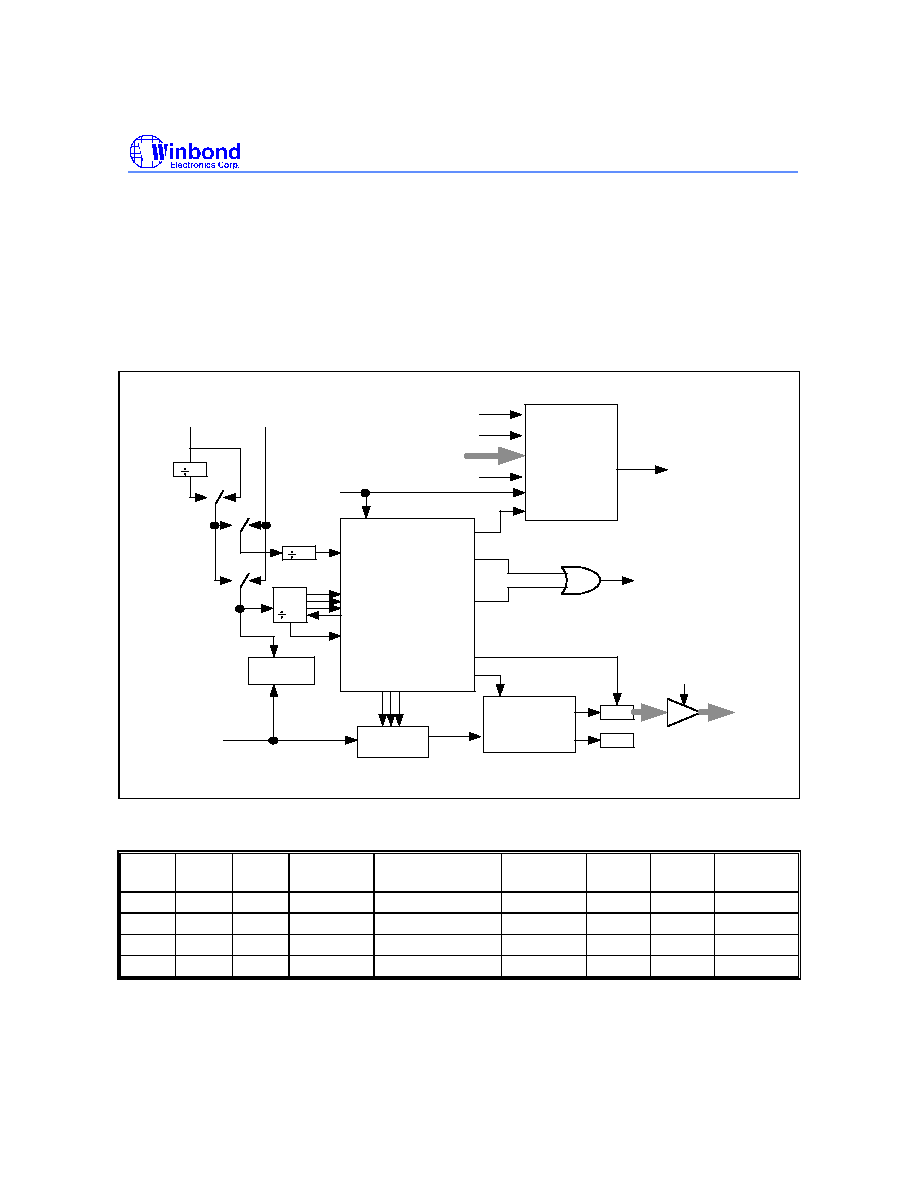
Preliminary W77E58
- 68 -
MODE 3
This mode is similar to Mode 2 in all respects, except that the baud rate is programmable. The user
must first initialize the Serial related SFR SCON before any communication can take place. This
involves selection of the Mode and baud rate. The Timer 1 should also be initialized if modes 1 and 3
are used. In all four modes, transmission is started by any instruction that uses SBUF as a destination
register. Reception is initiated in Mode 0 by the condition RI = 0 and REN = 1. This will generate a
clock on the TxD pin and shift in 8 bits on the RxD pin. Reception is initiated in the other modes by
the incoming start bit if REN = 1. The external device will start the communication by transmitting the
start bit.
SBUF
RB8
Transmit Shift Register
Receive Shift
Register
TX SHIFT
PAROUT
D8
Internal
Data Bus
Internal
Data
Bus
TXD
RXD
Serial Port
Interrupt
SMOD=
(SMOD_1)
TCLK
RCLK
SAMPLE
Write to
SBUF
TX START
SOUT
0
1
0
1
TI
1
0
PARIN
STOP
START
LOAD
CLOCK
Read
SBUF
Timer 2 Overflow
(for Serial Port 0 only)
Timer 1
Overflow
TX CLOCK
RI
SERIAL
CONTROLLER
RX CLOCK
LOAD
SBUF
RX
START
RX SHIFT
2
16
1-TO-0
DETECTOR
BIT
DETECTOR
16
CLOCK
SIN
D8
TB8
Figure 23. Serial Port Mode 3
Table 10. Serial Ports Modes
SM1
SM0
Mode
Type
Baud Clock
Frame
size
Start
bit
Stop
bit
9th bit
function
0
0
0
Synch.
4 or 12 T
CLKS
8 bits
No
No
None
0
1
1
Asynch.
Timer 1 or 2
10 bits
1
1
None
1
0
2
Asynch.
32 or 64
T
CLKS
11 bits
1
1
0, 1
1
1
3
Asynch.
Timer 1 or 2
11 bits
1
1
0, 1

Preliminary W77E58
Publication Release Date: March 1999
- 69 - Revision A1
Framing Error Detection
A Frame Error occurs when a valid stop bit is not detected. This could indicate incorrect serial data
communication. Typically the frame error is due to noise and contention on the serial communication
line. The W77E58 has the facility to detect such framing errors and set a flag which can be checked
by software.
The Frame Error FE(FE_1) bit is located in SCON.7(SCON1.7). This bit is normally used as SM0 in
the standard 8051 family. However, in the W77E58 it serves a dual function and is called SM0/FE
(SM0_1/FE_1). There are actually two separate flags, one for SM0 and the other for FE. The flag that
is actually accessed as SCON.7(SCON1.7) is determined by SMOD0 (PCON.6) bit. When SMOD0 is
set to 1, then the FE flag is indicated in SM0/FE. When SMOD0 is set to 0, then the SM0 flag is
indicated in SM0/FE.
The FE bit is set to 1 by hardware but must be cleared by software. Note that SMOD0 must be 1 while
reading or writing to FE or FE_1. If FE is set, then any following frames received without any error will
not clear the FE flag. The clearing has to be done by software.
Multiprocessor Communications
Multiprocessor communications makes use of the 9th data bit in modes 2 and 3. In the W77E58, the
RI flag is set only if the received byte corresponds to the Given or Broadcast address. This hardware
feature eliminates the software overhead required in checking every received address, and greatly
simplifies the software programmer task.
In the multiprocessor communication mode, the address bytes are distinguished from the data bytes
by transmitting the address with the 9th bit set high. When the master processor wants to transmit a
block of data to one of the slaves, it first sends out the address of the targeted slave (or slaves). All
the slave processors should have their SM2 bit set high when waiting for an address byte. This
ensures that they will be interrupted only by the reception of a address byte. The Automatic address
recognition feature ensures that only the addressed slave will be interrupted. The address comparison
is done in hardware not software.
The addressed slave clears the SM2 bit, thereby clearing the way to receive data bytes. With SM2 =
0, the slave will be interrupted on the reception of every single complete frame of data. The
unaddressed slaves will be unaffected, as they will be still waiting for their address. In Mode 1, the 9th
bit is the stop bit, which is 1 in case of a valid frame. If SM2 is 1, then RI is set only if a valid frame is
received and the received byte matches the Given or Broadcast address.
The Master processor can selectively communicate with groups of slaves by using the Given
Address. All the slaves can be addressed together using the Broadcast Address. The addresses for
each slave are defined by the SADDR and SADEN SFRs. The slave address is an 8-bit value
specified in the SADDR SFR. The SADEN SFR is actually a mask for the byte value in SADDR. If a
bit position in SADEN is 0, then the corresponding bit position in SADDR is don't care. Only those bit
positions in SADDR whose corresponding bits in SADEN are 1 are used to obtain the Given Address.
This gives the user flexibility to address multiple slaves without changing the slave address in
SADDR.

Preliminary W77E58
- 70 -
The following example shows how the user can define the Given Address to address different slaves.
Slave 1:
SADDR1010 0100
SADEN 1111 1010
Given 1010 0x0x
Slave 2:
SADDR1010 0111
SADEN 1111 1001
Given 1010 0xx1
The Given address for slave 1 and 2 differ in the LSB. For slave 1, it is a don't care, while for slave 2
it is 1. Thus to communicate only with slave 1, the master must send an address with LSB = 0 (1010
0000). Similarly the bit 1 position is 0 for slave 1 and don't care for slave 2. Hence to communicate
only with slave 2 the master has to transmit an address with bit 1 = 1 (1010 0011). If the master
wishes to communicate with both slaves simultaneously, then the address must have bit 0 = 1 and bit
1 = 0. The bit 3 position is don't care for both the slaves. This allows two different addresses to select
both slaves (1010 0001 and 1010 0101).
The master can communicate with all the slaves simultaneously with the Broadcast Address. This
address is formed from the logical ORing of the SADDR and SADEN SFRs. The zeros in the result
are defined as don't cares In most cases the Broadcast Address is FFh. In the previous case, the
Broadcast Address is (1111111X) for slave 1 and (11111111) for slave 2.
The SADDR and SADEN SFRs are located at address A9h and B9h respectively. On reset, these two
SFRs are initialized to 00h. This results in Given Address and Broadcast Address being set as XXXX
XXXX(i.e. all bits don't care). This effectively removes the multiprocessor communications feature,
since any selectivity is disabled.
TIMED ACCESS PROTECTION
The W77E58 has several new features, like the Watchdog timer, on-chip ROM size adjustment, wait
state control signal and Power on/fail reset flag, which are crucial to proper operation of the system. If
left unprotected, errant code may write to the Watchdog control bits resulting in incorrect operation
and loss of control. In order to prevent this, the W77E58 has a protection scheme which controls the
write access to critical bits. This protection scheme is done using a timed access.
In this method, the bits which are to be protected have a timed write enable window. A write is
successful only if this window is active, otherwise the write will be discarded. This write enable
window is open for 3 machine cycles if certain conditions are met. After 3 machine cycles, this
window automatically closes. The window is opened by writing AAh and immediately 55h to the Timed
Access(TA) SFR. This SFR is located at address C7h. The suggested code for opening the timed
access window is
TA
REG
0C7h
;define new register TA, located at 0C7h
MOV
TA, #0AAh
MOV
TA, #055h

Preliminary W77E58
Publication Release Date: March 1999
- 71 - Revision A1
When the software writes AAh to the TA SFR, a counter is started. This counter waits for 3 machine
cycles looking for a write of 55h to TA. If the second write (55h) occurs within 3 machine cycles of the
first write (AAh), then the timed access window is opened. It remains open for 3 machine cycles,
during which the user may write to the protected bits. Once the window closes the procedure must be
repeated to access the other protected bits.
Examples of Timed Assessing are shown below.
Example 1: Valid access
MOV
TA, #0AAh
3 M/C
Note: M/C = Machine Cycles
MOV
TA, #055h
3 M/C
MOV
WDCON, #00h 3 M/C
Example 2: Valid access
MOV
TA, #0AAh
3 M/C
MOV
TA, #055h
3 M/C
NOP
1 M/C
SETB
EWT
2 M/C
Example 3: Invalid access
MOV
TA, #0AAh
3 M/C
MOV
TA, #055h
3 M/C
NOP
1 M/C
NOP
1 M/C
CLR
POR
2 M/C
Example 4: Invalid Access
MOV
TA, #0AAh
3 M/C
NOP
1 M/C
MOV
TA, #055h
3 M/C
SETB
EWT
2 M/C
In the first two examples, the writing to the protected bits is done before the 3 machine cycle window
closes. In Example 3, however, the writing to the protected bit occurs after the window has closed,
and so there is effectively no change in the status of the protected bit. In Example 4, the second write
to TA occurs 4 machine cycles after the first write, therefore the timed access window in not opened
at all, and the write to the protected bit fails.
ON-CHIP MTP ROM CHARACTERISTICS
The W77E58 has several modes to program the on-chip MTP ROM. All these operations are
configured by the pins RST, ALE, PSEN PSEN, A9CTRL(P3.0), A13CTRL(P3.1), A14CTRL(P3.2),
OECTRL(P3.3), CE (P3.6), OE (P3.7), A0(P1.0) and V
PP
(
EA
). Moreover, the A15
-
A0(P2.7
-
P2.0,
P1.7
-
P1.0) and the D7
-
D0(P0.7
-
P0.0) serve as the address and data bus respectively for these
operations.

Preliminary W77E58
- 72 -
READ OPERATION
This operation is supported for customer to read their code and the Security bits. The data will not be
valid if the Lock bit is programmed to low.
OUTPUT DISABLE CONDITION
When the OE is set to high, no data output appears on the D7..D0.
PROGRAM OPERATION
This operation is used to program the data to MTP ROM and the security bits. Program operation is
done when the V
PP
is reach to V
CP
(12.5V) level, CE set to low, and OE set to high.
PROGRAM VERIFY OPERATION
All the programming data must be checked after program operations. This operation should be
performed after each byte is programmed; it will ensure a substantial program margin.
ERASE OPERATION
An erase operation is the only way to change data from 0 to 1. This operation will erase all the MTP
ROM cells and the security bits from 0 to 1. This erase operation is done when the V
PP
is reach to
V
EP
level, CE set to low, and OE set to high.
ERASE VERIFY OPERATION
After an erase operation, all of the bytes in the chip must be verified to check whether they have been
successfully erased to 1 or not. The erase verify operation automatically ensures a substantial erase
margin. This operation will be done after the erase operation if V
PP
= V
EP
(14.5V), CE is high and
OE is low.
PROGRAM/ERASE INHIBIT OPERATION
This operation allows parallel erasing or programming of multiple chips with different data. When
P3.6( CE ) = V
IH
, P3.7( OE ) = V
IH
, erasing or programming of non-targeted chips is inhibited. So,
except for the P3.6 and P3.7 pins, the individual chips may have common inputs.
COMPANY/DEVICE ID READ OPERATION
This operation is supported for MTP ROM programmer to get the company ID or device ID on the
W77E58.
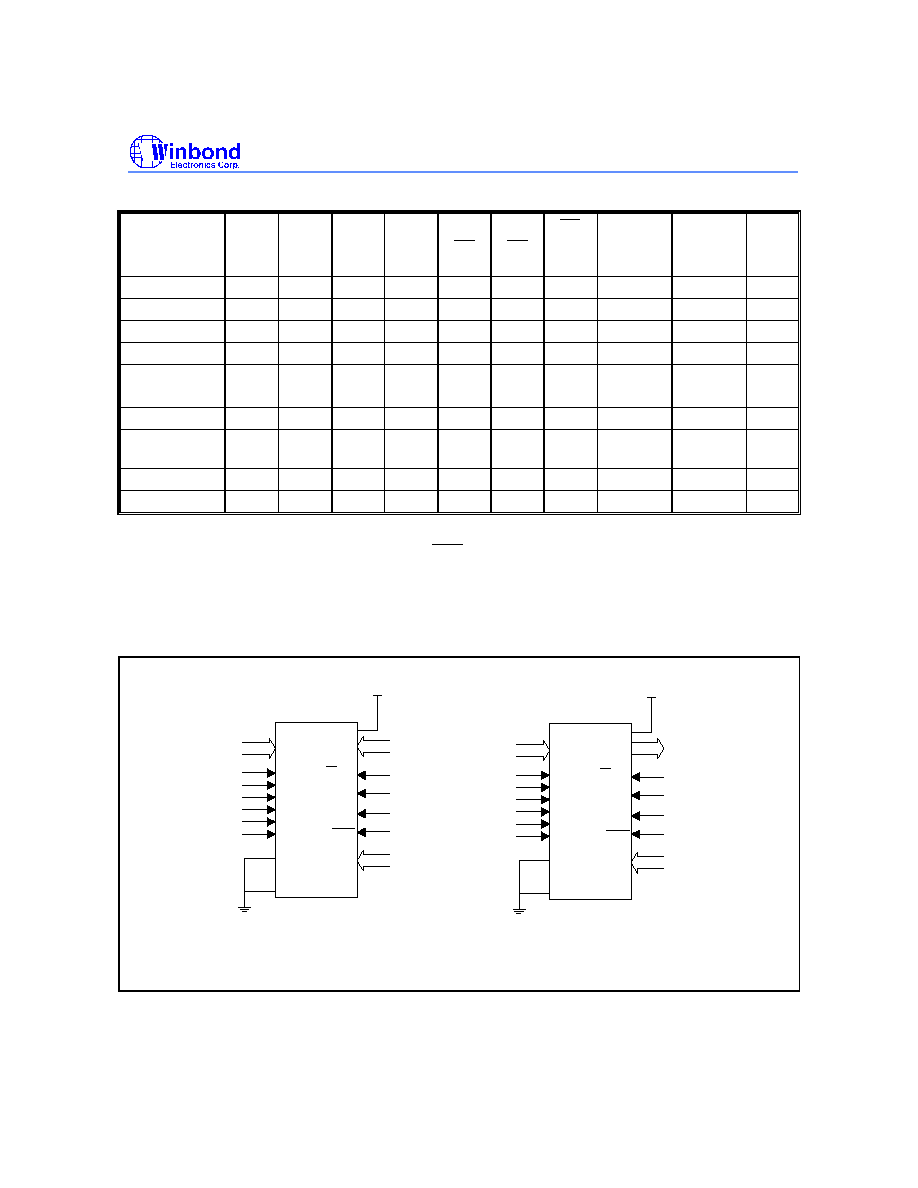
Preliminary W77E58
Publication Release Date: March 1999
- 73 - Revision A1
Operations
P3.0
(A9
CTRL)
P3.1
(A13
CTRL)
P3.2
(A14
CTRL)
P3.3
(OE
CTRL)
P3.6
( CE )
P3.7
( OE )
EA
(V
PP
)
P2,P1
(A15..A0)
P0
(D7..D0)
Note
Read
0
0
0
0
0
0
1
Address
Data Out
Output Disable
0
0
0
0
0
1
1
X
Hi-Z
Program
0
0
0
0
0
1
V
CP
Address
Data In
Program Verify
0
0
0
0
1
0
V
CP
Address
Data Out
@3
Erase
1
0
0
0
0
1
V
EP
A0:0,
others: X
Data In
0FFH
@4
Erase Verify
1
0
0
0
1
0
V
EP
Address
Data Out
@5
Program/Erase
Inhibit
X
0
0
0
1
1
V
CP
/
V
EP
X
X
Company ID
1
0
0
0
0
0
1
A0 = 0
Data Out
Device ID
1
0
0
0
0
0
1
A0 = 1
Data Out
Notes:
1. All these operations happen in RST = V
IH
, ALE = V
IL
and
PSEN
= V
IH
.
2. V
CP
= 12V, V
EP
= 14V, V
IH
= V
DD
, V
IL
= V
SS
.
3. The program verify operation follows behind the program operation.
4. This erase operation will erase all the on-chip ROM cells and the Security bits.
5. The erase verify operation follows behind the erase operation.
P1
P3.0
P3.1
P3.2
P3.3
P3.6
P3.7
X'tal1
X'tal2
P0
EA/Vpp
ALE
RST
PSEN
P2
Vss
Vcc
A0-A7
V
CP
V
IL
V
IH
V
IL
V
IL
V
IL
V
IL
V
IL
A8-A15
PGM DATA
V
IH
V
IH
+5V
Programming Configuration
P1
P3.0
P3.1
P3.2
P3.3
P3.6
P3.7
X'tal1
X'tal2
P0
EA/Vpp
ALE
RST
PSEN
P2
Vss
Vcc
A0-A7
V
CP
V
IL
V
IH
V
IL
V
IL
V
IL
V
IL
V
IL
A8-A15
PGM DATA
V
IH
V
IH
+5V
Programming Verification
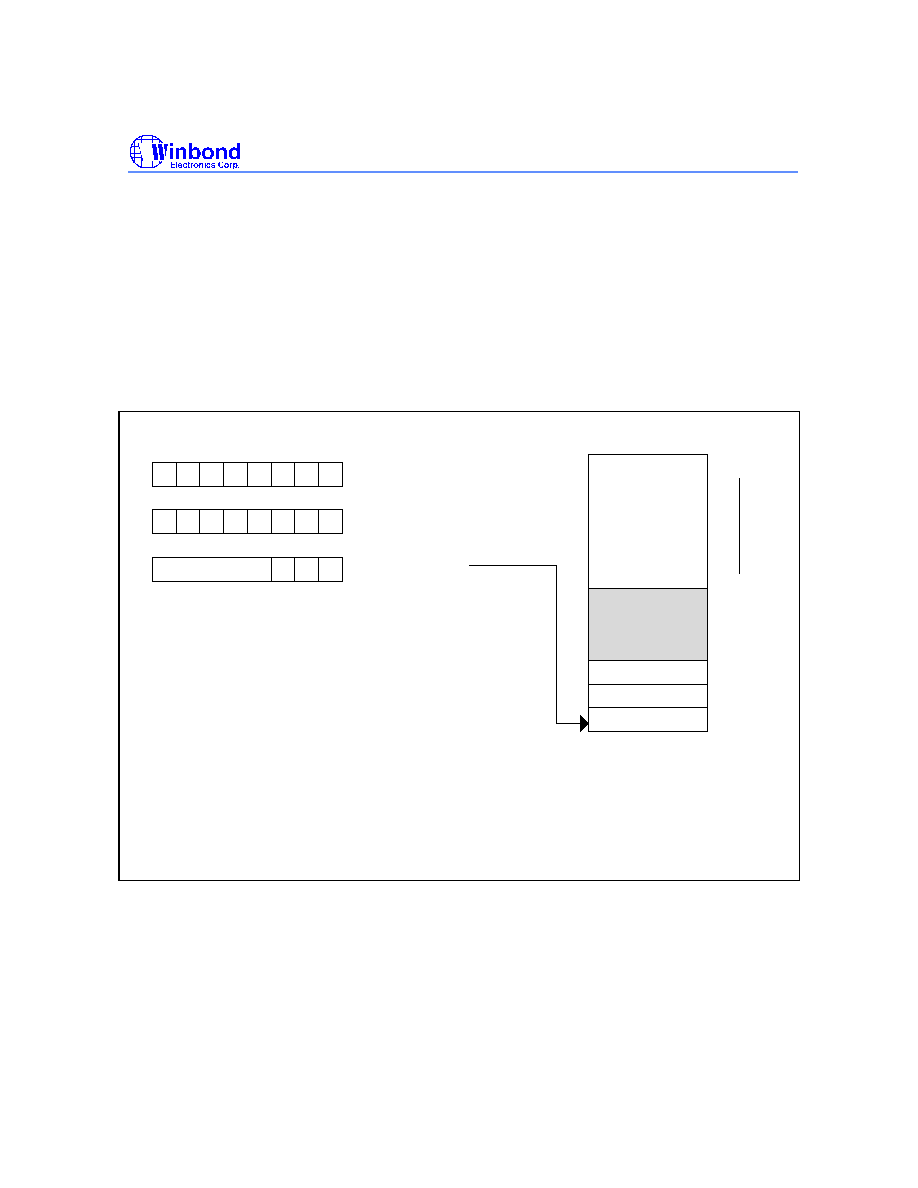
Preliminary W77E58
- 74 -
SECURITY BITS
During the on-chip MTP ROM operation mode, the MTP ROM can be programmed and verified
repeatedly. Until the code inside the MTP ROM is confirmed OK, the code can be protected. The
protection of MTP ROM and those operations on it are described below.
The W77E58 has several Special Setting Registers, including the Security Register and
Company/Device ID Registers, which can not be accessed in normal mode. These registers can only
be accessed from the MTP ROM operation mode. Those bits of the Security Registers can not be
changed once they have been programmed from high to low. They can only be reset through erase-
all operation. The contents of the Company ID and Device ID registers have been set in factory. Both
registers are addressed by the A0 address line during the same specific condition.
The Security Register is addressed in the MTP-ROM operation mode by address #0FFFFh.
B0
B1
B0 : Lock bit, logic 0 : active
B1 : MOVC inhibit,
logic 0 : the MOVC instruction in external memory
cannot access the code in internal memory.
logic 1 : no restriction.
Default 1 for each bit.
Special Setting Registers
Company ID (#DAH)
D7 D6 D5 D4 D3 D2 D1 D0
1
1
0
1
1
0
1
0
Device ID (#62H)
0
1
1
1
0
0
0
Security Bits
0
32KB MTP ROM
Program Memory
Reserved
Security Register
0FFFFh
0000h
7FFFh
Seed 1
Seed 0
0FF7Fh
0FF3Fh
Reserved
On-Chip
B2
B2 : Seed 0 & 1 access inhibit
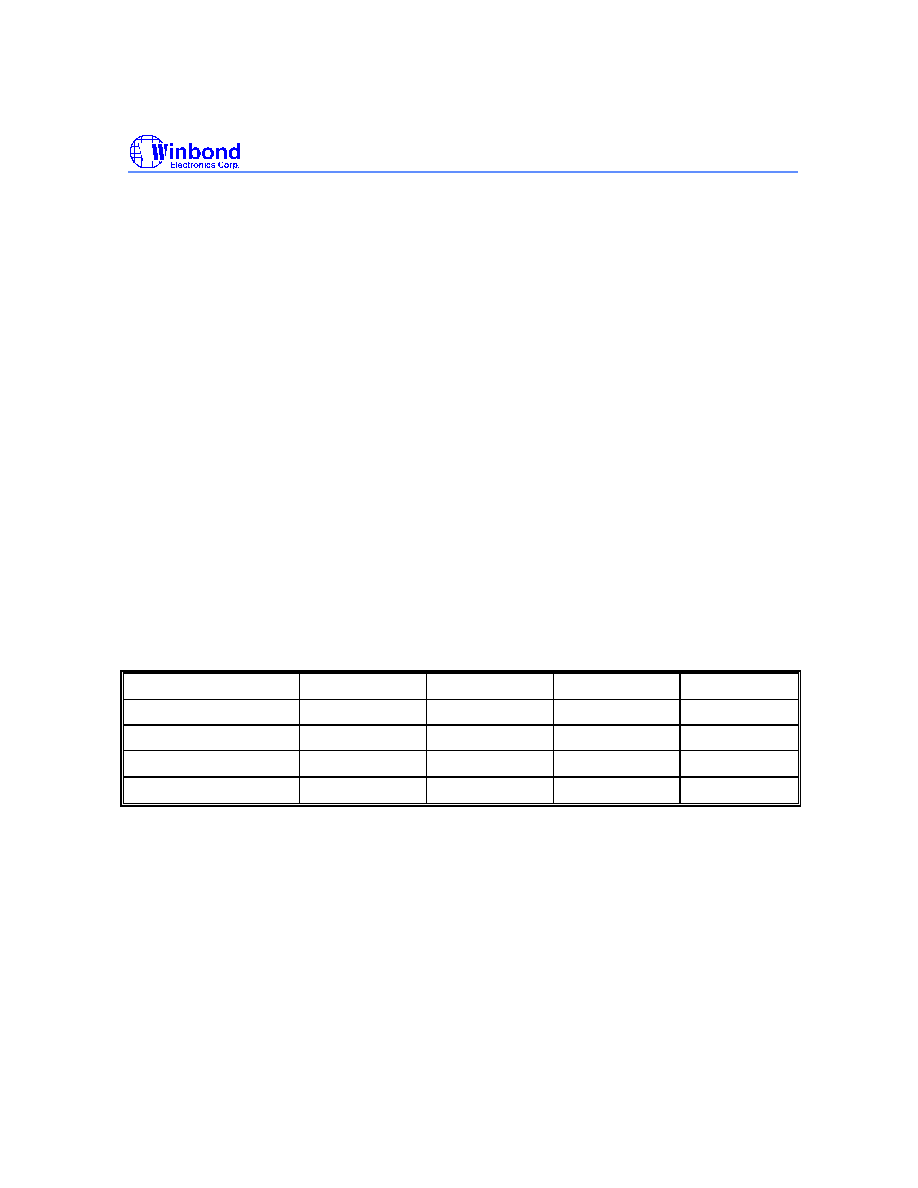
Preliminary W77E58
Publication Release Date: March 1999
- 75 - Revision A1
B0:Lock bit
This bit is used to protect the customer's program code in the W77E58. It may be set after the
programmer finishes the programming and verifies sequence. Once this bit is set to logic 0, both the
MTP ROM data and Special Setting Registers can not be accessed again.
B1:MOVC Inhibit
This bit is used to restrict the accessible region of the MOVC instruction. It can prevent the MOVC
instruction in external program memory from reading the internal program code. When this bit is set
to logic 0, a MOVC instruction in external program memory space will be able to access code only in
the external memory, not in the internal memory. A MOVC instruction in internal program memory
space will always be able to access the ROM data in both internal and external memory. If this bit is
logic 1, there are no restrictions on the MOVC instruction.
B2:Encryption Feature
Both the Seed 0 and Seed 1 are a one-byte flash memory cell that provide the user with encryption
code protection. When program code is programmed to the W77E58 internal MTP ROM and verify it
is correct, then users can program a non-FFh value into either Seed 0 or Seed 1 to start the
encryption logic. When Seed 0 or Seed 1 is presented in non-FFh state, the internal encryption circuit
will generate a sequence of random values, then add to each the program code bytes before they
appear in the data bus. Now the code is scrambled during the read or verify operation. The Seed 0
and Seed 1 have the initial value FFh after chip erased. When the encryption logic is effective, the
user can not disable it except by erasing the chip to recover the Seed 0 and 1 to initial value FFh.
The method for programming Seed 0 and Seed 1 is the same as that used to program internal MTP
ROM, except that the address of Seed 0 is 0FF7Fh, and Seed 1 is 0FF3Fh. When B2 bit is cleared,
Seed 0 and Seed 1 can not be accessed.
ABSOLUTE MAXIMUM RATINGS
SYMBOL
PARAMETER
CONDITION
RATING
UNIT
DC Power Supply
V
DD
-
V
SS
-0.3
+7.0
V
Input Voltage
V
IN
V
SS
-0.3
V
DD
+0.3
V
Operating Temperature
T
A
0
+70
�
C
Storage Temperatute
Tst
-55
+150
�
C
Note: Exposure to conditions beyond those listed under Absolute Maximum Ratings may adversely affect the life and reliability
of the device.

Preliminary W77E58
- 76 -
DC ELECTRICAL CHARACTERISTICS
(V
DD
-
V
SS
= 5V
�
10%, T
A
= 25
�
C, Fosc = 20 MHz, unless otherwise specified.)
PARAMETER
SYMBOL
SPECIFICATION
TEST CONDITIONS
MIN.
MAX.
UNIT
Operating Voltage
V
DD
4.5
5.5
V
Operating Current
I
DD
-
50
mA
No load
V
DD
= RST = 5.5V
Idle Current
I
IDLE
-
20
mA
Idle mode
V
DD
= 5.5V
Power Down Current
I
PWDN
-
50
�
A
Power-down mode
V
DD
= 5.5V
Input Current
P1, P2, P3
I
IN1
-50
+10
�
A
V
DD
= 5.5V
V
IN
= 0V or V
DD
Input Current RST
[*1]
I
IN2
-10
+300
�
A
V
DD
= 5.5V
0<V
IN
<V
DD
Input Leakage Current
P0,
EA
I
LK
-10
+10
�
A
V
DD
= 5.5V
0V<V
IN
<V
DD
Logic 1 to 0 Transition
Current P1, P2, P3
I
TL
[*4]
-500
-200
�
A
V
DD
= 5.5V
V
IN
= 2.0V
Input Low Voltage
P0, P1, P2, P3,
EA
V
IL1
0
0.8
V
V
DD
= 4.5V
Input Low Voltage
RST
[*1]
V
IL2
0
0.8
V
V
DD
= 4.5V
Input Low Voltage
XTAL1
[*3]
V
IL3
0
0.8
V
V
DD
= 4.5V
Input High Voltage
P0, P1, P2,
P3,
EA
V
IH1
2.4
V
DD
+0.2
V
V
DD
= 5.5V
Input High Voltage RST
V
IH2
3.5
V
DD
+0.2
V
V
DD
= 5.5V
Input High Voltage
XTAL1
[*3]
V
IH3
3.5
V
DD
+0.2
V
V
DD
= 5.5V
Output Low Voltage
P1, P2, P3
V
OL1
-
0.45
V
V
DD
= 4.5V
I
OL
= +2 mA
Output Low Voltage
P0, ALE,
PSEN
[*2]
V
OL2
-
0.45
V
V
DD
= 4.5V
I
OL
= +4 mA
Output High Voltage
P1, P2, P3
V
OH1
2.4
-
V
V
DD
= 4.5V
I
OH
= -100
�
A
Output High Voltage
P0, ALE,
PSEN
[*2]
V
OH2
2.4
-
V
V
DD
= 4.5V
I
OH
= -400
�
A
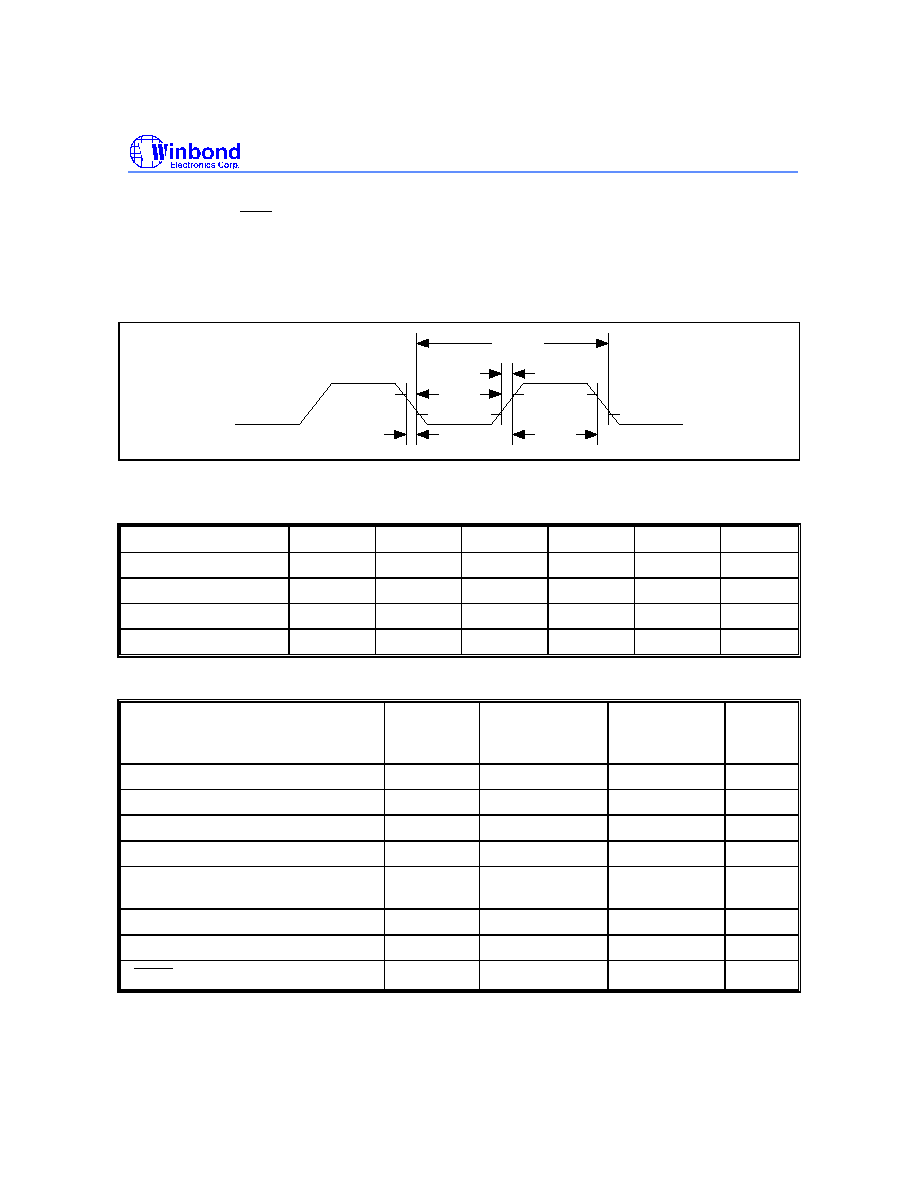
Preliminary W77E58
Publication Release Date: March 1999
- 77 - Revision A1
Notes:*1. RST pin is a Schmitt trigger input.
*2. P0, ALE and PSEN are tested in the external access mode.
*3. XTAL1 is a CMOS input.
*4. Pins of P1, P2, P3 can source a transition current when they are being externally driven from 1 to 0. The transition
current reaches its maximum value when VIN approximates to 2V.
AC ELECTRICAL CHARACTERISTICS
t
CLCL
t
CLCX
t
CHCX
t
CLCH
t
CHCL
Note: Duty cycle is 50%.
EXTERNAL CLOCK CHARACTERISTICS
PARAMETER
SYMBOL
MIN.
TYP
MAX.
UNITS
NOTES
Clock High Time
t
CHCX
12.5
-
-
ns
Clock Low Time
t
CLCX
12.5
-
-
ns
Clock Rise Time
t
CLCH
-
-
10
ns
Clock Fall Time
t
CHCL
-
-
10
ns
AC SPECIFICATION
PARAMETER
SYMBOL
VARIABLE
CLOCK
MIN
VARIABLE
CLOCK
MAX
UNITS
Oscillator Frequency
1/t
CLCL
0
40
MHz
ALE Pulse Width
t
LHLL
1.5t
CLCL
- 5
nS
Address Valid to ALE Low
t
AVLL
0.5t
CLCL
- 5
nS
Address Hold After ALE Low
t
LLAX1
0.5t
CLCL
- 5
nS
Address Hold After ALE Low for
MOVX Write
t
LLAX2
0.5t
CLCL
- 5
nS
ALE Low to Valid Instruction In
t
LLIV
2.5t
CLCL
- 20
nS
ALE Low to PSEN Low
t
LLPL
0.5t
CLCL
- 5
nS
PSEN
Pulse Width
t
PLPH
2.0t
CLCL
- 5
nS

Preliminary W77E58
- 78 -
AC Specification, continued
PARAMETER
SYMBOL
VARIABLE
CLOCK
MIN
VARIABLE
CLOCK
MAX
UNITS
PSEN
Low to Valid Instruction In
t
PLIV
2.0t
CLCL
- 20
nS
Input Instruction Hold After PSEN
t
PXIX
0
nS
Input Instruction Float After PSEN
t
PXIZ
t
CLCL
- 5
nS
Port 0 Address to Valid Instr. In
t
AVIV1
3.0t
CLCL
- 20
nS
Port 2 Address to Valid Instr. In
t
AVIV2
3.5t
CLCL
- 20
nS
PSEN
Low to Address Float
t
PLAZ
0
nS
Data Hold After Read
t
RHDX
0
nS
Data Float After Read
t
RHDZ
t
CLCL
- 5
nS
RD
Low to Address Float
t
RLAZ
0.5t
CLCL
- 5
nS
MOVX CHARACTERISTICS USING STRECH MEMORY CYCLES
PARAMETER
SYMBOL
VARIABLE
CLOCK
MIN
VARIABLE
CLOCK
MAX
UNITS
STRECH
Data Access ALE Pulse Width
t
LLHL2
1.5t
CLCL
- 5
2.0t
CLCL
- 5
nS
t
MCS
= 0
t
MCS
>0
Address Hold After ALE Low for
MOVX write
t
LLAX2
0.5t
CLCL
- 5
nS
RD
Pulse Width
t
RLRH
2.0t
CLCL
- 5
t
MCS
- 10
nS
t
MCS
= 0
t
MCS
>0
WR
Pulse Width
t
WLWH
2.0t
CLCL
- 5
t
MCS
- 10
nS
t
MCS
= 0
t
MCS
>0
RD
Low to Valid Data In
t
RLDV
2.0t
CLCL
- 20
t
MCS
- 20
nS
t
MCS
= 0
t
MCS
>0
Data Hold after Read
t
RHDX
0
nS
Data Float after Read
t
RHDZ
t
CLCL
- 5
2.0t
CLCL
- 5
nS
t
MCS
= 0
t
MCS
>0
ALE Low to Valid Data In
t
LLDV
2.5t
CLCL
- 5
t
MCS
+ 2t
CLCL
- 40
nS
t
MCS
= 0
t
MCS
>0
Port 0 Address to Valid Data In
t
AVDV1
3.0t
CLCL
- 20
2.0t
CLCL
- 5
nS
t
MCS
= 0
t
MCS
>0

Preliminary W77E58
Publication Release Date: March 1999
- 79 - Revision A1
Movx Characteristics Using Strech Memory Cycles, continued
PARAMETER
SYMBOL
VARIABLE
CLOCK
MIN
VARIABLE
CLOCK
MAX
UNITS
STRECH
ALE Low to
RD
or
WR
Low
t
LLWL
0.5t
CLCL
- 5
1.5t
CLCL
- 5
0.5t
CLCL
+ 5
1.5t
CLCL
+ 5
nS
t
MCS
= 0
t
MCS
>0
Port 0 Address to
RD
or
WR
Low
t
AVWL
t
CLCL
- 5
2.0t
CLCL
- 5
nS
t
MCS
= 0
t
MCS
>0
Port 2 Address to
RD
or
WR
Low
t
AVWL2
1.5t
CLCL
- 5
2.5t
CLCL
- 5
nS
t
MCS
= 0
t
MCS
>0
Data Valid to WR Transition
t
QVWX
-5
1.0t
CLCL
- 5
nS
t
MCS
= 0
t
MCS
>0
Data Hold after Write
t
WHQX
t
CLCL
- 5
2.0t
CLCL
- 5
nS
t
MCS
= 0
t
MCS
>0
RD
Low to Address Float
t
RLAZ
0.5t
CLCL
- 5
nS
RD
or WR high to ALE high
t
WHLH
0
1.0t
CLCL
- 5
10
1.0t
CLCL
+ 5
nS
t
MCS
= 0
t
MCS
>0
Note: t
MCS
is a time period related to the Stretch memory cycle selection. The following table shows the time period of t
MCS
for each selection of the Stretch value.
M2
M1
M0
MOVX Cycles
t
MCS
0
0
0
2 machine cycles
0
0
0
1
3 machine cycles
4 t
CLCL
0
1
0
4 machine cycles
8 t
CLCL
0
1
1
5 machine cycles
12 t
CLCL
1
0
0
6 machine cycles
16 t
CLCL
1
0
1
7 machine cycles
20 t
CLCL
1
1
0
8 machine cycles
24 t
CLCL
1
1
1
9 machine cycles
28 t
CLCL
EXPLANATION OF LOGIC SYMBOLS
In order to maintain compatibility with the original 8051 family, this device specifies the same
parameter for each device, using the same symbols. The explanation of the symbols is as follows.
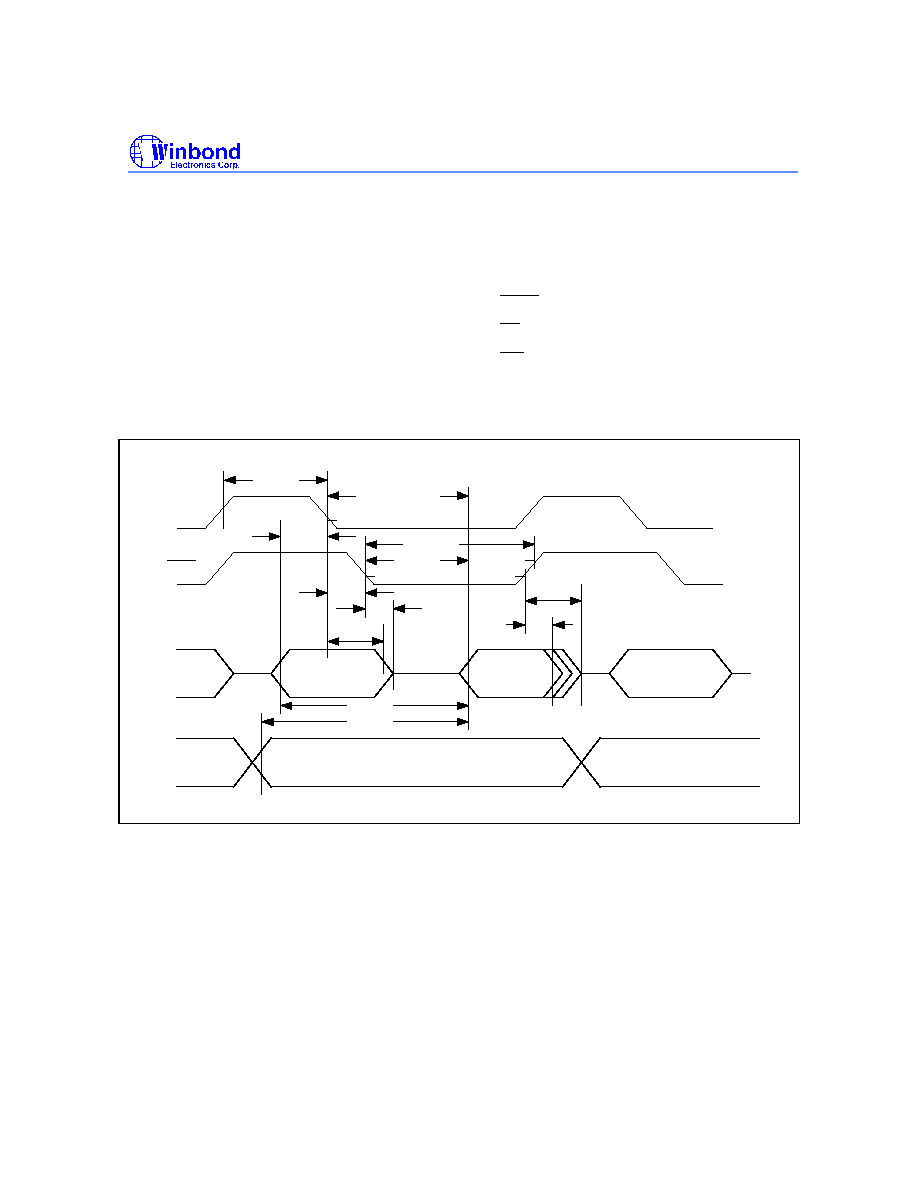
Preliminary W77E58
- 80 -
t
Time
A
Address
C
Clock
D
Input Data
H
Logic level high
L
Logic level low
I
Instruction
P
PSEN
Q
Output Data
R
RD
signal
V
Valid
W
WR
signal
X
No longer a valid state
Z
Tri-state
PROGRAM MEMORY READ CYCLE
t
LLAX1
t
PXIZ
t
PLAZ
t
LLPL
t
PXIX
t
PLIV
t
AVIV2
t
AVIV1
t
PLPH
t
AVLL
ADDRESS A8-A15
ADDRESS A8-A15
ADDRESS
A0-A7
INSTRUCTION
IN
ADDRESS
A0-A7
PORT 2
PORT 0
PSEN
ALE
t
LLIV
t
LHLL
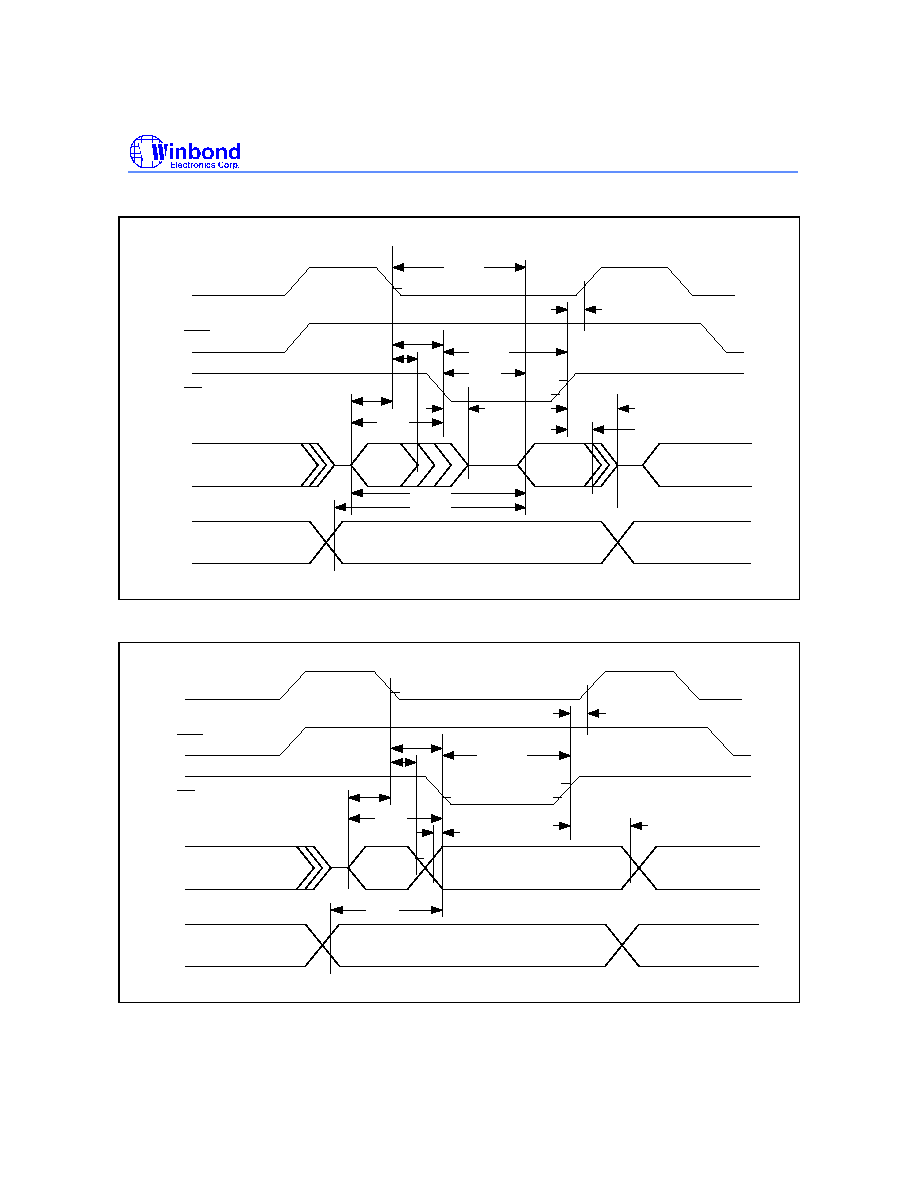
Preliminary W77E58
Publication Release Date: March 1999
- 81 - Revision A1
DATA MEMORY READ CYCLE
t
AVLL
t
AVWL1
t
LLAX1
t
WHLH
t
RLDV
t
RLRH
t
RLAZ
t
RHDZ
t
RHDX
t
AVDV2
t
AVDV1
t
LLWL
ADDRESS A8-A15
ADDRESS
A0-A7
INSTRUCTION
IN
DATA
IN
ADDRESS
A0-A7
PORT 2
PORT 0
PSEN
RD
ALE
t
LLDV
DATA MEMORY WRITE CYCLE
t
AVLL
t
AVWL1
t
LLAX2
t
WHLH
t
WLWH
t
QVWX
t
WHQX
t
AVDV2
t
LLWL
ADDRESS A8-A15
ADDRESS
A0-A7
INSTRUCTION
IN
DATA OUT
ADDRESS
A0-A7
PORT 2
PORT 0
PSEN
WR
ALE

Preliminary W77E58
- 82 -
TYPICAL APPLICATION CIRCUITS
Expanded External Program Memory and Crystal
AD0
A0
A0
A0
10
A1
9
A2
8
A3
7
A4
6
A5
5
A6
4
A7
3
A8
25
A9
24
A10
21
A11
23
A12
2
A13
26
A14
27
A15
1
CE
20
OE
22
O0
11
O1
12
O2
13
O3
15
O4
16
O5
17
O6
18
O7
19
27512
AD0
D0
3
Q0
2
D1
4
Q1
5
D2
7
Q2
6
D3
8
Q3
9
D4
13
Q4
12
D5
14
Q5
15
D6
17
Q6
16
D7
18
Q7
19
OC
1
G
11
74F373
AD0
EA
31
XTAL1
19
XTAL2
18
RST
9
INT0
12
INT1
13
T0
14
T1
15
P1.0
1
P1.1
2
P1.2
3
P1.3
4
P1.4
5
P1.5
6
P1.6
7
P1.7
8
39
38
37
36
35
34
33
32
21
22
23
24
25
26
27
28
17
WR
P0.0
P0.1
P0.2
P0.3
P0.4
P0.5
P0.6
P0.7
P2.0
P2.1
P2.2
P2.3
P2.4
P2.5
P2.6
P2.7
RD
16
PSEN
29
ALE
30
TXD
11
RXD
10
W77E58
10 u
8.2 K
CC
CRYSTAL
C1
C2
R
AD1
AD2
AD3
AD4
AD5
AD6
AD7
A8
AD1
AD2
AD3
AD4
AD5
AD6
AD7
GND
A1
A2
A3
A4
A5
A6
A7
A1
A2
A3
A4
A5
A6
A7
A8
A9
AD1
AD2
AD3
AD4
AD5
AD6
AD7
A10
A11
A12
A13
A14
A15
GND
A9
A10
A11
A12
A13
A14
A15
V
CC
V
Figure A
CRYSTAL
C1
C2
R
16 MHz
30P
30P
-
24 MHz
15P
15P
-
33 MHz
10P
10P
1.8K
40 MHz
1P
1P
2.4K
The above table shows the reference values for crystal applications.
Note:C1, C2, R components refer to Figure A.
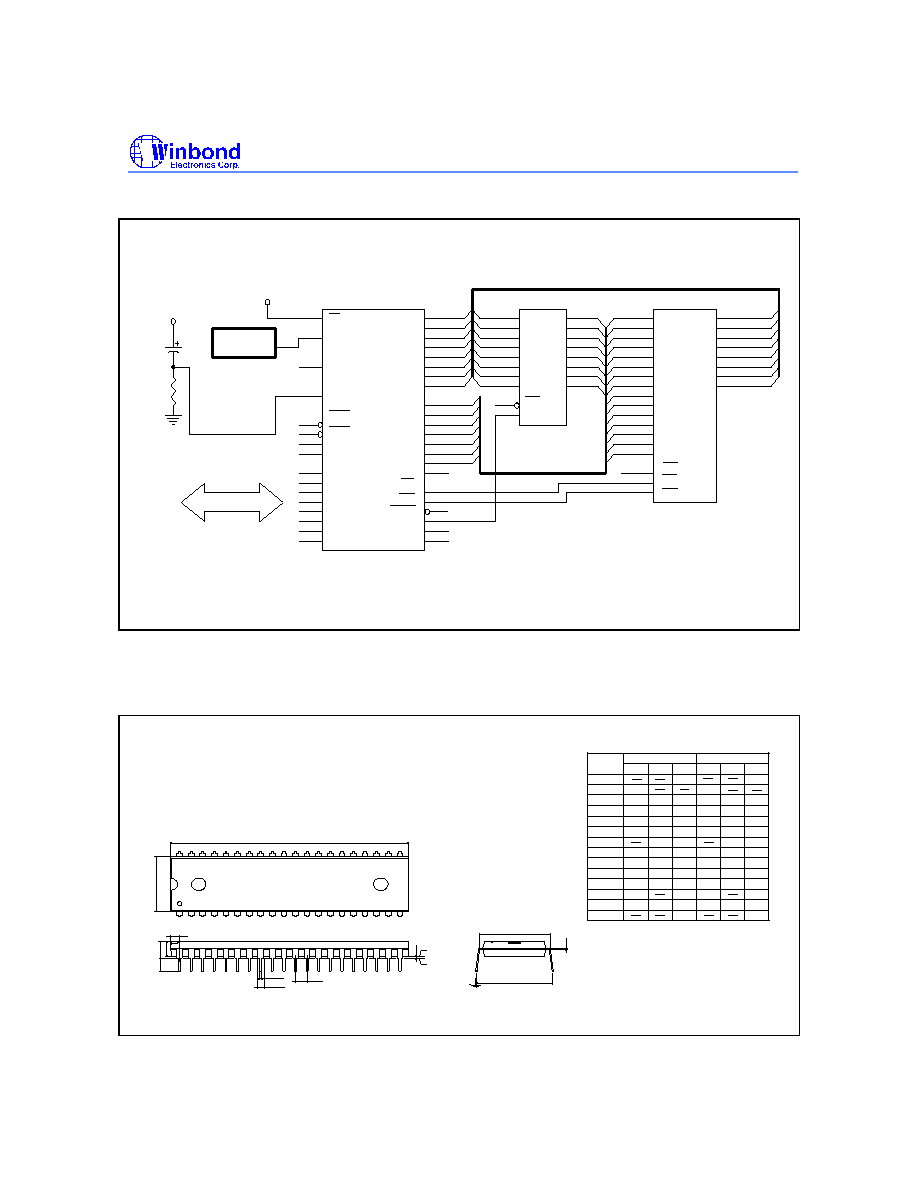
Preliminary W77E58
Publication Release Date: March 1999
- 83 - Revision A1
Expanded External Data Memory and Oscillator
10 u
8.2 K
CC
OSCILLATOR
EA
31
XTAL1
19
XTAL2
18
RST
9
INT0
12
INT1
13
T0
14
T1
15
1
2
3
4
5
6
P1.0
P1.1
P1.2
P1.3
P1.4
P1.5
P1.6
7
P1.7
8
P0.0
39
P0.1
38
P0.2
37
P0.3
36
P0.4
35
P0.5
34
P0.6
33
P0.7
32
P2.0
21
P2.1
22
P2.2
23
P2.3
24
P2.4
25
P2.5
26
P2.6
27
P2.7
28
RD
17
WR
16
PSEN
29
ALE
30
TXD
11
RXD
10
W77E58
AD0
AD1
AD2
AD3
AD4
AD5
AD6
AD7
AD0
AD1
AD2
AD3
AD4
AD5
AD6
AD7
A0
A1
A2
A3
A4
A5
A6
A7
D0
3
Q0 2
D1
4
Q1 5
D2
7
Q2 6
D3
8
Q3 9
D4
13
Q4 12
D5
14
Q5 15
D6
17
Q6 16
D7
18
Q7 19
OC
1
G
11
74F373
A0
A1
A2
A3
A4
A5
A6
A7
10
9
8
7
6
5
4
3
A0
A1
A2
A3
A4
A5
A6
A7
AD0
AD1
AD2
AD3
AD4
AD5
AD6
AD7
11
12
13
15
16
17
18
19
D0
D1
D2
D3
D4
D5
D6
D7
A8
A9
A10
A11
A12
A13
A14
25
24
21
23
26
1
20
2
A8
A9
A10
A11
A12
A13
A14
CE
GND
A8
A9
A10
A11
A12
A13
A14
GND
22
27
OE
WR
20256
V
CC
V
Figure B
PACKAGE DIMENSIONS
40-pin DIP
Seating Plane
1. Dimension D Max. & S include mold flash or
tie bar burrs.
2. Dimension E1 does not include interlead flash.
3. Dimension D & E1 include mold mismatch and
are determined at the mold parting line.
6. General appearance spec. should be based on
final visual inspection spec.
.
1.372
1.219
0.054
0.048
Notes:
Symbol
Min.
Nom.
Max.
Max.
Nom.
Min.
Dimension in inches
Dimension in mm
A
B
c
D
e
A
L
S
A
A
1
2
E
0.050
1.27
0.210
5.334
0.010
0.150
0.016
0.155
0.018
0.160
0.022
3.81
0.406
0.254
3.937
0.457
4.064
0.559
0.008
0.120
0.670
0.010
0.130
0.014
0.140
0.203
3.048
0.254
3.302
0.356
3.556
0.540
0.550
0.545
13.72
13.97
13.84
17.01
15.24
14.986
15.494
0.600
0.590
0.610
2.286
2.54
2.794
0.090
0.100
0.110
B
1
1
e
E
1
a
2.055
2.070
52.20
52.58
0
15
0.090
2.286
0.650
0.630
16.00
16.51
protrusion/intrusion.
4. Dimension B1 does not include dambar
5. Controlling dimension: Inches.
15
0
e
A
A
a
c
E
Base Plane
1
A
1
e
L
A
S
1
E
D
1
B
B
40
21
20
1
2
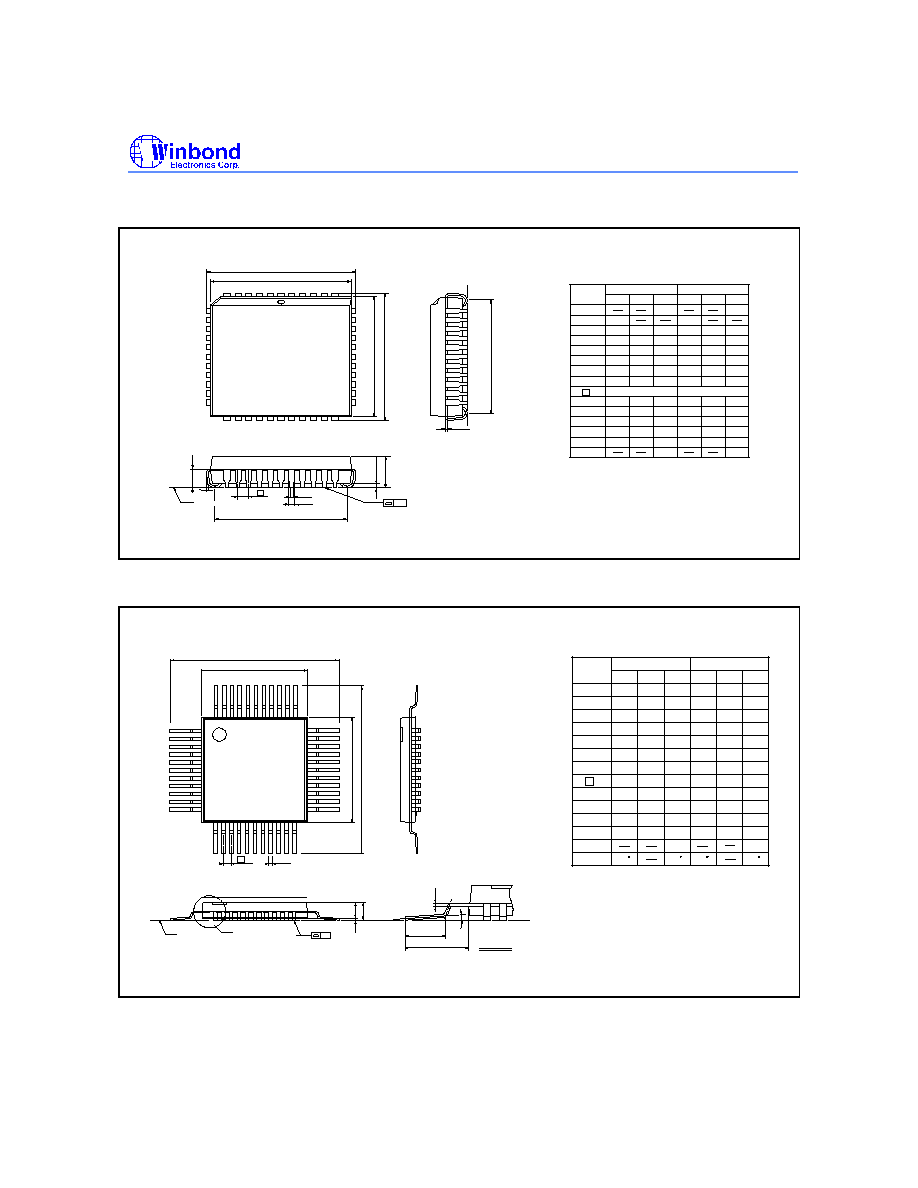
Preliminary W77E58
- 84 -
44-pin PLCC
44
40
39
29
28
18
17
7
6
1
L
c
1
b
2
A
H
D
D
e
b
E
H
E
y
A
A
1
Seating Plane
D
G
G
E
Symbol
Min.
Nom.
Max.
Max.
Nom.
Min.
Dimension in inches
Dimension in mm
A
b
c
D
e
H
E
L
y
A
A
1
2
E
b
1
H
D
G
G
D
E
Notes:
on final visual inspection spec.
4. General appearance spec. should be based
3. Controlling dimension: Inches
protrusion/intrusion.
2. Dimension b1 does not include dambar
flash.
1. Dimension D & E do not include interlead
0.020
0.145
0.026
0.016
0.008
0.648
0.590
0.680
0.090
0.150
0.028
0.018
0.010
0.653
0.610
0.690
0.100
0.050
BSC
0.185
0.155
0.032
0.022
0.014
0.658
0.630
0.700
0.110
0.004
0.508
3.683
0.66
0.406
0.203
16.46
14.99
17.27
2.296
3.81
0.711
0.457
0.254
16.59
15.49
17.53
2.54
1.27
4.699
3.937
0.813
0.559
0.356
16.71
16.00
17.78
2.794
0.10
BSC
16.71
16.59
16.46
0.658
0.653
0.648
16.00
15.49
14.99
0.630
0.610
0.590
17.78
17.53
17.27
0.700
0.690
0.680
44-pin QFP
Seating Plane
11
22
12
See Detail F
e
b
A
y
1
A
A
L
L
1
c
E
E
H
1
D
44
H
D
34
33
Detail F
1. Dimension D & E do not include interlead
flash.
2. Dimension b does not include dambar
protrusion/intrusion.
3. Controlling dimension: Millimeter
4. General appearance spec. should be based
on final visual inspection spec.
0.254
0.101
0.010
0.004
Notes:
Symbol
Min.
Nom.
Max.
Max.
Nom.
Min.
Dimension in inch
Dimension in mm
A
b
c
D
e
H
D
H
E
L
y
A
A
L
1
1
2
E
0.006
0.152
---
0.002
0.075
0.01
0.081
0.014
0.087
0.018
1.90
0.25
0.05
2.05
0.35
2.20
0.45
0.390
0.025
0.063
0.003
0
7
0.394
0.031
0.398
0.037
9.9
0.80
0.65
1.6
10.00
0.8
10.1
0.95
0.398
0.394
0.390
0.530
0.520
0.510
13.45
13.2
12.95
10.1
10.00
9.9
7
0
0.08
0.031
0.01
0.02
0.25
0.5
---
---
---
---
---
2
0.025
0.036
0.635
0.952
0.530
0.520
0.510
13.45
13.2
12.95
0.051
0.075
1.295
1.905

Preliminary W77E58
Publication Release Date: March 1999
- 85 - Revision A1
Headquarters
No. 4, Creation Rd. III,
Science-Based Industrial Park,
Hsinchu, Taiwan
TEL: 886-3-5770066
FAX: 886-3-5792697
http://www.winbond.com.tw/
Voice & Fax-on-demand: 886-2-7197006
Taipei Office
11F, No. 115, Sec. 3, Min-Sheng East Rd.,
Taipei, Taiwan
TEL: 886-2-7190505
FAX: 886-2-7197502
Winbond Electronics (H.K.) Ltd.
Rm. 803, World Trade Square, Tower II,
123 Hoi Bun Rd., Kwun Tong,
Kowloon, Hong Kong
TEL: 852-27513100
FAX: 852-27552064
Winbond Electronics North America Corp.
Winbond Memory Lab.
Winbond Microelectronics Corp.
Winbond Systems Lab.
2727 N. First Street, San Jose,
CA 95134, U.S.A.
TEL: 408-9436666
FAX: 408-5441798
Note: All data and specifications are subject to change without notice.




















































































